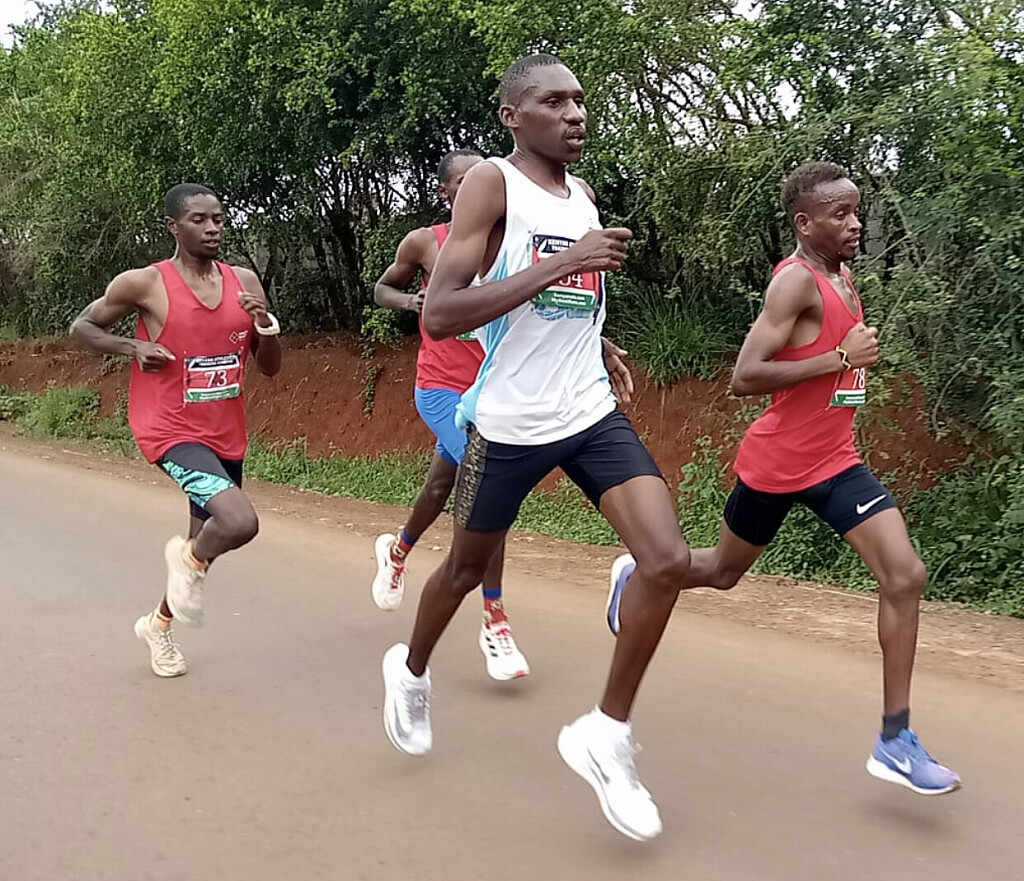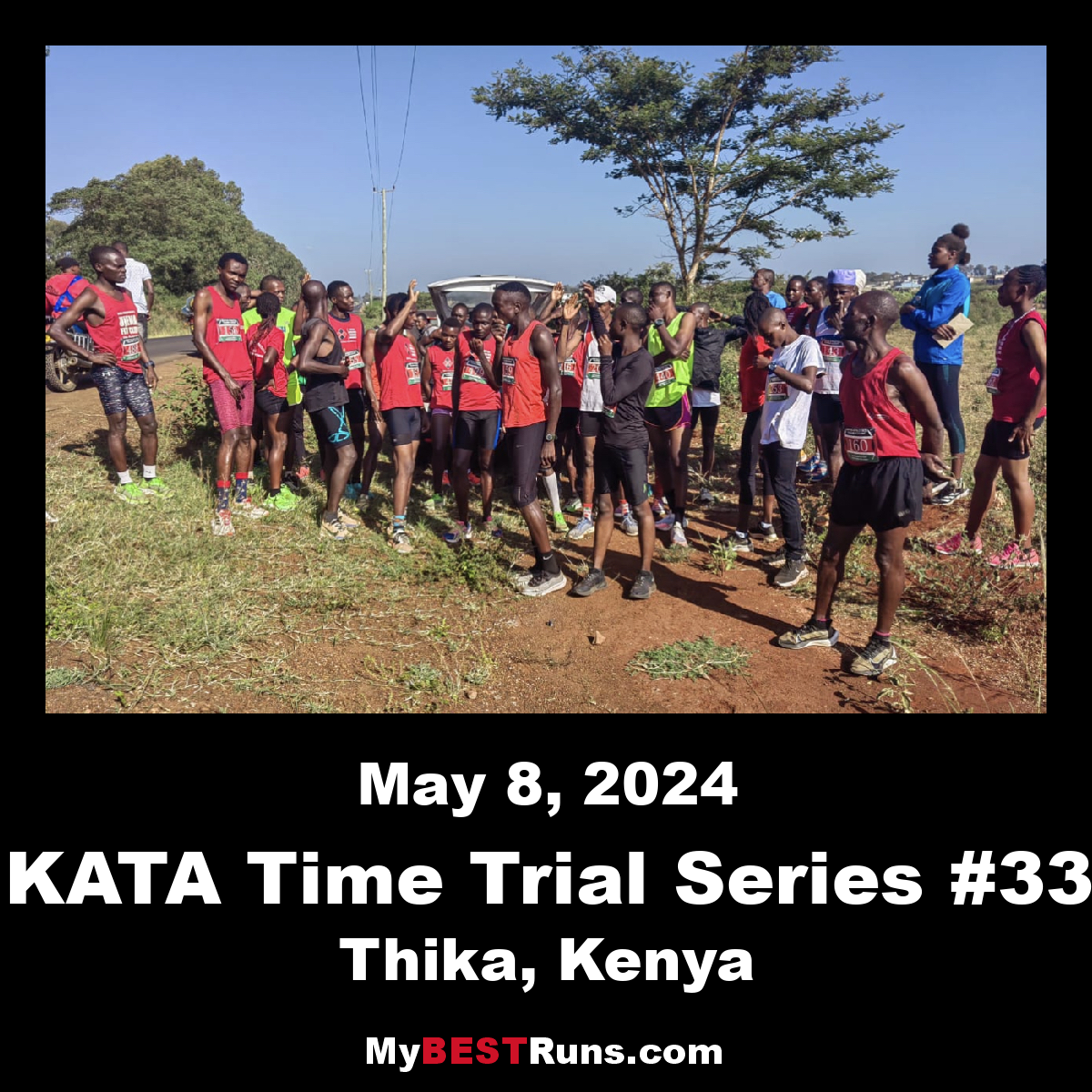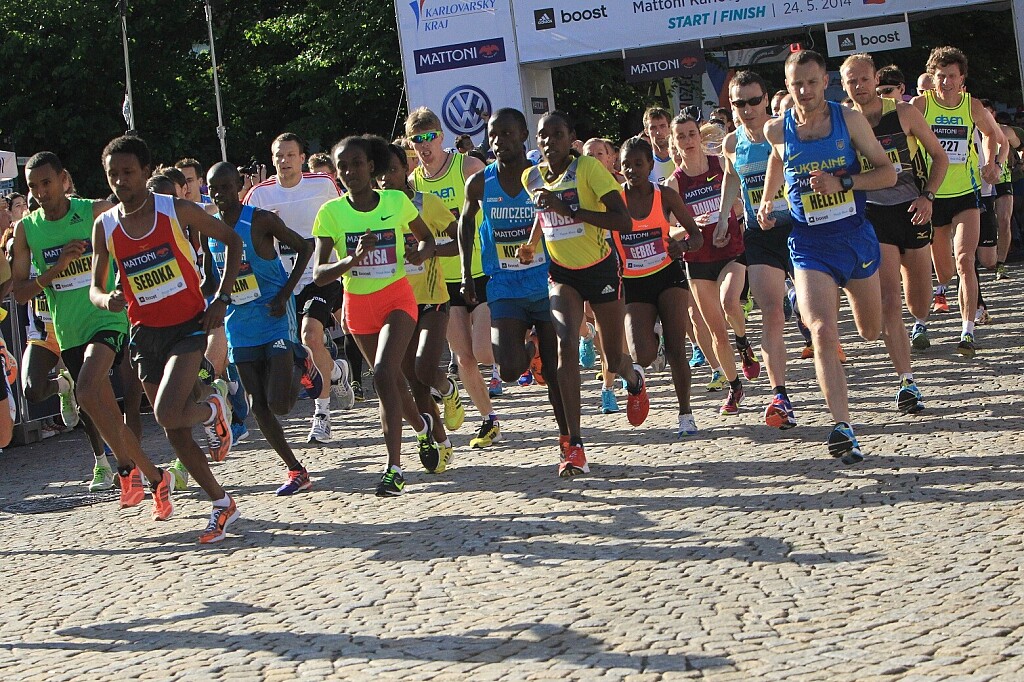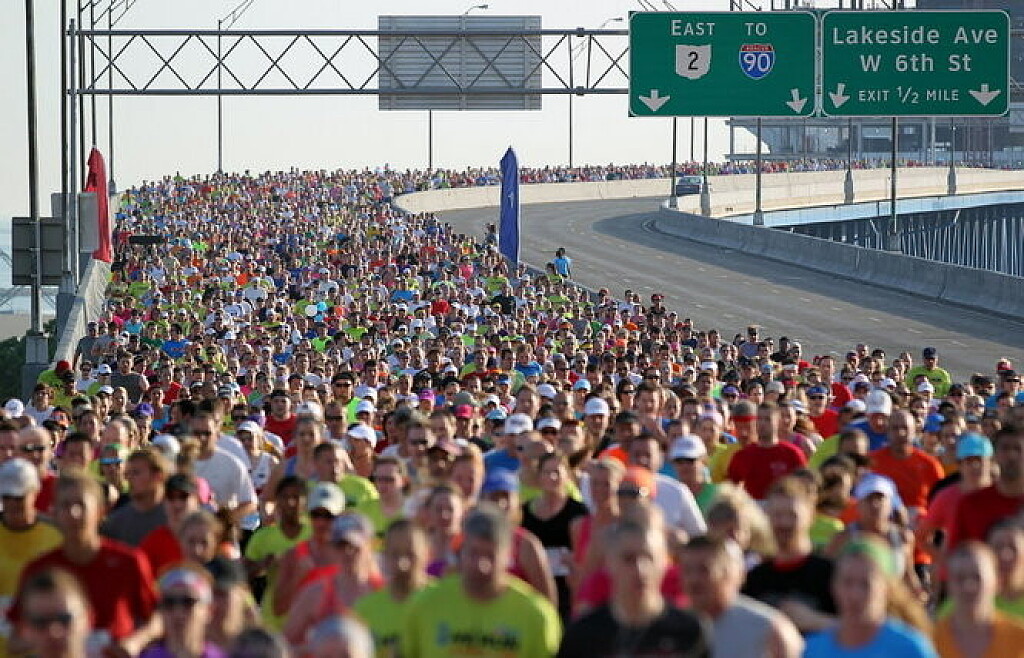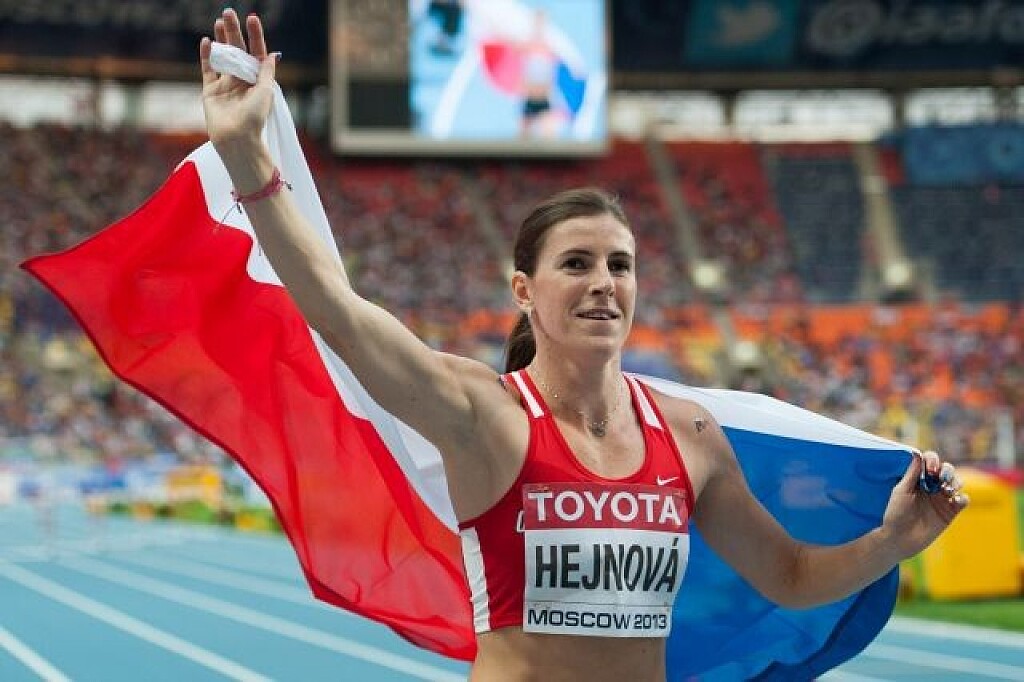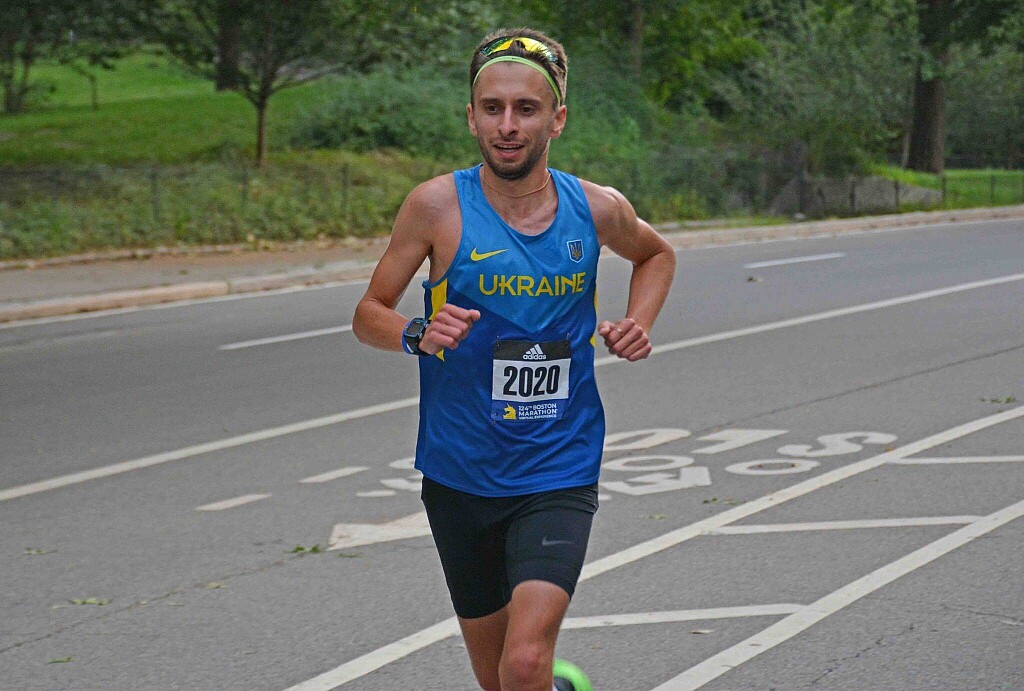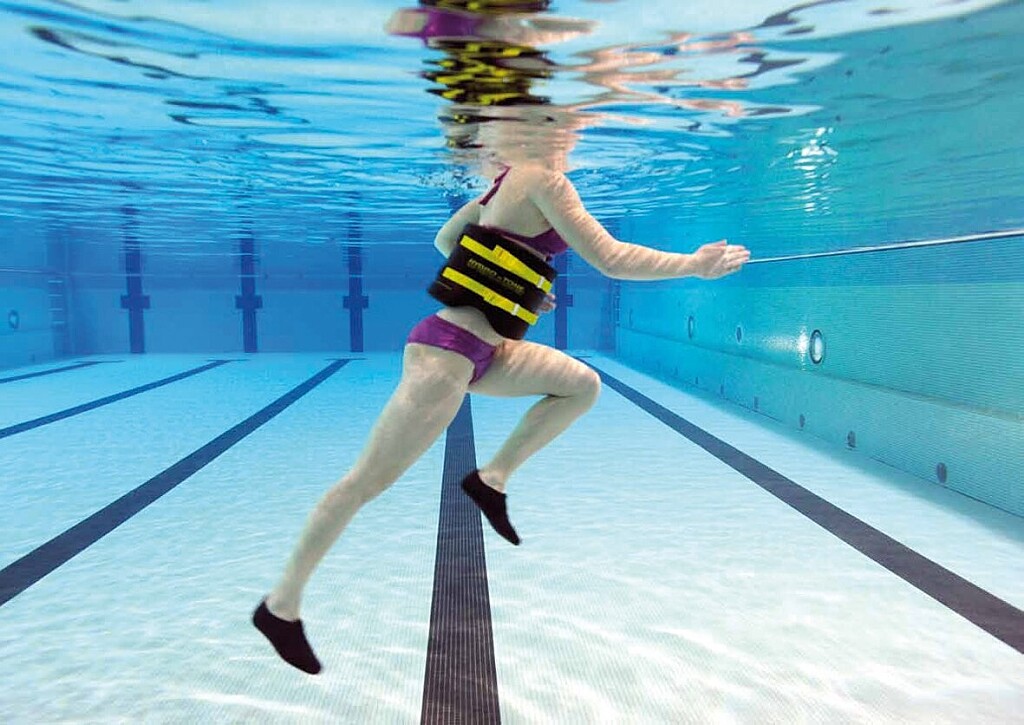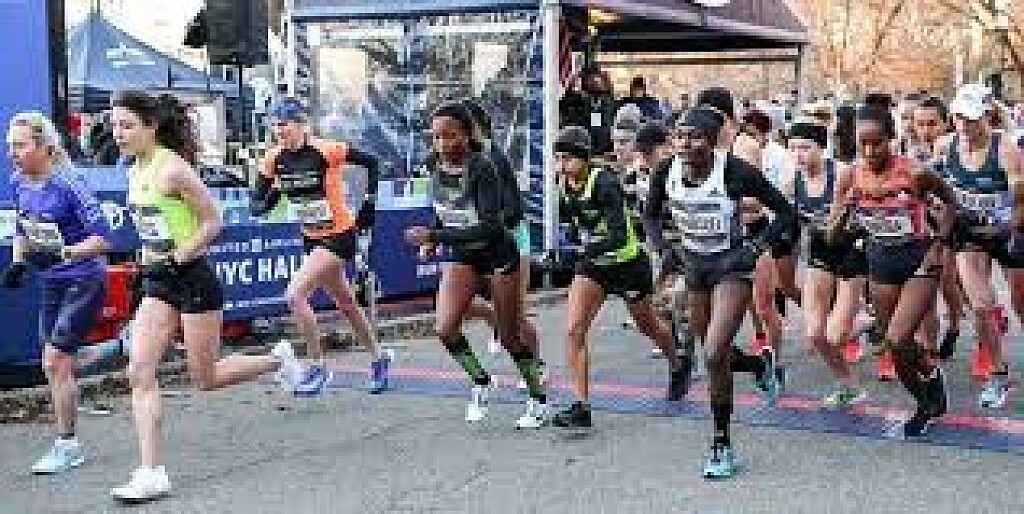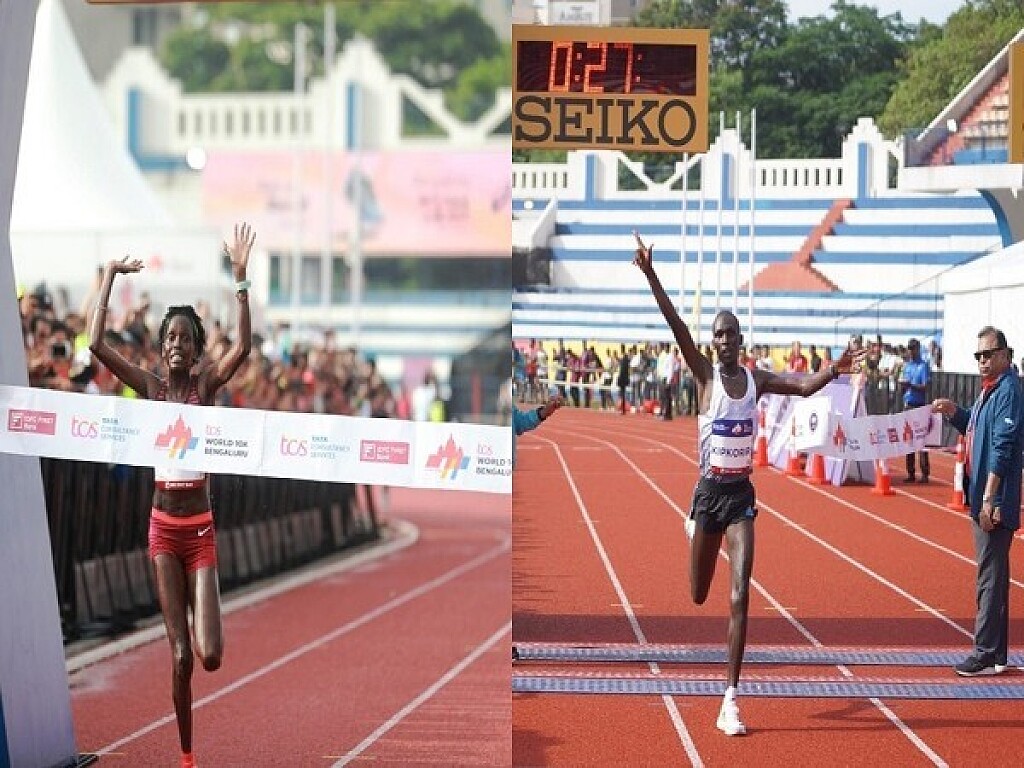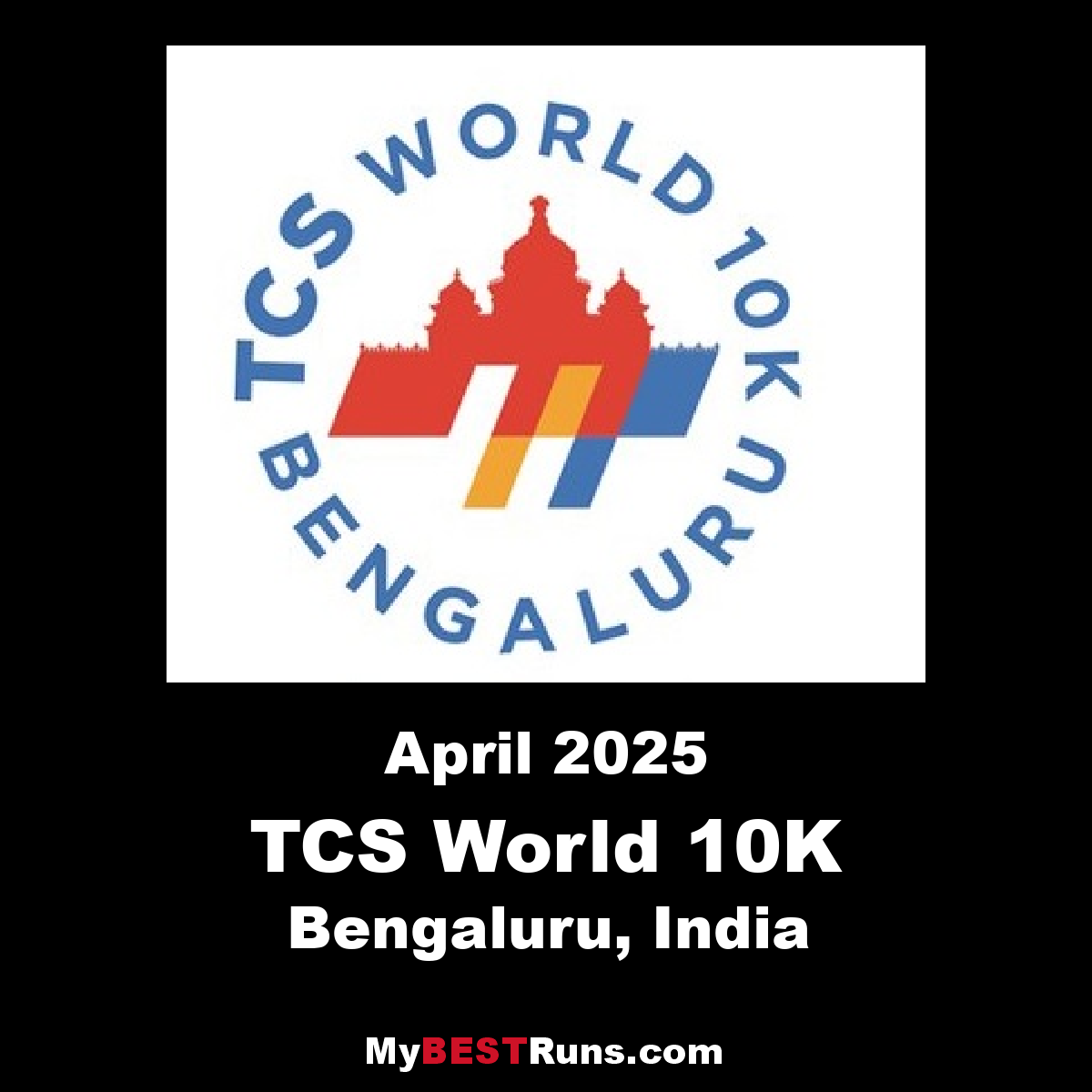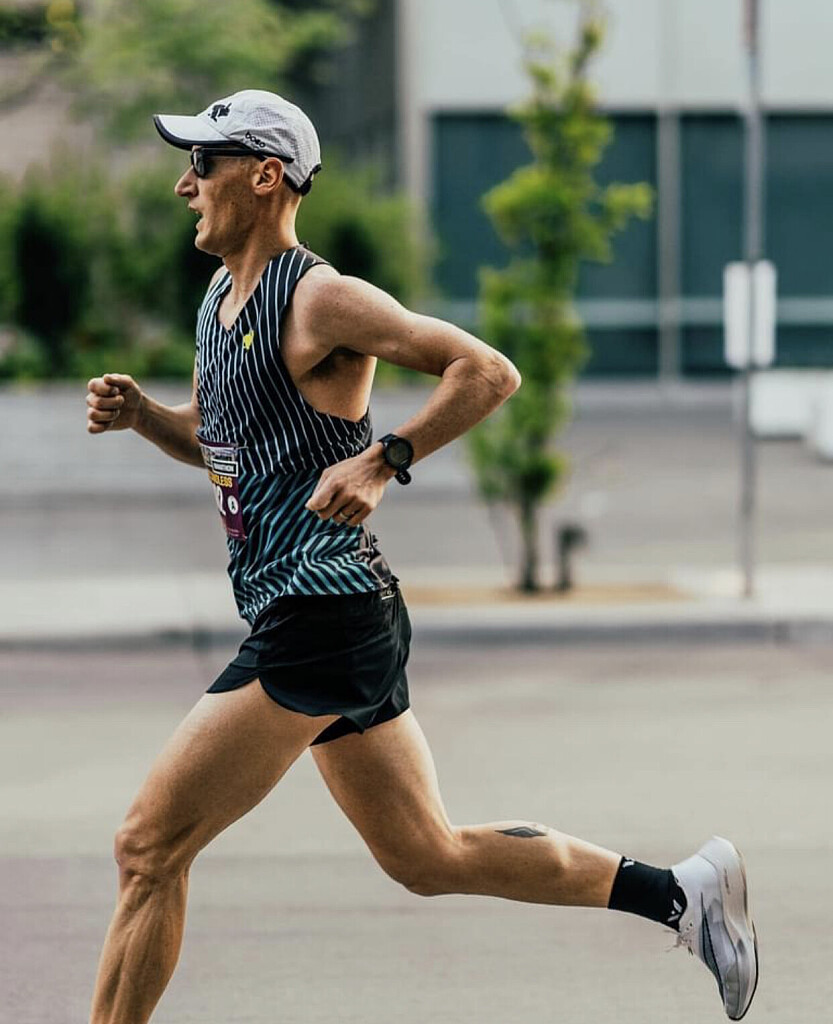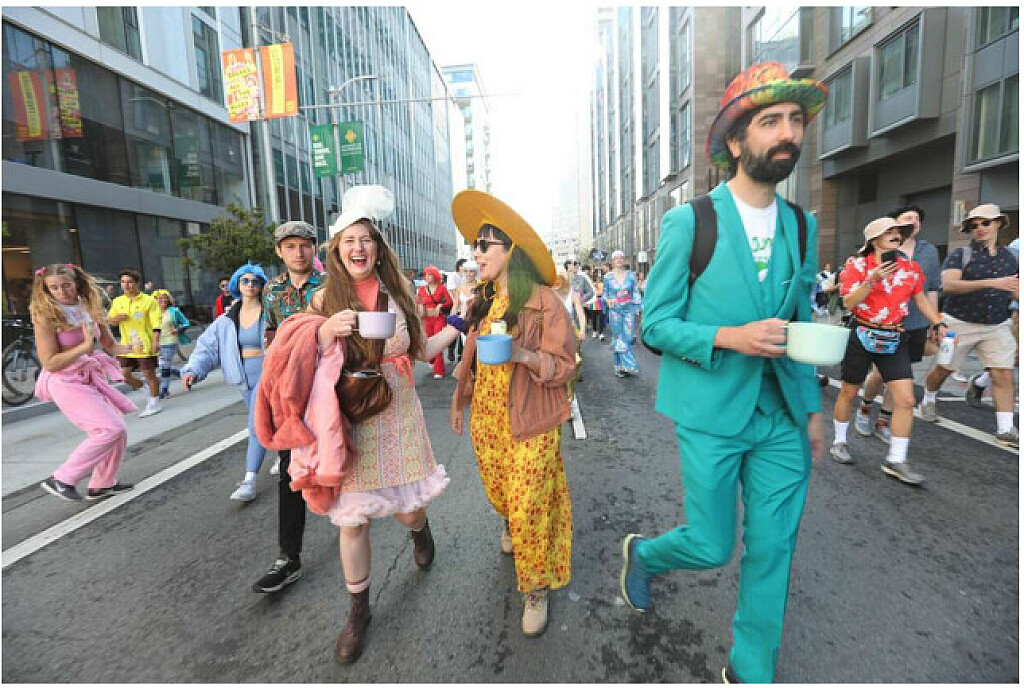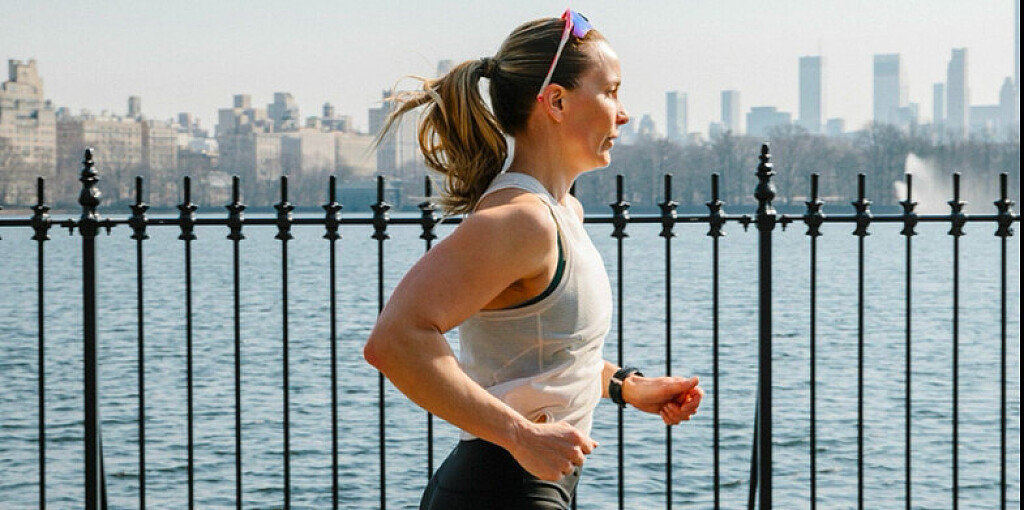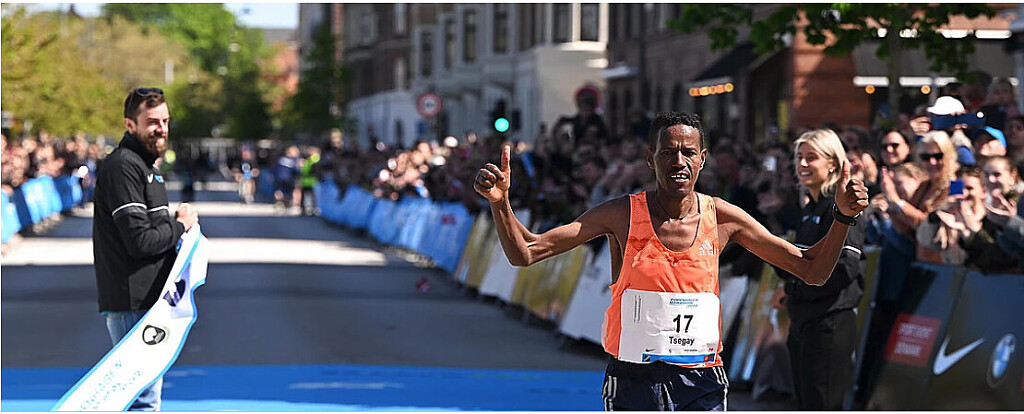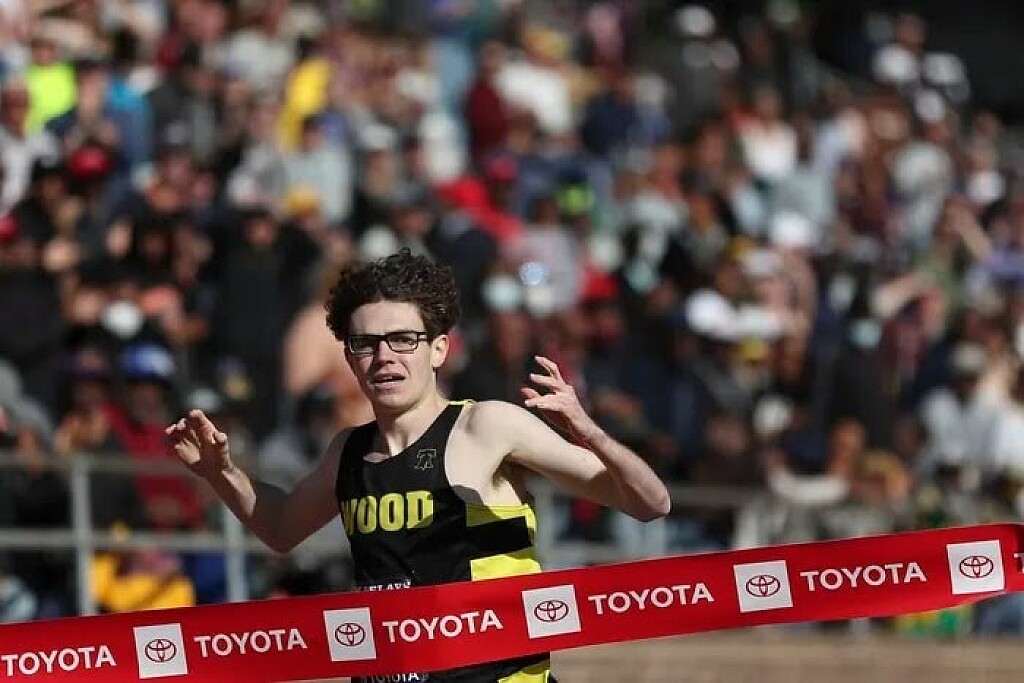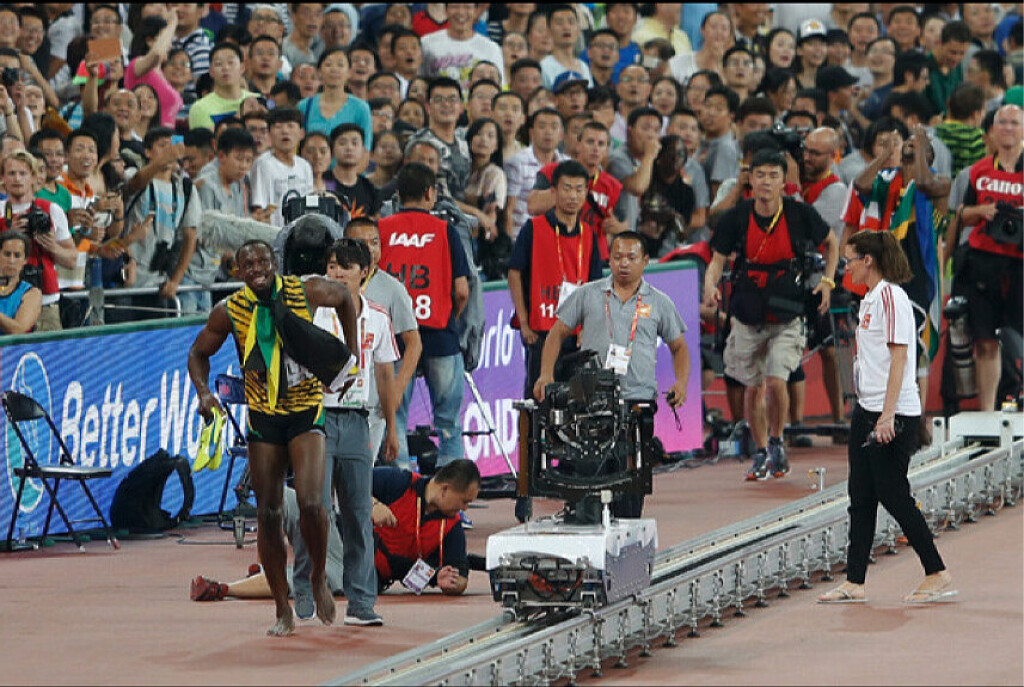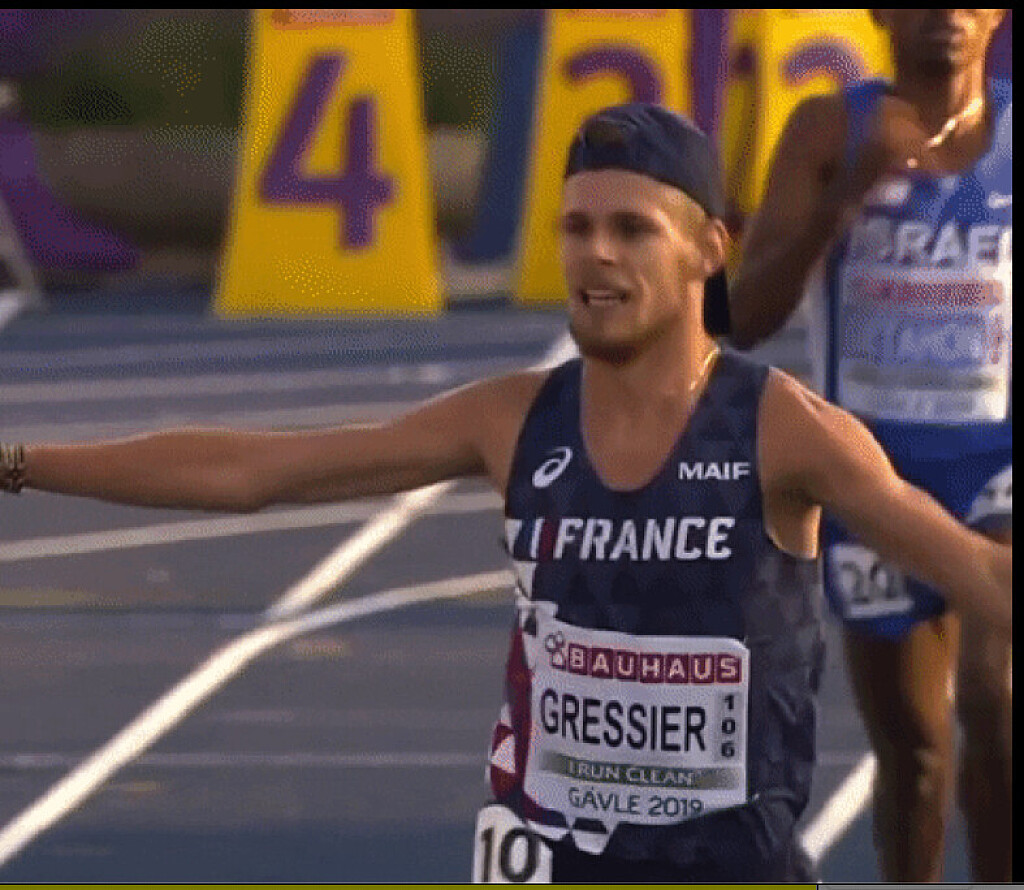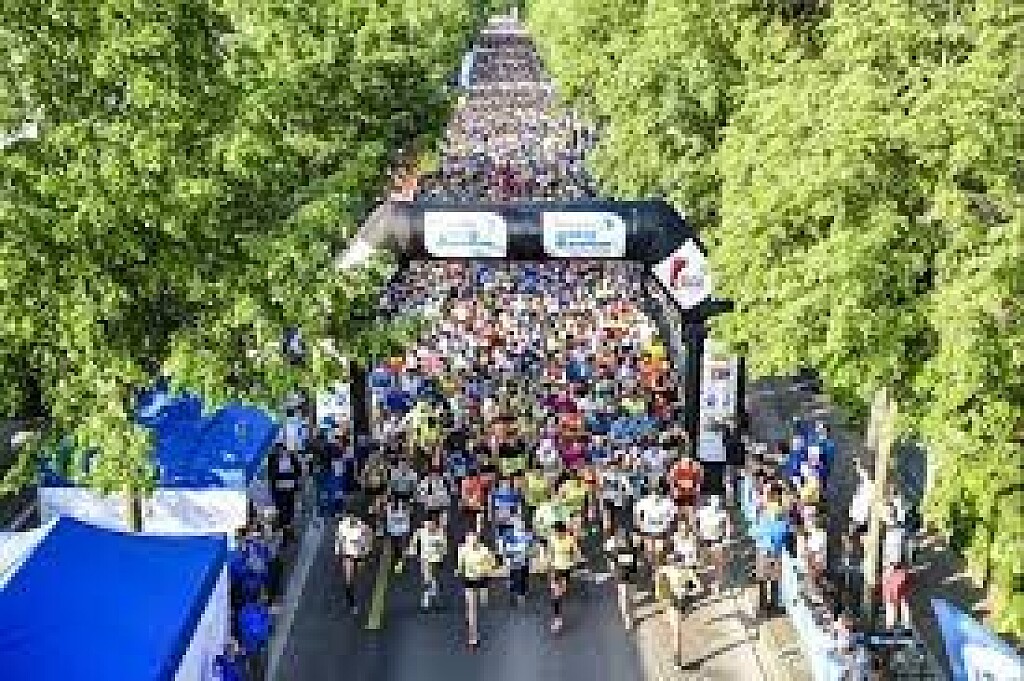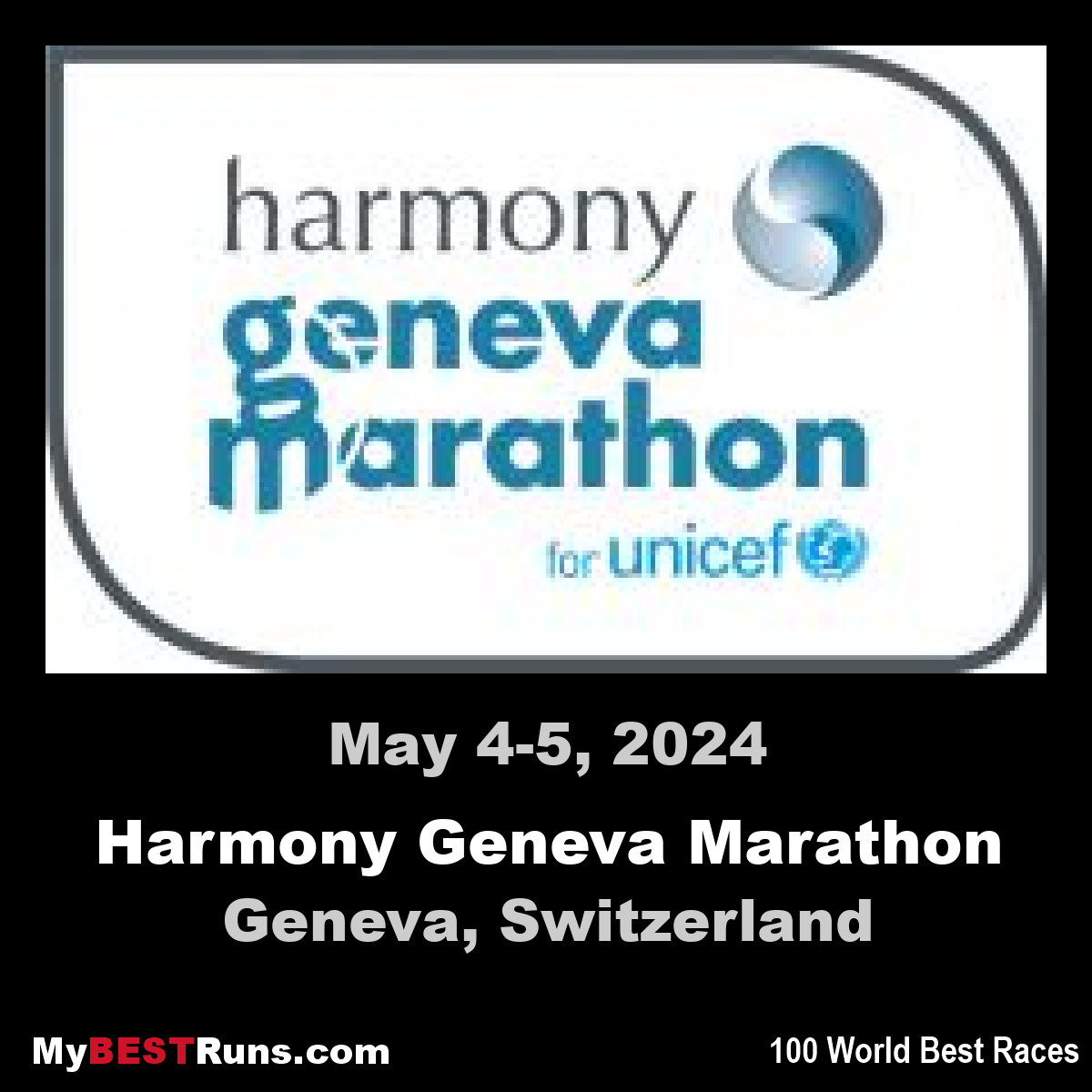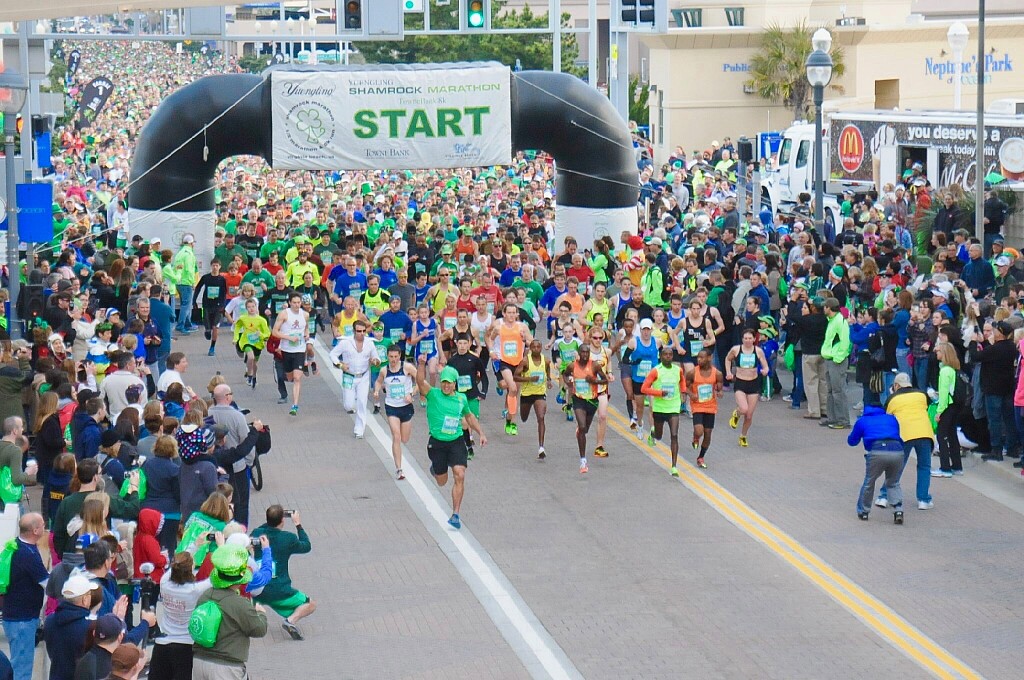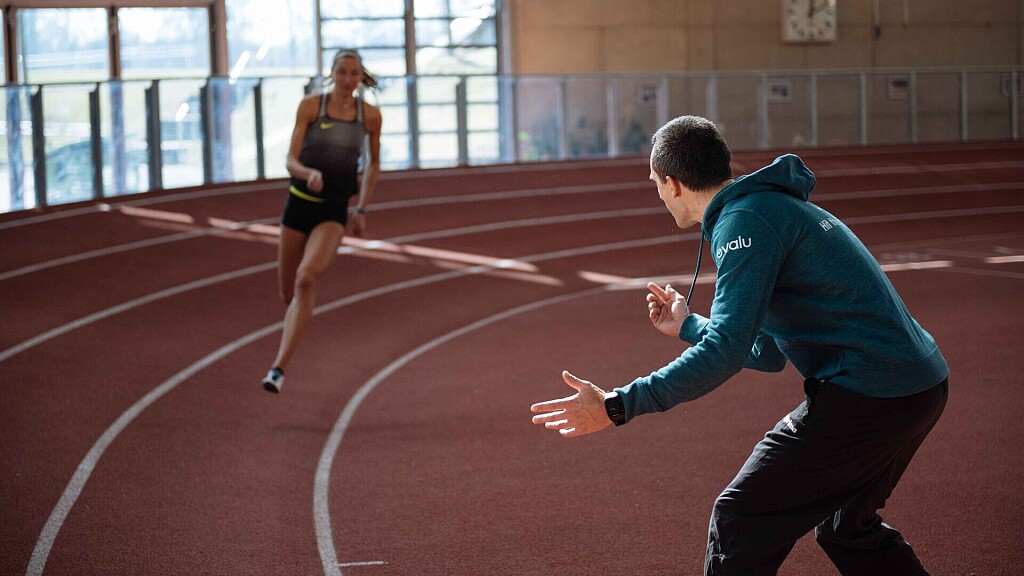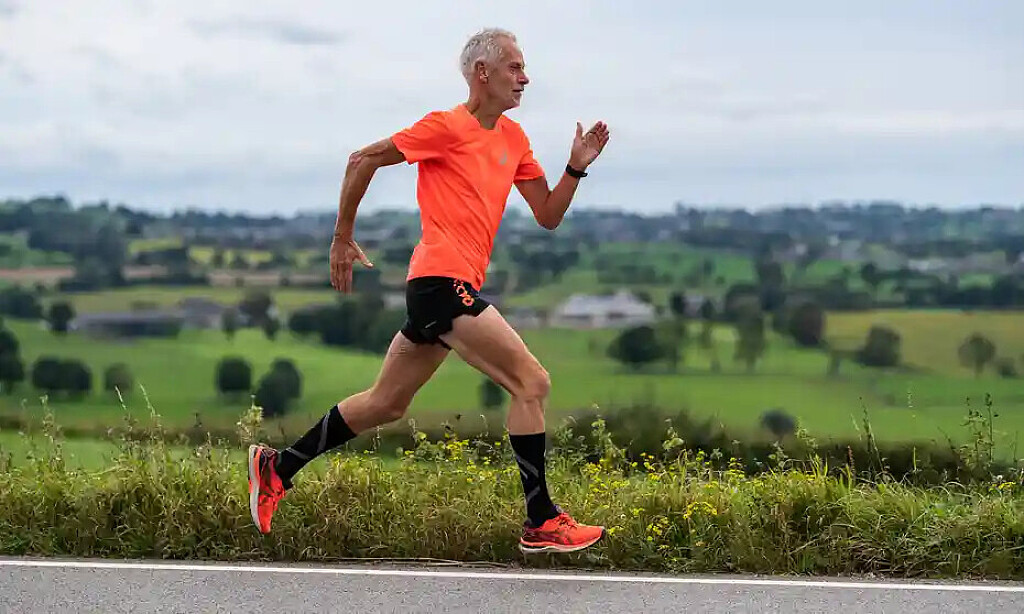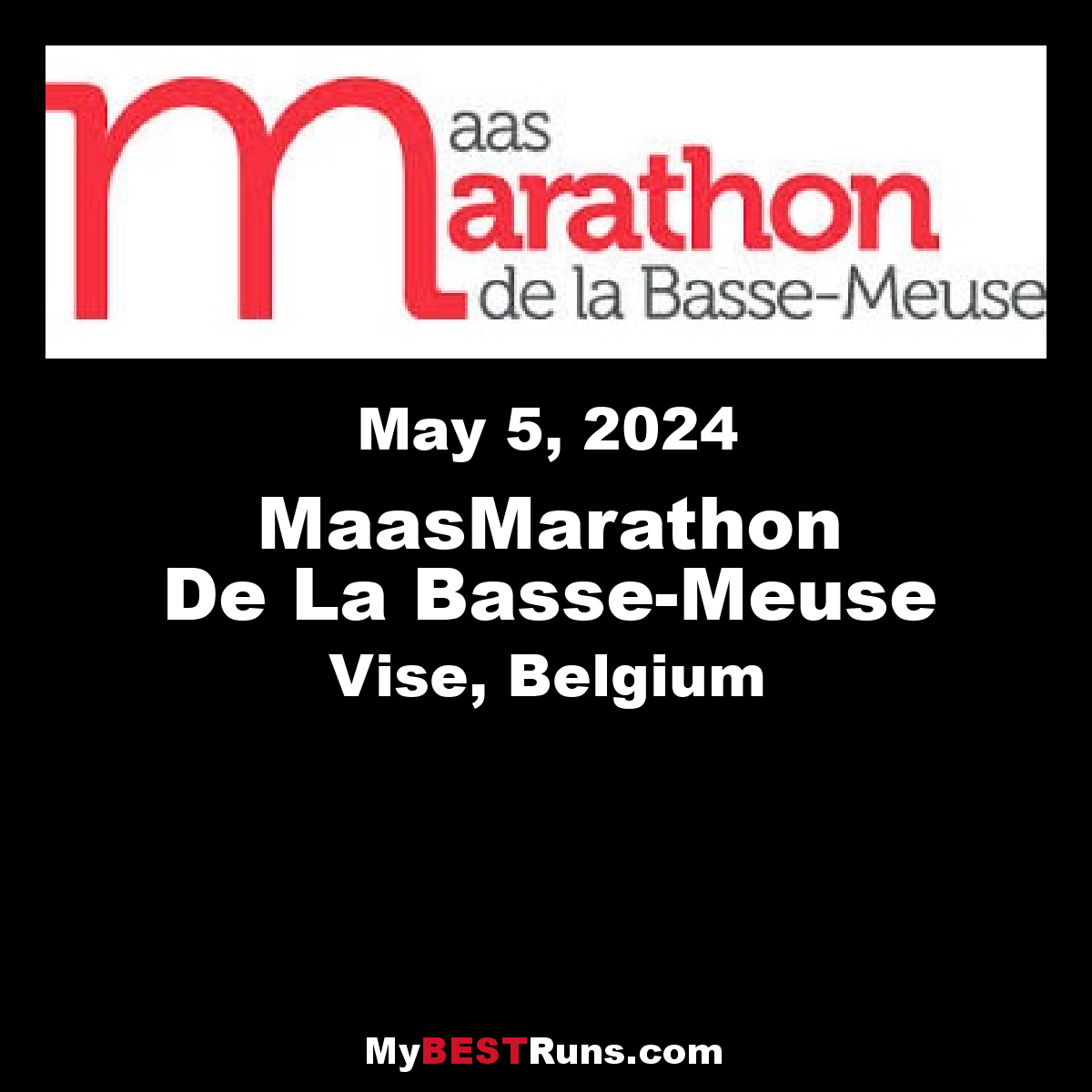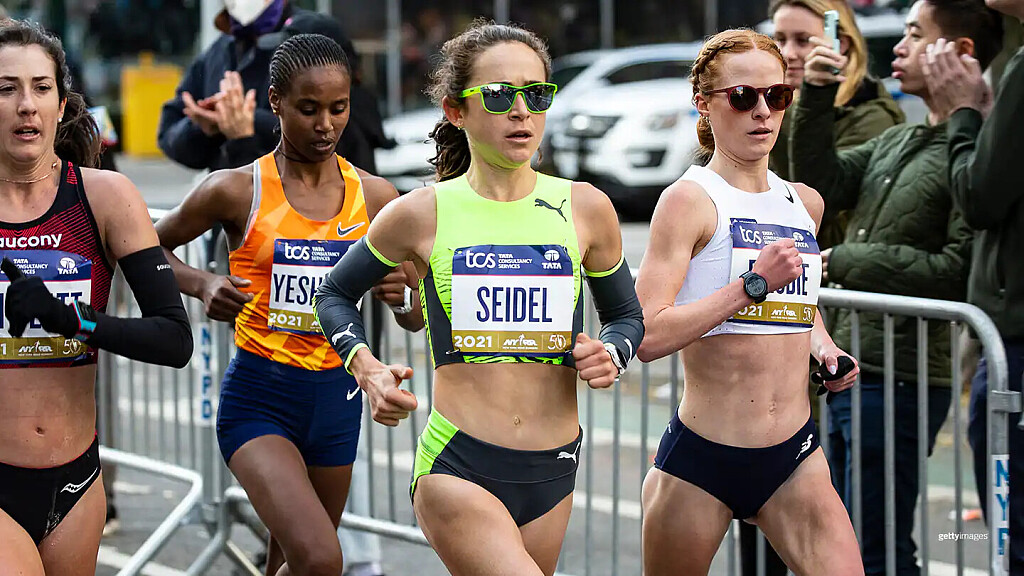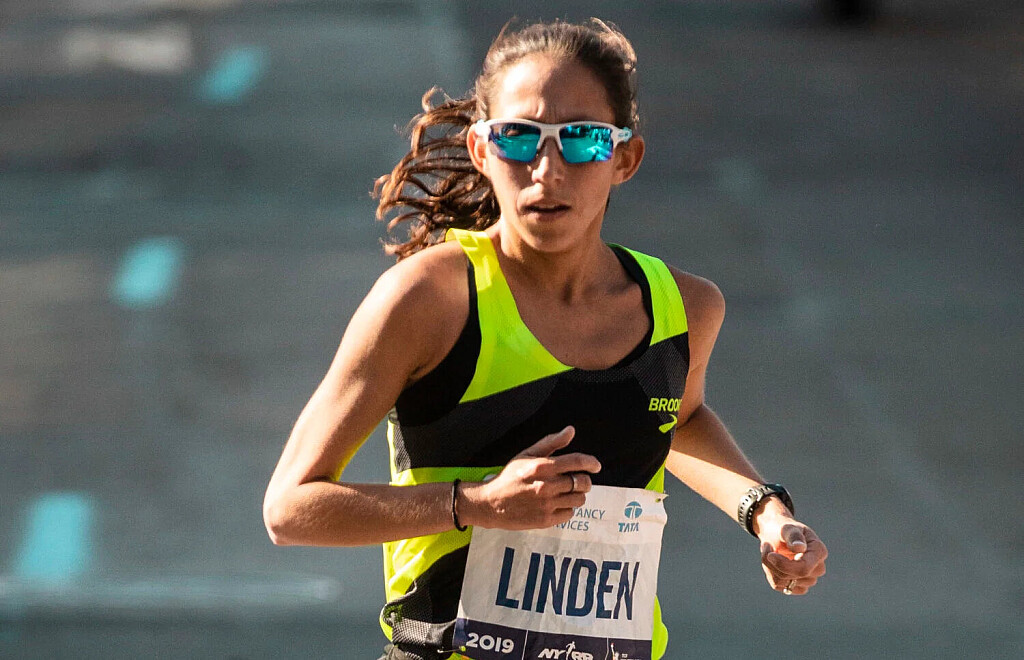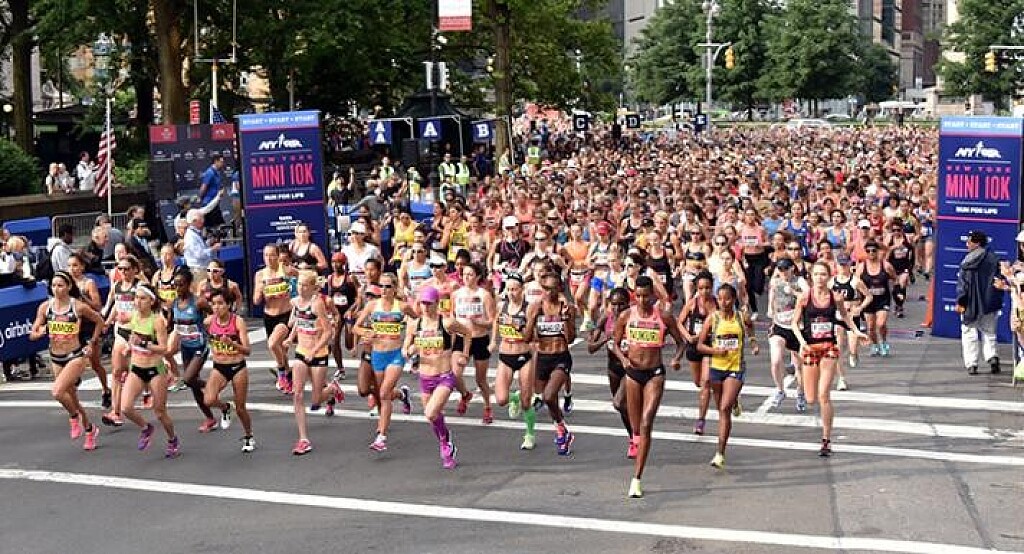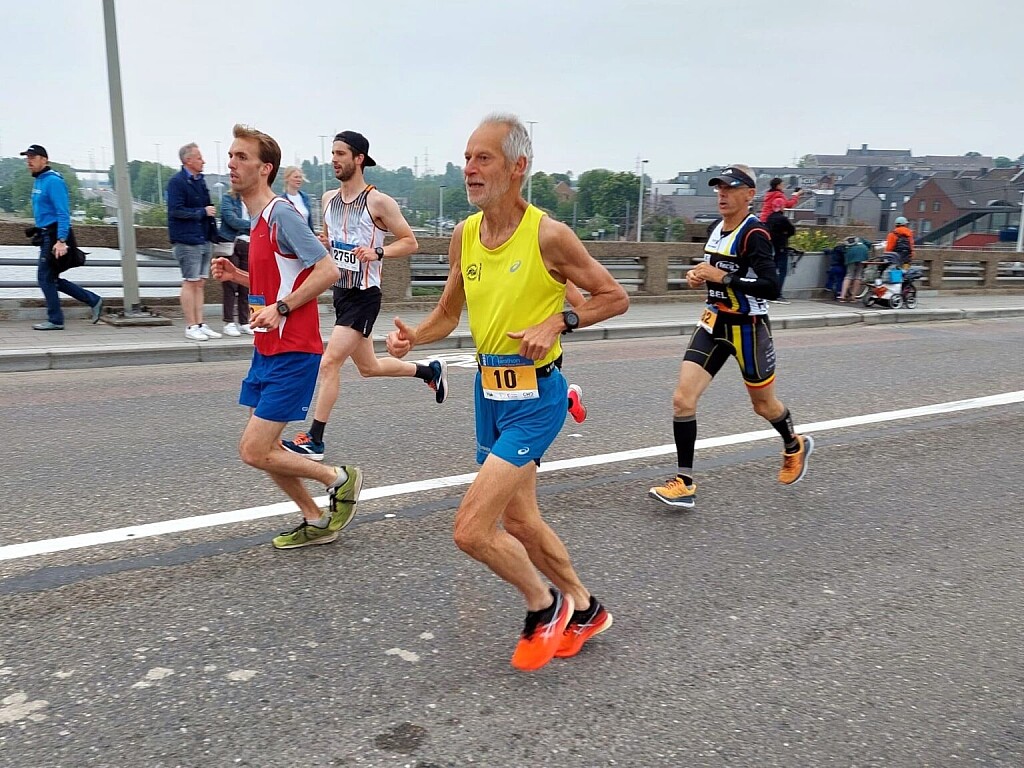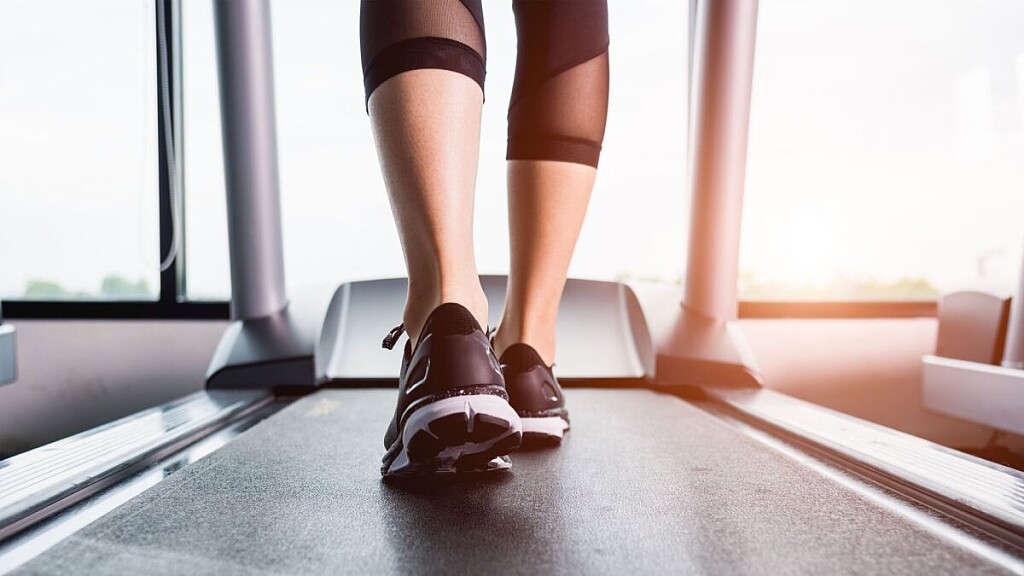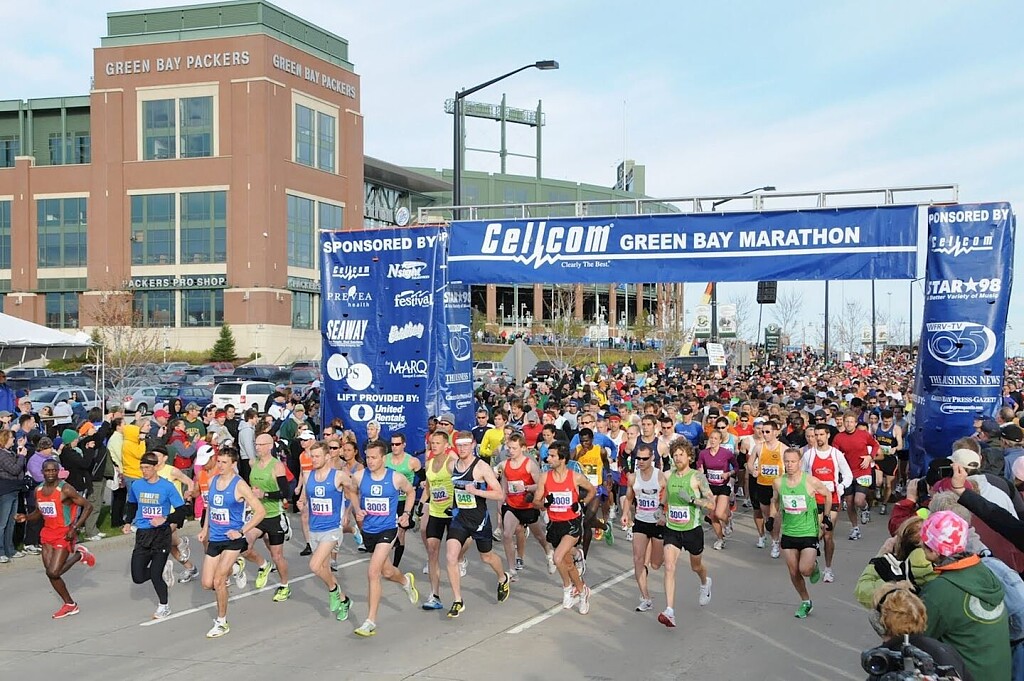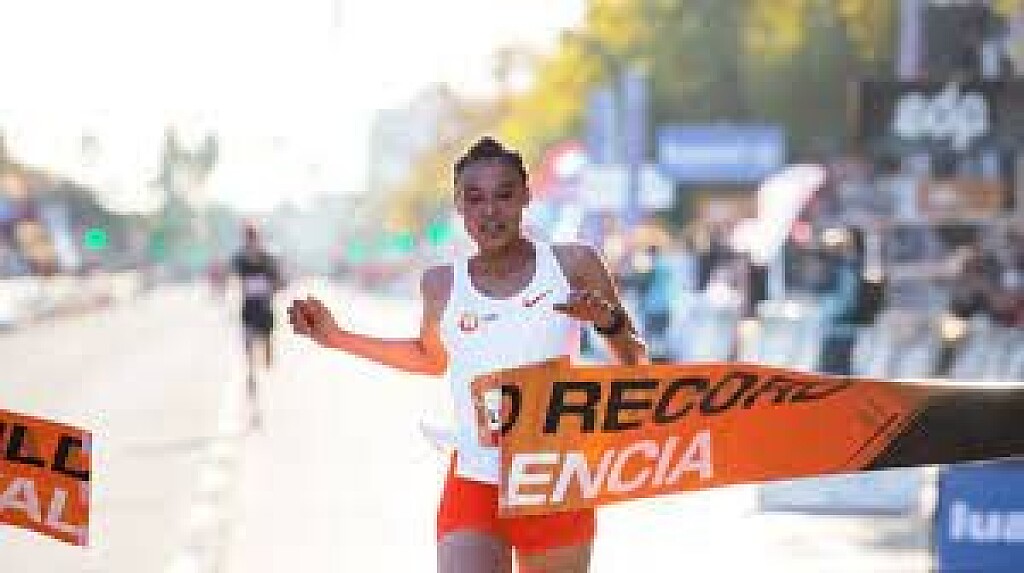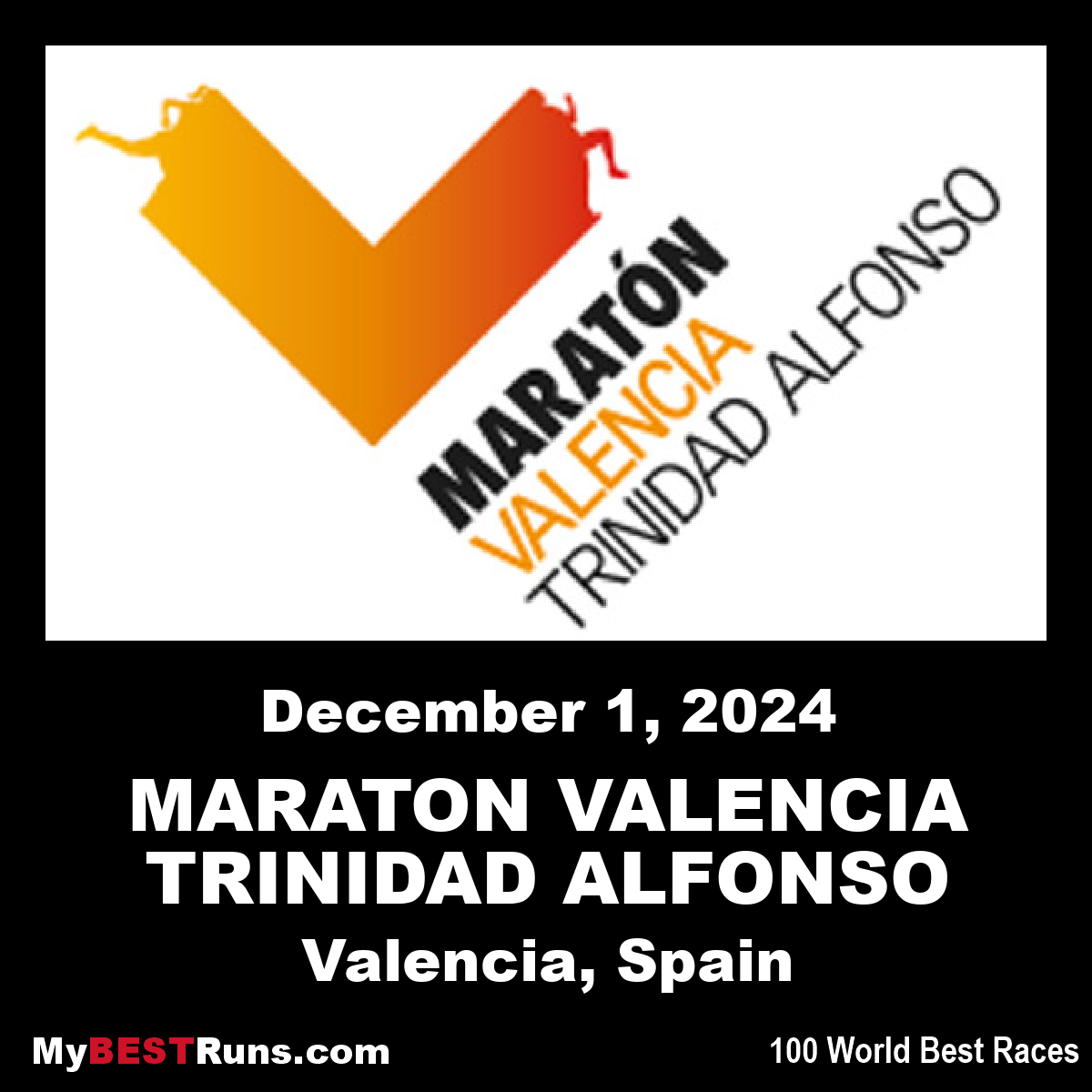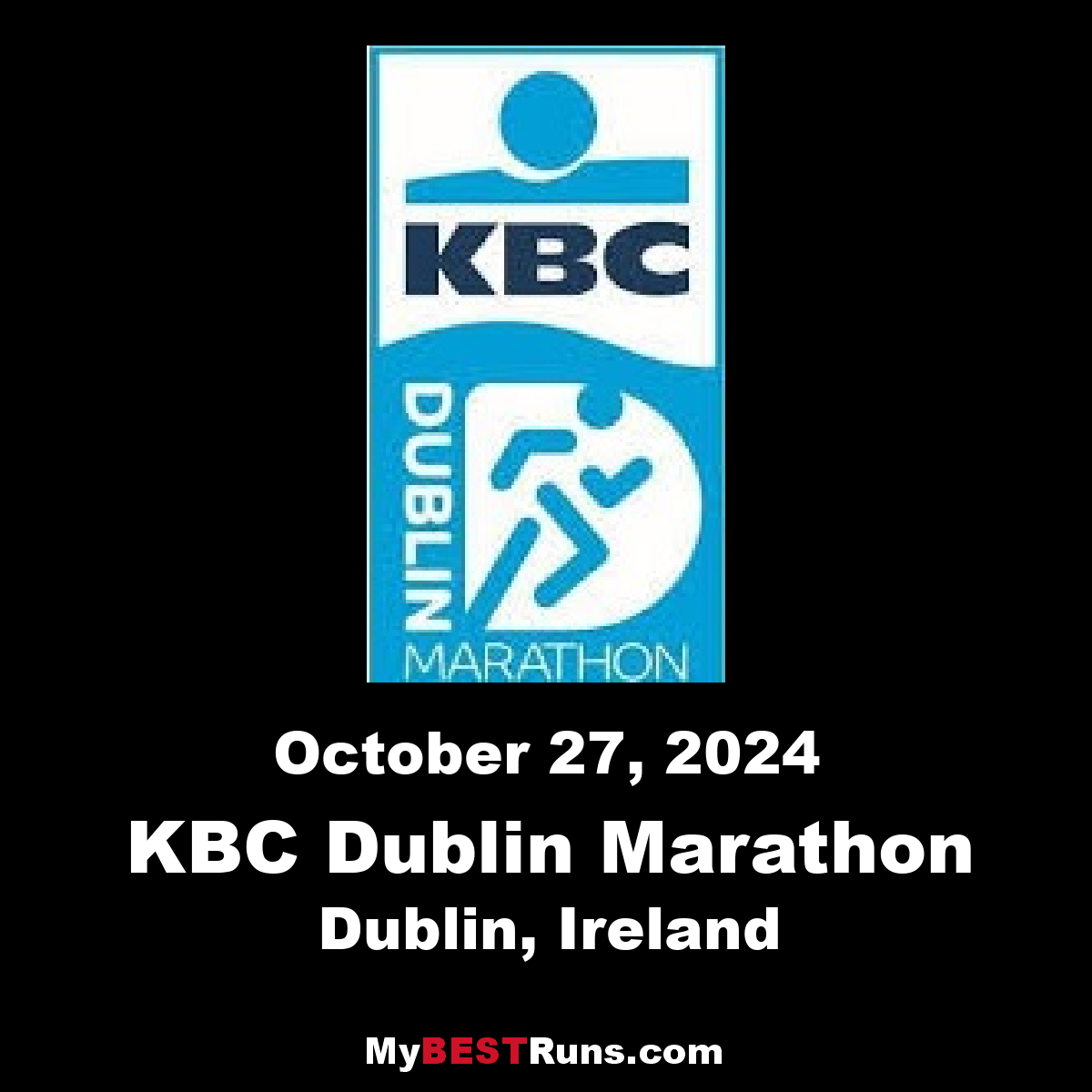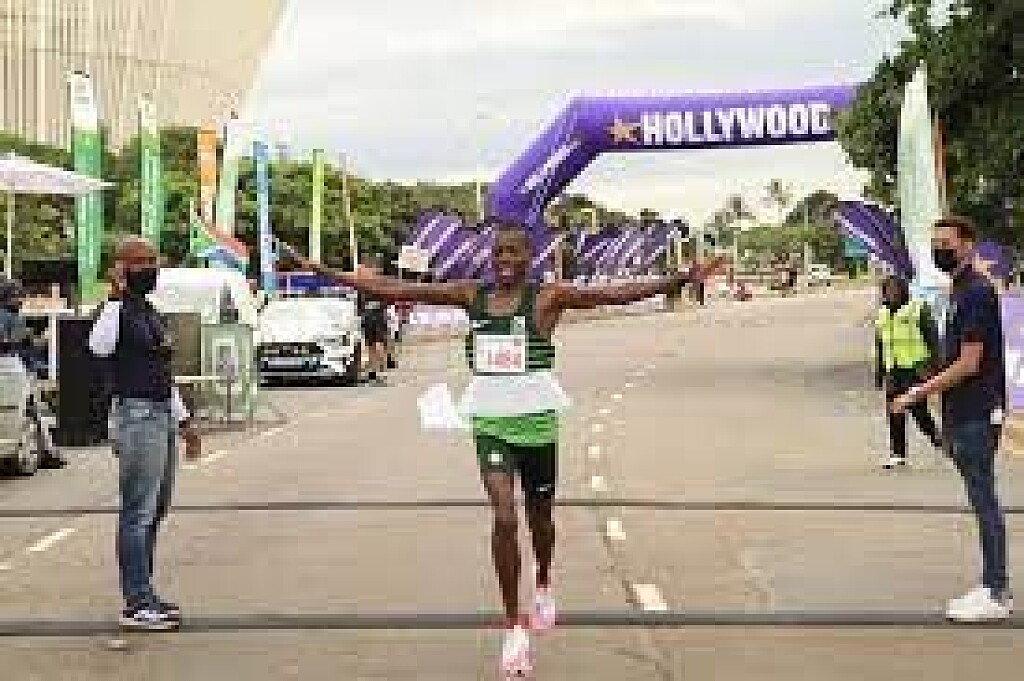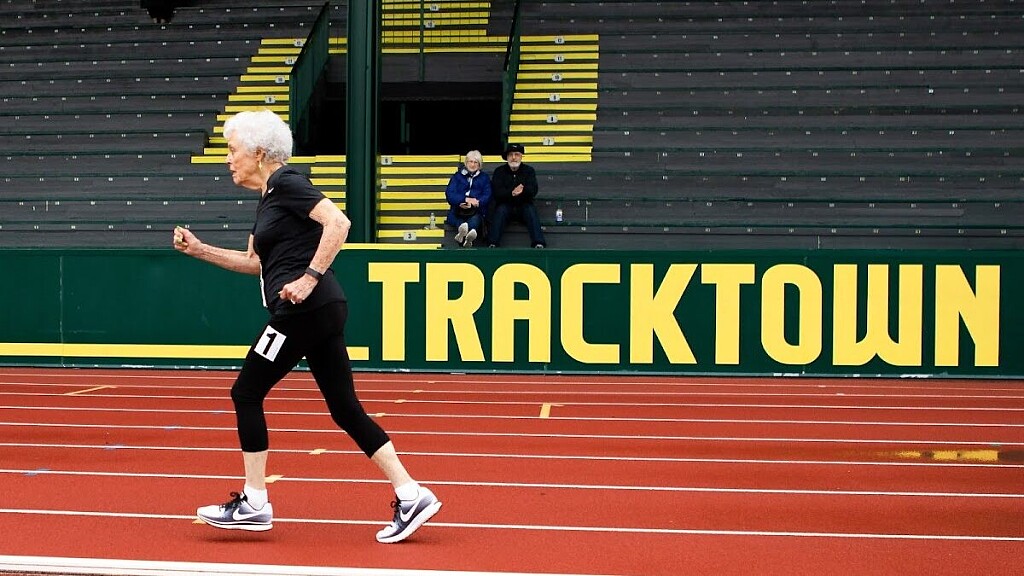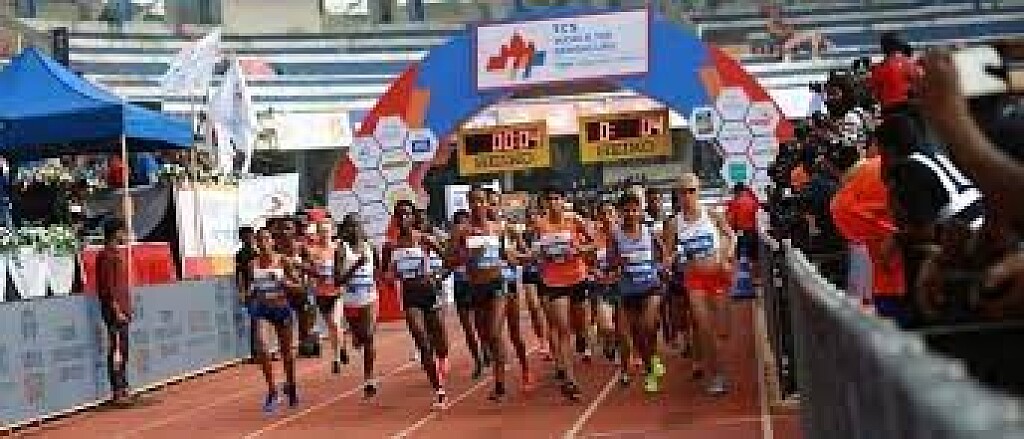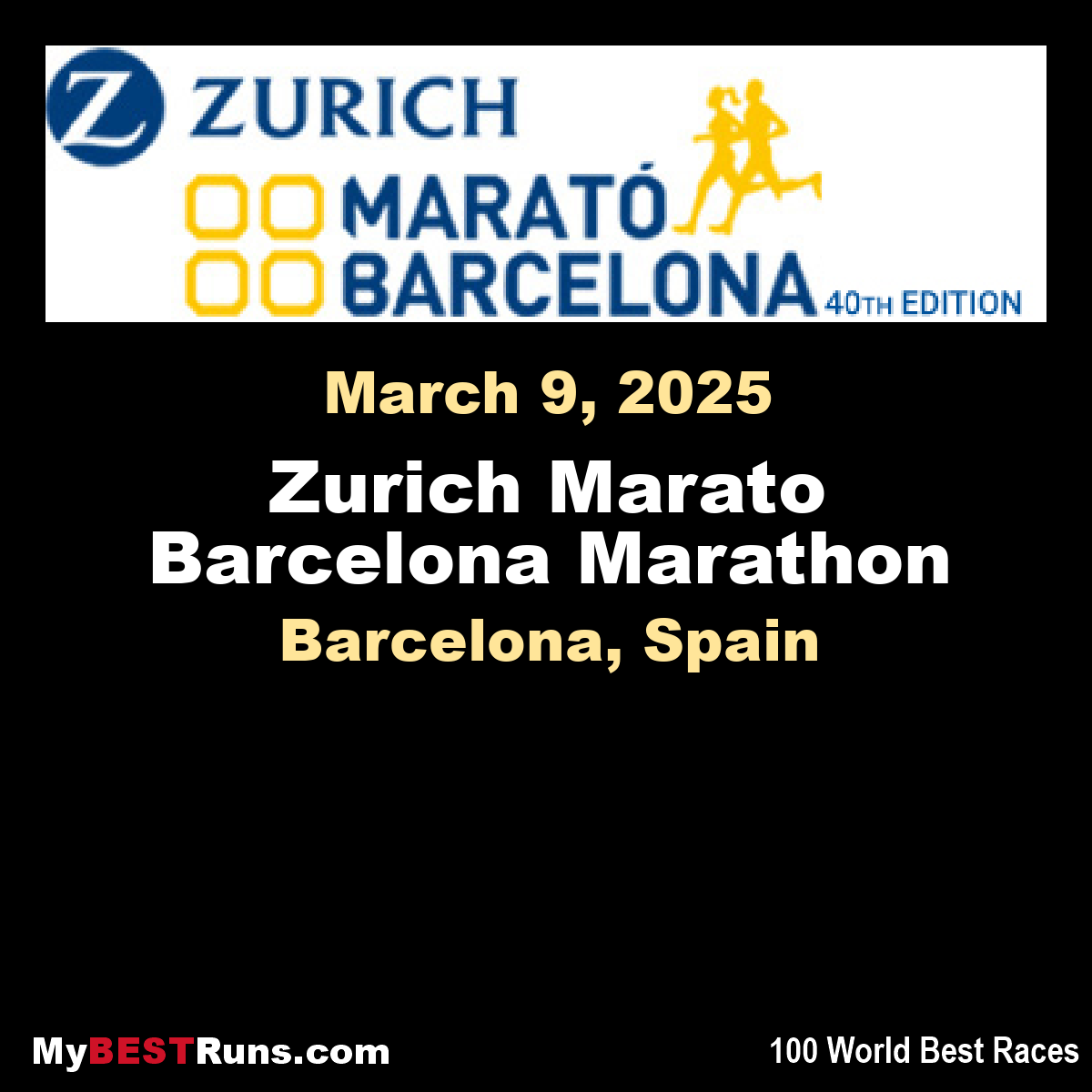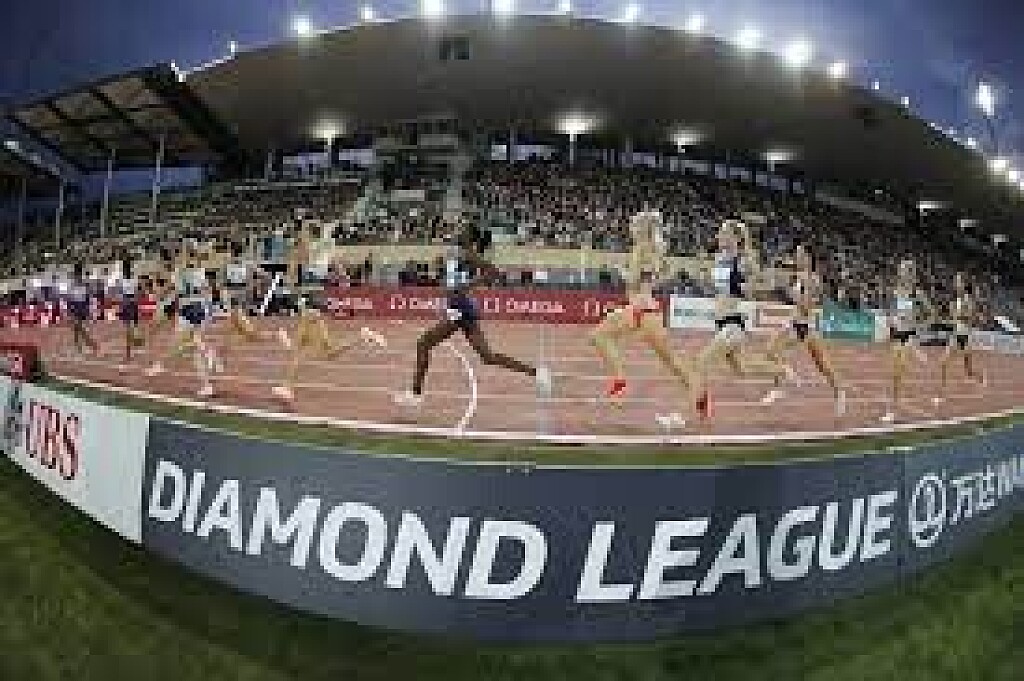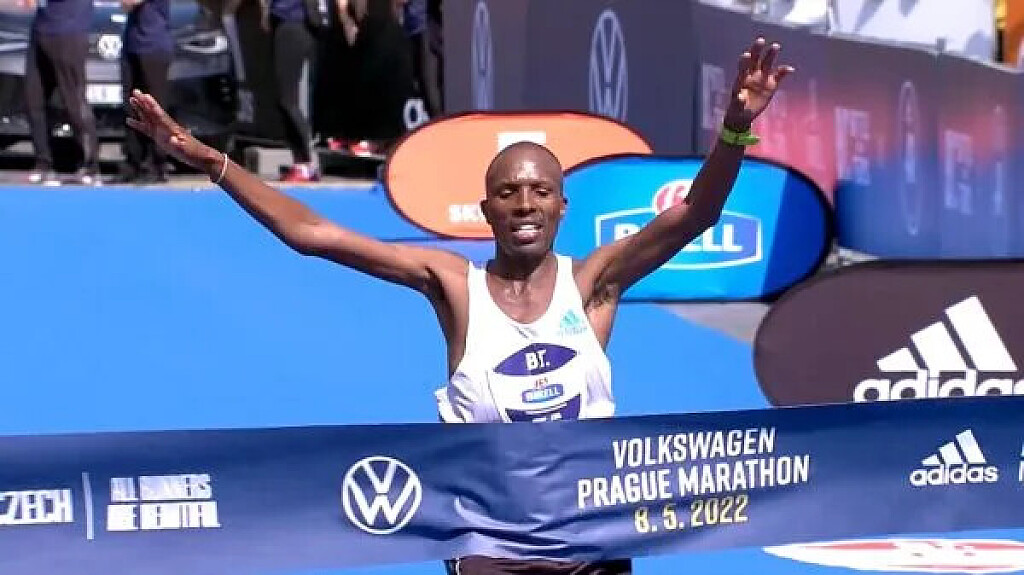Running News Daily
Running News Daily is edited by Bob Anderson in Los Altos California USA and team in Thika Kenya, La Piedad Mexico, Bend Oregon, Chandler Arizona and Monforte da Beira Portugal. Send your news items to bob@mybestruns.com Advertising opportunities available. Train the Kenyan Way at KATA Kenya. (Kenyan Athletics Training Academy) in Thika Kenya. KATA Portugal at Anderson Manor Retreat in central portugal. Learn more about Bob Anderson, MBR publisher and KATA director/owner, take a look at A Long Run the movie covering Bob's 50 race challenge.
Index to Daily Posts · Sign Up For Updates · Run The World Feed
Only five seconds separated the top three at KATA 10K Time Trial
Sibling rivalry and Excitement marked the May Kenyan Athletics Training Academy (KATA) 10k Time Trial with elite athletes fighting hard to keep their positions.
The event, the 9th since the inception of KATA, was a motivating factor for all those who posted their personal records during the trials that took place on Wednesday May 18 in Thika Kenya.

However, Peter Wanyoike and Zakariah Kirika were unstoppable as they fought tooth and nail to keep their top positions three times in a row.
Doing the trial a week after running his local marathon in Kenya, Wanyoike led Kirika to a 1-2 finish with Eston Mugo finishing third after recovery from an Injury.

Though the top two could not better their previous times, it was a relief for all the rest after knocking down several minutes and second from their previous times.
Wanyoike, who ran 2:25.04 ten days ago, registered 30:01.3 while his avid rival, who also ran 30:04, maintained 30:02.4 to keep his runners-up position.
Eston Mugo was shade over 30 minutes to click 30:06.3 from his April’s 33:22.1 with the all the rest attaining their Personal Best times during the trial that were held under cloudy weather.
60-year-old Charles Ndirangu clocked a fine 36:13.
The next KATA 10k Time Trial will be held on June 15th with better times being anticipated on the same course. Runners of all abilities are welcome to compete.
Names BIB Age Gender Time April Time
1. Peter Wanyoike 213 26 M 30:01.3 (29:53.7 April time)
2. Zakaria Kirika 237 21 M 30:02.4 (29:54.4)
3. Eston Mugo 224 26 M 30:06.3 (33:22.1)
4. Erick Mutuku 216 20 M 30:14.7 (31:41.3)
5. Raphael Gacheru 233 22 M 31:35.9 (32:28.4)
6. Fredrick Kiprotich 79 23 M 31:41.5 - - --
7. Nicholas Kitundu 80 22 M 32:06.9 ------
8. Boniface Mungai 235 23 M 32:30.5 (33:05.6)
9. Levis Kuria 214 21 M 33:04.5 (33:11.6)
10. Charles Ndirangu 82 60 M 36:13.2 ------
11. Samuel Muiruri 68 27 M 36:55.7 (42:30.8)
12. Peter Mukundi 71 25 M 39:16.5 New
13. Caren Chepkemoi 127 19 M 42:06. (42:30.5)
14. Susan Njeri 76 36 M 45:11.9 (45:30.2)
(05/18/2022) ⚡AMPby Coach Joseph Ngure
KATA Time Trial Series
The Kenyan Athletics Training Academy (KATA) in Thika Kenya stages a monthly time trial. Starting Sept 2021 this monthly event is open to anyone who would like to get an official time on a acurant course. Results will be published at My Best Runs so race directors and other interested people can see what kind of shape our participants are...
more...The 9th edition of Mattoni Karlovy Vary Half Marathon is Around the Corner
The Mattoni Karlovy Vary Half Marathon is approaching. This Saturday, May 21, starts one of the most beautiful Czech races!
For several years now, RunCzech has been organizing an international race in Karlovy Vary, which attracts professional athletes and enthusiasts runners.

The 9th edition of the Mattoni 1/2 Marathon Karlovy Vary will start from Nábřeží Osvobození at 6:00 p.m. Since registrations are still free, don’t hesitate and sign up today!
“RunCzech offers to runners a truly unique sports experience. Karlovy Vary, along with ten other European spa towns, is now inscribed on the UNESCO World Heritage List and the Mattoni Karlovy Vary Half Marathon is certainly one of the best ways to fully enjoy the heritage of a beautiful spa town,” said Igor Murko, manager of the RunCzech regional races.

The marathon will feature several categories on Saturday. In addition to the 1/2 Marathon, a 2Run is prepared for runners who do not yet feel completely ready for the whole race.
The first competitor runs 10 km and the second then finishes 11 km to the distance of the half Marathon. The relay race is ideal alternative for team runners. Of course, the traditional dm family run which will start at 4 p.m, is prepared for all family members.
The undemanding 3 km long course in the center of Karlovy Vary is really suitable for everybody.
The first steps of the competitors always lead to the Hotel Thermal where runners can pick up the start numbers. The Running Expo starts on Friday 20.5. (12:00 – 18:00) and will last until Saturday between 10:00 and 15:00.
To pick up the start number, you need your ID and an assigned start number from the RunCzech application, which runners will also find in the Runners ID profile.
(05/18/2022) ⚡AMPMattoni Karlovy Vary Half Marathon
Karlovy Vary is part movie set, part spa town. It also happens to be the site of one of the most scenic half marathons in the world. Twenty-one kilometers that fly by, and that make your spirits soar. Come to Karlovy Vary and you won’t think of this as a race. You will think of it as a gift. IAAF...
more...Nearly 8,000 runners will race through Cleveland this weekend in a city tradition that began in 1978.
The Union Home Mortgage Cleveland Marathon, a three-day event, extends beyond the 26.2-mile course. It attracts novice runners and those like 85-year-old Jim Mackert, who has run in more than 40 races since the event began.
Last year, the race was pushed back to October because of the pandemic. In 2020, it was virtual. This year, runners are returning to Cleveland.
University Hospitals will host a health and fitness expo Friday. The 5K and 10K races are Saturday. Half and full marathons will be Sunday.

The races will start and finish at Memorial Plaza in the shadow of the Fountain of Eternal Life statue on Public Square. The course will pass landmarks such as the Rock & Roll Hall of Fame and the Great Lakes Science Center.
The runners who have registered are from nine countries and 47 states. They feature beginners and veterans like Mackert.

At 85, he runs five to eight miles a day.
“My wife and I raised six children, and when I got to be around 37, I was gaining weight, and I just didn’t like the way I felt, and I started back running again,” Mackert, a former paint store manager, said. “I felt so good, so I kept running, and I haven’t stopped since.”
The return of the spring marathon has Mackert and others excited. He has been running the race since it began in 1978.
He grew up in Lakewood, the youngest of 10 children who weren’t regular workers.
“Nobody in my family was really into sports because we were usually working,” Mackert said.
A teacher spotted him in gym class and recruited him to run cross country and track at Lakewood High School. He ran as a member of the U.S. Army at Fort Riley, Kansas.
He later met his wife and raised his family. But he had left running behind, until he decided to pick it up again.
He later joined local running clubs, like the Cleveland West Road Runners Club, one of the region’s oldest clubs. He also became the president of a running club in Lorain County.
Even during the pandemic, Mackert never stopped running and even virtually completed the last two marathons.
“I felt that if I continued to exercise that it was the best way to that I could fight off getting sick,” he said.
Mackert’s advice to beginning runners? Good shoes and realistic goals.
“What happens is that you hurt yourself trying to do more than you’re capable of,” he said. “Set a realistic goal, and you’ll be happy. Don’t let anybody tell you that you can’t reach that goal.”
(05/18/2022) ⚡AMPby Alexis Oatman
Cleveland Marathon
The Cleveland Marathon features a relatively flat and fast course, great volunteer support and a scenic view of downtown Cleveland and its major landmarks. The course has been designed for our athletes to enjoy views of Browns Stadium, the Rock and Roll Hall of Fame, Lake Erie and many other Cleveland highlights. The Cleveland Marathon began in 1978 in an...
more...Some tips on how to avoid sunburn this summer
Runners are enjoying their first sunny, hot running days of the season. That means it’s time for sunscreen. There are many kinds, but runners have special needs when it comes to choosing specific products, since we spend a great deal of time outdoors in summer. Just don’t assume that covering up with your clothes will protect you from UVA and UVB rays; some materials block some rays, but most do not. Also, remember that most sunscreen lotions are only effective for a couple of hours, so on a longer run, you will have to re-apply to keep protected, since we know that the risk of many skin cancers increases with repeated sunburns.
Water resistance

Water- and sweat-resistant sunscreens are essential to keep you protected when you’re sweating. All sunscreens eventually wash off in the water or from sweat, so don’t be fooled by so-called offers of waterproof sunscreen–and if you’re swimming, it’s always smart to re-apply when you get out of the water.

The limits of SPF ratings
A high SPF (sun protection factor) protects you more, with the caveat that the higher the SPF, the less protection each SPF point provides. The points are measured by how much solar energy (UV radiation) is required to burn you while wearing the sunscreen. SPF 2 filters about about 70 per cent of UVB rays. SPF 50, likely the highest effective SPF rating, filters out about 98 per cent of UVB rays. The catch is that SPF only reflects protection against UVB rays, and UVA rays are also dangerous to our skin and need to be filtered, so buy a broad spectrum sunscreen that protects from both.
Protect your skin even when it’s cloudy
With skin cancer rates on the rise, it’s important to make sure you’re avoiding overexposure to the sun. Use sunscreen in summer, even when it’s overcast. Don’t assume that your clothes will protect you from both UVB and UVA rays, since not all running clothes do, but do wear a hat and sunglasses. A 2011 study of white adults in the United States found that the best way to avoid sunburn while outside is simply to regularly find shade. Also, it’s best to schedule your runs either before 11 a.m. or after 2 p.m., when the sun’s rays are strongest. Choose a mineral sunscreen, since this type contains safer ingredients like zinc oxide or titanium dioxide than regular sunscreen and does not require you to wait 15 minutes before it’s effective.
Take a broad approach when thinking about sunlight protection during the summer. Think about clothing that blocks UVA and UVB, wear a hat and plan your running routes through areas with more shade.
(05/17/2022) ⚡AMPby David Smart
Two-time world 400m hurdles champion Zuzana Hejnova retires
Czech Republic’s Zuzana Hejnova, the two-time world 400m hurdles champion and Olympic bronze medalist, has confirmed her retirement from competitive athletics.
The 35-year-old, who has announced that she is expecting a baby, is to bid an official farewell to her successful career at the Ostrava Golden Spike – a World Athletics Continental Tour Gold meeting – on 31 May.

“I wanted to say goodbye in front of Czech spectators,” she said. “I have had a great career and from the bottom of my heart I thank everyone who supported me. I'm looking forward to a new role now.”
World U18 gold in 2003 was the first of the global titles claimed by Hejnova, the then 16-year-old clocking 57.54 to win the 400m hurdles in Sherbrooke, Canada.

She broke the Czech U20 record for the first time at the World U20 Championships in Grosseto the following year, her 57.44 securing silver, and lowered it again in 2005, eventually taking it to 55.89 when winning the 2005 European U20 title in Kaunas.
Hejnova then broke the Czech senior record the following year and improved it every season from 2006 to 2011. During that period she claimed 400m hurdles bronze at the 2007 European U23 Championships, made her Olympic debut with a seventh-place finish in Beijing in 2008 and secured silver as part of the Czech 4x400m team at the 2010 World Indoor Championships.
Hejnova became an Olympic medalist two years later, winning bronze at the 2012 Games in London, and that was to prove just the start.
During an unbeaten 2013 season in her specialist event, Hejnova won the first of her two world 400m hurdles titles and she did it with the performance of her life – clocking a still-standing Czech record of 52.83 to get gold in Moscow. She won the overall Diamond League title – a feat she repeated in 2015 – and was named athlete of the year by European Athletics and the Czech Athletics Federation.
She retained her world title in Beijing in 2015 – becoming the only athlete to win back-to-back world gold medals in the women’s 400m hurdles – and also achieved top-five finishes in London in 2017 and Doha in 2019. Hejnova then became a three-time Olympian in 2016, finishing fourth in the 400m hurdles in Rio, and claimed European indoor 400m silver in Belgrade the following year.
Despite injury struggles, she returned to reach the final of the World Championships in 2019 and then ran her last race at the Ostrava Golden Spike in September 2020. There she contested the 300m hurdles, an event in which she set the world best of 38.16 in 2013.
(05/17/2022) ⚡AMPby World Athletics
Ukrainian runners in New York gear up for Brooklyn half marathon
After Russia invaded Ukraine, Asiia Holovko ran for her life from Kyiv to escape the war — and now she plans to run across Brooklyn.
Holovko, who came to the United States on March 17, will be running the Brooklyn Half Marathon with members of the Ukrainian Running Club of New York on May 21.
She has run in six countries, was invited to represent Ukraine in the World Marathon Champions in 2019 and was planning to participate in the Paris Marathon in April.

“I had a regular life, a dentist appointment, a hairstyling appointment, I had a job,” said Holovko, 42.
“In two weeks I was supposed to go to Paris to run the marathon,” she said. “All of a sudden, everything got destroyed.”

The war set Holovko on a long journey to safety.
She hitchhiked, took a 12-hour train ride to Lviv, and spent 17 days in Poland before she arrived in Portland, Me., where she is staying with a former roommate from Kyiv.
Soon she will reunite with her cousin, Andriy Herasymchyk, a member of the Ukrainian Running Club of New York, who is also running in the Brooklyn race.
The running club has been a way for Ukrainians in the U.S. to connect and a welcome distraction while Russia continues to attack their home country.
“It’s part of the morning routine to do the right stuff — not just sitting, because sitting and reading the news, you’re getting really depressed,” said Herasymchyk, 34, of Coney Island, Brooklyn.
“There are some times when you’re going for a run thinking, ‘I’m going to do six, seven miles,’ and you end up doing 13 miles, getting the flow. You want to get rid of all the negative stuff, negative energy,” said Herasymchyk, who is from Rivne, Ukraine, and has been running since he was in high school.
“When the war started, I really pushed myself to go for a run because I knew it would be good for me,” said Dmytro Molchanov, 33, the club’s captain. “For a few weeks, I didn’t really enjoy running. It was hard for me to enjoy anything. Running has been a sort of meditation for me when I have some issues,” he said.
The 100-member strong running club provides a community for Ukrainians in New York.
“I moved to the United States seven years ago and I didn’t know anybody here,” said Molchanov, 33, a nurse who lives in Sheepshead Bay. “The club became my second family. I found really true friends.”
In the months following Russia’s invasion of Ukraine, the club has taken on a new significance, providing emotional support to its members and fundraising for the war effort.
“A lot of guys who are here — their parents are still in Ukraine in occupied territories. A lot of them are really worried,” said Herasymchyk.
“My hometown was invaded day one,” said Molchanov, whose mother and grandmother are still in Nova Kahovka, near Crimea.
“They’re alive, that’s the most I can ask for right now. They have food, I’m able to talk to them every day,” he said.
(05/17/2022) ⚡AMPby Ellen Moynihan
RBC Brooklyn Half Marathon
The RBC Brooklyn Half takes you on a 13.1-mile tour through the Borough of Kings, from Prospect Park to the Coney Island Boardwalk.NYRR is thrilled to welcome Royal Bank of Canada (RBC) as the title sponsor of the new RBC Brooklyn Half. The race starts at Prospect Park and ends with a finish like no other on the Coney Island...
more...Use these five takeaways from your first race to crush your second
Congratulations on finishing your first race! After training for months on end, crossing your first finish line can be incredibly rewarding. But where do you go from here? And what can you learn or take away from your first race?
Instead of stressing over what’s next, check out these five helpful takeaways from your first race to help you crush your second.
1. Don’t be too hard on yourself

No matter how your race went or what place you finished in, be proud of your result. You are your own worst critic, and you are the only one who will remember your result a month from now. There’s no need to be too hard on yourself, especially on your first one, so stay positive and look to improve in the next race.
2. Soak in your achievement

One thing many runners will say after a race is, “at least you got out there and ran.” It means you can be proud of yourself and own the moment. The finish line can be rewarding in many ways: it could mark the end of a hard journey, achieving a goal or accomplishing something you never thought was possible. Every achievement needs to be celebrated, no matter the circumstance. Celebrating with one of your favourite foods, desserts or an ice-cold beverage can always provide a little bit of extra motivation mid-race.
3. Find your pace
Pacing yourself for any distance can be tricky; even many veteran runners don’t master the art of pacing. It’s extremely easy to go out too swiftly in your first race: the nerves, adrenaline, and your legs feel fresh. Every runner has made this mistake once or twice and paid for it in the latter half of the race.
We aren’t saying you’ll master pacing by the time you do your second race, but the pacing in your first race should give you an idea of what you did right and where you went wrong.
4. Live and learn
Like anything, the more races you do, the better you’ll get at performing well on the day. Ask yourself questions about how you prepared for the race. Did you get enough rest the day before? Or did you consume enough food to give you fuel to perform?
The best way to learn is by trial and error, and simply by doing more races. Another way is to ask other, more experienced runners to share their tips on how they prep for races and the things they do to make sure everything goes OK.
5. Set short-term goals
You did it! Now that you’ve completed your first race, welcome to the ‘run-ternity’. Take what you learned from your first race and apply it to your training for the next race. The perks of getting the first one out of the way is you now know what to expect and where you can improve for your next one. Set realistic short-term goals, like running a personal best, or running the race without walking, or trying to correct an easy mistake you made in your first race (i.e., showing up to the race 45 minutes early, so you have time to use the washroom and do a warmup).
(05/17/2022) ⚡AMPby Marley Dickinson
What other activities can help you maintain running fitness through injury?
Injuries are the worst, and if not dealt with properly, they can linger longer than necessary. Runners love being active, which is why they can rush back sooner than recommended and risk re-injury. If you’re waiting out an injury and wondering how you can preserve fitness through the process, here are some ideas.
Water running

Water running, especially if you’ve been diagnosed with a stress injury and shouldn’t be weight-bearing, is a great way to maintain fitness. To water run properly, everyone should purchase a flotation belt (which will run you about $30), so that you can maintain your running form while in the water. Once you’re comfortable with the activity, work some repeats into your run. Add 10 by 30 hard and 30 seconds easy to help get your heart rate up.
Strength training

So long as your medical practitioner has cleared you to strength train, working on your weaknesses can help you come back a stronger runner. You can start with physio exercises to strengthen what’s broken, but also, lifting heavy weights is great for runners (professional runners are lifting heavier and heavier all the time).
If it fits in the budget and you’re getting in the gym for the first time, booking an appointment with a personal trainer to get the basics down is a great idea. If it doesn’t fit in the budget, there are lots of online resources to help you as a first timer.
Cycling/elliptical
Much like water running, the bike and the elliptical are two ways to put in long efforts without bearing weight. Especially for marathoners looking to maintain fitness, you can go for hours using either of these tools.
One caveat: if you’re struggling with a hip or ITB issue, the bike and elliptical can make it worse. Try strength training or water running for these injuries.
Hiking and walking
Sometimes an injury is your body telling you to take a break. If you feel you need some time away from structured training or cross training, going on walks or low-intensity hikes is a great way to get moving without straining your body too much. If you need a break, take one.
(05/17/2022) ⚡AMPby Madeleine Kelly
2022 Brooklyn Half Marathon to Return at Full Capacity for 40th Running on Saturday, May 21
More than 22,000 runners expected to race 13.1 miles from Prospect Park to Coney Island.
The RBC Brooklyn Half will return at full capacity for the first time in three years on Saturday, May 21, with more than 22,000 runners expected to race in the event’s 40th running. The race, which was established in 1981, is now one of the country’s premier half marathons with accompanying youth races and a three-day pre-party to celebrate Brooklyn.
“New York Road Runners has such a rich 40-year history in our biggest borough, Brooklyn, and we are excited to be bringing back our premier event in the borough, the RBC Brooklyn Half, for the first time since 2019,” said Ted Metellus, NYRR VP of Events and Race Director. “Since 1981, even before half marathons were popular, the Brooklyn Half has been taking place every year and is now the highlight of NYRR’s year-round presence in Brooklyn, which also includes programs for youth, seniors and the entire community.”

The RBC Brooklyn Half will take runners through the unique and diverse neighborhoods of Brooklyn, beginning at the Brooklyn Museum, passing the scenic Grand Army Plaza, and running through Prospect Park and along Ocean Parkway to the finish line on the famous Coney Island boardwalk.
Below are some highlights and initiatives to look forward to at the 2022 edition of the event:
40th Running: The first Brooklyn Half took place in early spring of 1981 on a course in and around Prospect Park with several hundred finishers. Since then, it has expanded to cover a large portion of Brooklyn and help bring the community together. In 2013, the year after Superstorm Sandy devastated the Brooklyn coastline, the Brooklyn Half helped reinvigorate Coney Island and reminded New Yorkers what makes Coney—and all of Brooklyn—so special. This year will mark the return of the event for the first time since the pandemic began, with Brooklyn Borough President Antonio Reynoso planning to attend.
New Title Sponsor: The Royal Bank of Canada (RBC) will serve as both the exclusive title partner and exclusive financial services and investment banking partner of the event for the first time, activating on race day as well as at the pre-party and post-race festivities. As a purpose-driven global financial institution, RBC, similar to NYRR, is strongly committed to giving back to communities.
Notable Names: This year’s field will include notable names such as TODAY Show’s Al Roker, Good Morning America’s TJ Holmes, TV personality Nev Schulman, and professional athlete Noah Droddy.
Ukrainian Running Club Members: More than 40 members of NYC’s local Ukrainian Running Club will participate, as running has brought the club members closer together as a form of support while the war goes on in Ukraine. The club is captained by Dmytro Molchanov, who moved from Brooklyn to Ukraine seven years ago and will be an NYRR pacer for the 1:20 group.

5-Year Anniversary: Prospect Heights residents Krissa Cetner and Alex Salazar, two avid runners, stopped to get married in front of 100 guests at Mile 6 of the 2017 Brooklyn Half and then hopped back on the course to finish the race. Running for NYRR Team for Kids, the couple will return this year to run in honor of their 5-year anniversary and plan to wear the same tuxedo shirt and bridal shirt. Their 3 1/2 year old son, Myles, will be there to cheer them on.
Guinness World Record Attempt: Local elite Marie-Ange Brumelot of Queens Distance Runners and her father will go for the Guinness World Record for the fastest half marathon run by a parent and child. Brumelot represented France at the 2020 World Athletics Half Marathon Championships and is a 1:14 half marathoner.
Brooklyn’s “Marathon Man”: At 70 years old, Brooklyn’s Leroy Cummins is speeding up, not slowing down. As a member of the NYRR Striders fitness program for older adults, he ran his first marathon last fall at the TCS New York City Marathon, finishing second in his age group in a time of 3:35:15, a quick 8:13 mile pace. He then ran the Boston Marathon in April, and now, known as the “Marathon Man” to his East Flatbush neighbors, will look to finish first place in his age group in Brooklyn.
Boardwalk Kids Run: The whole family is invited to join in on race day activities, as kids ages 8-18 will take part in the Boardwalk Kids Run at the RBC Brooklyn Half for free on Coney Island as part of the Rising New York Road Runners youth program.
RBC Brooklyn Half Pre-Party Presented by New Balance: From May 18 to May 20, runners will pick up their bibs, shop for race merchandise, listen to live music, and dine at local food trucks at the RBC Brooklyn Half Pre-Party Presented by New Balance at Pier 2 in Brooklyn Bridge Park.
Virtual RBC Brooklyn Half: Runners who are unable to be in Brooklyn can participate in the race from anywhere in the world at their own convenience between May 14 and May 22.
About New York Road Runners (NYRR)
NYRR’s mission is to help and inspire people through running. Since 1958, New York Road Runners has grown from a local running club to the world’s premier community running organization. NYRR’s commitment to New York City’s five boroughs features races, virtual races, community events, free youth running initiatives and school programs, the NYRR RUNCENTER featuring the New Balance Run Hub, and training resources that provide hundreds of thousands of people each year with the motivation, know-how, and opportunity to Run for Life. NYRR’s premier event is the TCS New York City Marathon. Held annually on the first Sunday in November, the race features a wide population of runners, from the world’s top professional athletes to a vast range of competitive, recreational, and charity runners. To learn more, visit www.nyrr.org.
(05/16/2022) ⚡AMPRBC Brooklyn Half Marathon
The RBC Brooklyn Half takes you on a 13.1-mile tour through the Borough of Kings, from Prospect Park to the Coney Island Boardwalk.NYRR is thrilled to welcome Royal Bank of Canada (RBC) as the title sponsor of the new RBC Brooklyn Half. The race starts at Prospect Park and ends with a finish like no other on the Coney Island...
more...Try this progression mile workout to improve your 10K
If you have a 10K race on the horizon, it’s important to make sure that your workouts are race-specific. With tons of spring 10K’s happening across the country, we have the perfect 10K specific mile progression workout that will help prepare you to handle the physical demands of kilometres six to 10 in your race.
When training for a 10K, you’ll want to make sure you are covering at least 50 to 70 percent of the race distance in your speed workout. Therefore, one-kilometre and one-mile repeats are essential, as it builds up your endurance to get you more comfortable with your goal pace over the distance.
The workout

Four to five reps of one mile (1,609m or four laps on a track) progression with two minutes rest between reps
The pace: Since the mile is four laps, divide your mile rep up into four paces. On the first lap, you should aim for 10 seconds per kilometre slower than your goal pace (for example, we will use a goal 10K time of 45:00, 4:30/km), so the first lap should be around 1:52. On the next lap, pick up the pace to five seconds per kilometre faster, hitting the next 400m in 1:50. The third 400m should be done at your goal 10K pace of 4:30/km, which is 1:48 for the lap and the last being five seconds faster (4:25/km) in 1:46.

The idea of this workout is to get your body comfortable with faster paces, when it’s experiencing fatigue. If you can hit the paces on all four or five reps, it’ll get you ready to negative split your next 10K.
The two-minute rest in between each rep is a standing or walk rest to help bring your heart rate down before you start up again. Ideally, the paces of this workout will be easier to manage if it’s done on a 200 to 400m track. If the track is under 400m, divide the time per lap by four to determine your pace per 100m. If you do not have access to a track, use a flat 400m, 800m or one-mile loop and set markers along the way.
Control your pace early on and make sure you are hitting the times on the first two reps. If you go out too fast, it’ll ruin the rest of the workout, which isn’t the intention.
(05/16/2022) ⚡AMPby Marley Dickinson
Why you should aim for a negative split in the marathon
Ideally, when running a marathon, your goal should be to run even splits, i.e. to run the second half of the race in the same time as it took you to run the first half, rather than slowing down. (2018 Boston Marathon champion Des Linden is famous for running perfectly even splits in a lot of her races.) If you’re well trained and everything goes well on race day, you might come close to achieving this; with a few marathons under your belt, you might even try to aim for a negative split, which means running the second half of the race slightly faster than the first.
Negative splitting is a challenging proposition for most runners. By 30 km or so (sometimes much earlier), physical and mental fatigue are starting to accumulate, and you might find yourself walking through water stations. Your rate of perceived exertion (RPE) increases with each passing kilometer, and the pace you started at feels harder and harder.
Why negative split?

But with a little experience, trying to achieve a negative split can bring a new challenge to your marathons, and there are good reasons to try it.
Andrew McKay of Toronto remembers the second time he qualified for Boston, at the Philadelphia Marathon in 2016. “It was a really bad weather day, and my iPod failed a few kilometers in, so I was just focused on clicking off Ks, and didn’t have high race goals,” he says. “So instead, I focused on my mental game, and doing only what I was capable of on the day. Each time it felt hard, I asked myself ‘is that all you have today?’ And when the answer was no, I pushed a tiny bit harder… My splits were 1:40:18 and 1:39:54, and it was a PB by four minutes, 45 seconds.”

U.S. ultrarunner Nick Coury has written about negative splitting ultras, but the same principles apply in the marathon, or even the half-marathon. (Coury, 34, won the Desert Solstice 24-hour race in Arizona in 2020, with 250 km; his Ultrasignup.com results go back to 2005, which means he’s been racing ultras since he was 17, and he has a slew of podium finishes and victories.) For example, you’re much less likely to “blow up” if you go out a little slower than your goal pace and maintain that through the first half. “The longer the race, the more time there is for something to go wrong,” Coury writes. “Blowing up at mile 22 of a marathon means four miles of suffering … Going out slow enough to negative split means the risk of each individual problem goes down.” He claims that negative splitting has often allowed him to avoid the discouragement and loss of motivation that comes with being unable to maintain his pace late in a race.
A major advantage Coury claims is reduced recovery time: “This has been the biggest mind-blower for me,” he writes. “Even when we feel ‘good,’ we’ve put the body through a lot.” He’s referring to ultras, but the same is true for marathoners. That soreness in your quads the day after a marathon represents muscle damage; but if you’ve ever had a really bad race and ended up walking most of it, you may have noticed you’re hardly sore at all. The fact is that even a slightly slower pace results in less damage, and consequently, less soreness and associated recovery time. Which means you’re ready to resume training earlier, with less fear of losing fitness before starting your next build.
Note that “faster race times” is not one of Coury’s stated reasons to negative split, even though your times might well improve once you master the art of negative splitting. The reasons for doing it are qualitative, rather than quantitative. But you’ll likely find yourself performing better against the competition in races.
To achieve a negative split, you need to plan on running the first half of the race a few seconds per kilometer slower than your goal pace, and then picking up the pace in the second half. This sounds easy, but considering that even running your goal pace will feel very slow during the first half, it actually takes a lot of discipline to run even more slowly than that. Once you pass the halfway mark, hopefully you’re feeling relatively comfortable, and you can begin to gradually increase the pace, keeping something in reserve for a final kick to the finish line. “The more I negative split, the more I just feel straight-up good late in a race,” says Coury.
The bottom line? It’s more fun than slogging
“The hidden benefit of negative splitting is just how much fun it is,” Coury writes. “It’s hard to describe catching minutes a mile on the front runners in a race 80 per cent in, and doing so without having to dig deep and suffer. I’ve really become addicted to it, and can’t imagine going back to the days of just hanging on to get to the finish line.”
Achieving a negative split takes some practice and patience; you don’t want to slow down so much in the first half that you end up slower than if you just went about racing in your usual manner. (Coury has found 3 per cent to be about right.) Also, your performance will vary depending not only on how well you train, but on how well you recover while training, how much sleep you get, the quality of your nutrition while training, and myriad other factors. But the potential benefits are certainly worth exploring.
(05/16/2022) ⚡AMPby Anne Francis
Kenya’s Irene Cheptai and Nicholas Kipkori break course records in Bengaluru
Irene Cheptai and Nicholas Kipkorir Kimeli ran course records of 30:35 and 27:38 respectively at the Tata Consultancy Services (TCS) World 10K Bengaluru 2022 – a World Athletics Elite Label road race – on Sunday (15).
Cheptai took 44 seconds off the women’s course record which had stood to the late Agnes Tirop at 31:19 since 2018.
After a super-fast opening two kilometers of 3:02 and 3:04, a quick time was always likely and the race was soon down to just three women at the front: Cheptai, two-time world 5000m champion Hellen Obiri and fellow Kenyan Joyce Tele.

Tele started to lose contact with her compatriots in the fifth kilometer before Obriri, pushing the pace with Cheptai running in her slipstream, passed the halfway point in 15:15.
Obiri led the race for the next two kilometers, going through 6km in 18:23 and 7km in 21:32, before Cheptai took her turn to push at the front for a kilometer as Obiri briefly went through a bad patch. However, Obiri soon recovered her poise and regained the lead just after embarking on the penultimate kilometer.

The Kenyan pair carried on their enthralling head-to-head battle, but with just 250 meters to go Cheptai darted past Obiri and was never headed before crossing the line in a personal best of 30:35, her first time inside 31 minutes.
Obiri eased off once she knew the race was lost but still came home in an outstanding 30:44, also inside Tirop’s former course record, while Tele was a distant third in 31:47 to complete an all-Kenyan podium.
“When we raced through an inclined patch on the route [just after 7km], I felt like Hellen’s pace reduced, that’s when I tried harder to take lead,” said Cheptai. “But even when I entered the stadium for the final lap, I was fearing Hellen and kept pushing my speed to win.”
The men’s race unfolded in a very different fashion to the women’s. Kipkorir Kimeli, fourth in the Olympic 5000m final last year, took the lead with a kilometer to go and pulled away from Ethiopia’s world U20 10,000m champion Tadese Worku to reduce the men’s course record by six seconds from the previous mark set by his compatriot Geoffrey Kamworor in 2014.
The race started off in an unusual manner with Kenya’s Reynold Kipkorir – who was to eventually finish ninth – out on his own for much of the first 5km, passing the halfway point in 14:00 with the rest of the elite field staying about 70 meters in arrears.
However, shortly after going through 5km, Worku changed gear and started to rapidly tow the leading men back to Kipkorir before going past him just before the 6km point and then increasing the pace further.
Kipkorir Kimeli continued running just behind Worku for the next three kilometers, letting his Ethiopian rival do all the hard work as the pair gradually got back on to course record pace as they also put daylight between themselves and the rest of the men’s field.
Worku still looked fresh as they reached the final kilometer but could not respond when Kipkorir Kimeli took the lead, with the latter almost sprinting like a middle-distance runner over the final 300 meters as the finish line approached in Bengaluru’s Sree Kanteerava Stadium.
Kipkorir Kimeli crossed the line in 27:38 with Worku also inside the old record with 27:43 while the Kenyan pre-race favorite, and former world half marathon record-holder, Kibiwott Kandie made up three places in the final two kilometers and came through for third in 27:57.
By contrast, Ethiopia’s two-time world 5000m champion Muktar Edris was never in contention for the podium and finished back in seventh.
“Honestly, I was not expecting to get the course record,” said Kipkorir Kimeli. “When we reached 5K, we didn’t think we will get the course record, in fact, even when we crossed the 7K-mark, I didn’t think we will make the record. But only when Worku pushed ahead, I picked up pace towards the end.”
(05/16/2022) ⚡AMPby World Athletics
TCS WORLD 10K BENGALURU
The TCS World 10k Bengaluru has always excelled in ways beyond running. It has opened new doors for people to reach out to the less privileged of the society and encourages them to do their bit. The TCS World 10K event is the world’s richest 10 Km run and has seen participation from top elite athletes in the world. ...
more...Tyler McCandless blows away the field at the Colfax Denver Marathon today
Runners of all speeds laced up their racing shoes and grabbed their bibs to race in Denver’s 16th annual Colfax Marathon.
Denver’s biggest running event took place on Sunday, May 15, and welcomed more than 30,000 runners to the Mile High City.


Tyler McCandless posted, "I ran 2:21:07 for a win and new event record Denver's Colfax Marathon! Took almost 3:30 off the previous event record. 9 years since the last time I won a marathon and winning at altitude in Denver was both very hard and extra special! Thanks for all the cheers, kudos and congrats, and thanks #ColfaxMarathon for putting on a world class marathon in Denver!"
Male overall marathon winners:
Tyler McCandless, 35, of Fort Collins finished with a time of 2:21:07
Zebulon Hanley, 30, of Louisville finished with a time of 2:30:40
Anthony Bruns, 42, of Denver finished with a time of 2:32:47
Female overall marathon winners:
Sarah Villasenor, 37, of Denver finished with a time of 3:02:51
Sarah Bay, 43, of Niwot finished with a time of 3:05:17
Janie Nabholz, 22, finished with a time of 3:09:23
(05/15/2022) ⚡AMPPhotos of the best costumes at San Francisco's Bay to Breakers race
San Francisco runs at a different speed than other cities. It also usually runs in costumes.Nearly every year since 1912, the city has celebrated Bay to Breakers, a 12-kilometer run that begins at Howard and Main streets and concludes at Ocean Beach.
But like most San Francisco traditions, there's a whimsical element involved, with the actual run taking a backseat to antics and partying along the route and a fashion show of costumes. Although the race does award some prizes, Bay to Breakers is more about the spirit than the finish times.

Although seemingly all fun and games, this year's race was mired by a few surprising controversies. The chair of Capstone Event Group, which organizes the race, gave money to divisive political candidates. And initially the organizers refused to give prizes to non-binary racers, a policy which was recanted after widespread blow back.

Regardless of those issues, the event was back in full force after a two year absence, with thousands of runners enjoying the cool, foggy weather.
(05/15/2022) ⚡AMP
Zappos Running Bay to Breakers
San Francisco's Zappos Running Bay to Breakers is an annual footraceand has run for over 100 year as a staple to the City by the Bay. With a starting point near the San Francisco Bay, a few blocks from The Embarcadero, the 12K race runs west through the city and finishes at the Great Highway where breakers crash onto the...
more...This Mom Helps New Parents Return to Running After Pregnancy
Colette Berry wasn't prepared for postpartum running. So she made it her mission to help other women avoid her complications.
Just six weeks after giving birth to her daughter, Delphine, Berry set out on a three-mile run. But her core wasn’t strong enough to control her bladder, and her pelvic floor was unprepared for the impact that running demands. Nevertheless, she followed the vague advice of her OB-GYN and continued to moderately jog after those fateful first miles. “I made a bad situation worse,” she says.

It was the lowest point in a life full of running highs. She fell in love with the sport in college at American University, then moved to Europe during her senior year and hit the European marathon circuit after graduating, running Venice and Amsterdam, and earning a 3:37 PR in Berlin. In 2010, while living in Switzerland, Berry joined the Geneva Runners, an international expat running club, where she met her husband, Edmund.
Not long after, she took up triathlon and consistently progressed from sprint distance, to Olympic distance, to completing an Ironman at Lake Placid in 2015 after moving back to the U.S., one month before becoming pregnant with Delphine.
While Berry took some time off after giving birth, she felt like her doctors didn’t give her clear instructions for returning to running. “I’m pretty intense about my sport,” she told them, but they didn’t understand how seriously she trained. After a year of running in frustration and discomfort, Berry started seeing a pelvic health physical therapist who helped her retrain her pelvic floor muscles, which undergo intense strain during pregnancy and delivery.
During the process, Berry became interested in the science behind postpartum exercise and realized that if she had been more informed from the start, she might have avoided her complications. So in 2020, she became a certified pre- and post-natal personal trainer and now guides clients through three stages—prenatal, labor, and parenthood—and gives them the tools to return to exercise safely, including these three strategies.
Train for pregnancy like an athlete
During pregnancy, you should strength train for the surprisingly physical movement patterns that you’ll face, like bathing a baby. “First, master the fundamentals with bodyweight squats, deadlifts, and lunges,” she says. “Then, add weights and combine them into compound movements.” New parents spend a lot of time on the ground, so practice standing up with an offset weight. Make sure to hinge at the hips, and avoid rounding your back by keeping your core engaged.
Don’t give up on yourself
If you’re a runner who’s recently given birth, you don’t have to endure months of misery on the road back to exercise. “A lot of women think they have to live with certain conditions—like peeing when they sneeze or run, or pressure in their pelvic floor—but they don’t have to,” Berry says. “Pelvic dysfunction is common, but not normal.” Seek out a physical therapist who specializes in women’s health or pelvic health if you’re experiencing postpartum complications. OB-GYNs might not be trained to remedy these issues, but they can help you find a referral.
Find (or form) a like-minded community
When Berry resumed running after pregnancy, she missed the social aspect of the sport. “I wasn’t going to find some track club and run with my jogging stroller at 10 a.m.,” she says. “So I created this group called Central Park Stroller Runners. Everyone was a new parent. It became a weekly thing, and I met some of my closest friends through that group.”
Berry’s running crew found a way to coexist amongst the antsy cyclists and ambling tourists in Central Park. They ran through the winter months, with their children nestled in sleeping bags and hats, and received some disapproving stares when their potty-training kids ventured behind the trees to relieve themselves. “If you’re a parent in New York, I promise that your child has peed in Central Park,” she says.
(05/15/2022) ⚡AMPby Runner’s World
Why You Should Be Wearing Sunglasses On Every. Single. Run.
Your eyes, just like your skin, need UV protection. Here’s what to look for in glasses to keep you covered.
Sunglasses are such a staple in my running kit that if I forget a pair, I have no choice but to head back home and grab them, same as if I left headphones behind. I think I look 100 times faster in a really cool pair of shades (and I love that they hide the pain in my face at mile 23 of a marathon), but I also squint less, stress less about getting things in my eyes, and I see better, especially in bright sunlight.

To anyone who asks: “How can you run with sunglasses on?” My answer is how can you not? If you’re wearing the right pair, they won’t slip, they won’t bounce, and they’ll protect your eyes from all kinds of damage that you might not have to worry about in the moment, but certainly should be thinking about in the long run (pun intended!).
Need more convincing? Learn about the damage of not wearing sunglasses, what you need to look for in sunglasses to make sure you’re getting the right UV eye protection, and what brands are doing to keep your vision safe.
Why You Need UV Eye Protection on Every Run
You know how bad sun exposure is for your skin, right? That’s why you slather on sunscreen every time you head outside. Well, too much sun can be equally damaging to your eyes.
The chief role of sunglasses is ultraviolet light protection. “The majority of UV light is absorbed by the cornea, but with significant amounts of exposure, that radiation will eventually get through the cornea and cause damage to the inner structures of the eye,” said James Dello Russo, an optometrist at the New Jersey Eye Care Center in Bergenfield and Passaic, New York.
Runners who don’t wear UV eye protection can eventually develop growths on the clear covering over the white part of the eye called pinguecula and pterygium, says Yuna Rapoport, M.D., an ophthalmologist at Manhattan Eye in New York City. A pinguecula is a yellowish, raised deposit of protein, fat, or calcium; a pterygium is a growth of fleshy tissue that may start as a pinguecula. A pterygium can affect your vision, and may result in surgery.
If you’re running in the snow or near water, you can also develop a form of photokeratitis, a painful, temporary eye condition caused by exposure to UV reflections off of snow, ice, sand, or water. (Translation: Wearing UV eye protection isn’t just a necessity in the bright lights of summer, but straight through winter too.)
“The two biggest concerns, though, are cataracts and age-related macular degeneration,” says Dello Russo. You shouldn’t have to worry about these issues until your 70s, but “people who are out in the elements all the time are at risk of developing these sight-debilitating issues at a younger age, which we would never want,” he explains.
PSA: Don’t brush this off and say, ‘oh, I only run a few miles at a time, I’ll be fine.’ “It’s exactly like cumulative sun exposure to your skin,” says Rapoport. “It all adds up.”
Then there’s the physical protection element. Sunglasses act as a kind of environmental windsheld for your eyes, says Dello Russo: “With enough exposure to UV light, runners will get basal cell carcinomas—non-metastatic tumors on the skin.” One super common spot: The eyelids.
Plus, “the cornea—the clear, protective outer layer of your eye—is really susceptible to even the tiniest particles getting in,” explains Rapoport. When you’re running on dusty trails or the wind is whipping debris across the road, “the slightest piece of dust or dirt, a millimeter or even less, can cause an erosion which can lead to an eye infection,” she says. Dirt, dust, and allergens in the air can also cause dry, itchy eyes—which can take the focus off your run and slow you down.
The Most Important Features in Sunglasses
Not surprisingly, the number one selling point in a pair of sunglasses is their UV protection. “You want to look for lenses that block 100 percent of UV light,” says Dello Russo. “The label should say ‘UV absorption up to 400 nanomenters,’ or UV 400.”
There are two types of UV light to be concerned about: UVA, which is associated with skin aging, and UVB, which is associated with skin burning. UV 400-protected sunglasses block both.
FYI: A darker lens tint doesn’t necessarily offer better protection. “How dark your sunglasses are is a matter of personal preference,” says Dello Russo. Certain tints can actually improve contrast in specific conditions, but the color or shade doesn’t have any effect on UV protection—you can even find clear lenses with UV 400.
However dark you prefer your sunglasses, the lenses should be polarized. Polarization is a coating on top of the lens that blocks the reflection of light off of surfaces. What it does is “block that level of glare you’re going to be receiving from different angles so you’re more comfortable,” says Rapoport.
Finally, embrace the whole “bigger is better” approach. “Runners are really going to want to actually look for shield or wrap-style sunglasses,” says Dello Russo. “Most of them are formed to the face and wrap around to the side, typically with oversized lenses, which are not only going to keep the UV out of the eyes, but keep it off the lids and skin.”
As with any piece of gear, though, comfort is key, said Rapoport. “If they pinch your nose or squeeze the temple area, that can cause headaches,” she says. And sunglasses that slide down can be an annoying distraction. Opt for a pair that comes with adjustable nose pads and you can customize the fit.
The Best Sunglasses for Running
We’ve come a long way since you could get away with running in sunglasses you picked up at a gas station.
Take Oakley’s latest innovation in running sunglasses for example, the RE:SUBZERO, which features the brand’s new PhysioMorphic Geometry. Lenses typically curve around a vertical axis (a.k.a. cylindrical lenses) or both vertically and horizontally (a.k.a. spherical lenses), but these new lenses combine both approaches in what’s called a toric or toroid lens, explains Nick Garfias, the vice president of design at Oakley. “It has more of a football shape, curving in two directions in order to become a shield over both your eyes,” he says. “That makes your optic view through that lens way better.”
The frameless design of the RE:SUBZERO—with an extended wrap and rigidity in key areas that mimic the structural properties of a frame—also enhances your field of vision, says Garfias. (And offers more of that eye and skin protection that Dello Russo mentions.)
This shield style has become ubiquitous in the performance sunglass world, not just in Oakley’s designs (see also: the Oakley Sutro), but in Roka’s Matador Air, Smith’s Flywheel, and Rapha’s Pro Team Frameless Glasses—all of which provide oversized protection so you can run with unobstructed vision. (FYI: Many, bigger cycling glasses can double as running glasses.)
Oakley’s RE:SUBZERO—along with many of the brand’s other performance sunglasses—are outfitted with the brand’s Prizm Lens Technology, which is designed to enhance color and contrast so you can see more detail. District Vision also focuses on lens color, not just to provide clarity on the run, but to reduce strain on the eye caused by physical exertion, says co-founder Tom Daly.
“We know that different color curves and different lens tints relax the mind,” Daly explains. “If you’re looking at something through a blue lens compared to a red lens, it sends different signals to the brain and it affects your central nervous system in different ways.” (For example, people wearing blue-tinted lenses demonstrated better reaction times in a study by ZEISS, a German manufacturer of optical systems; red was determined to have more of an activating effect.)
But the easiest way to reduce strain on the face is to let less light through the lens, Daly adds. “Traditional maximum sun-blocking lenses let in around 13 to 16 percent of light; we take it much lower, down to 10 or 11 percent,” says Daly. “We block more light because, just like you hold tension in your body, you hold strain in your eyes. You need to be able to relax the muscles around your eyes.”
District Vision’s Black Rose lens blocks 15 to 31 percent of light, which changes depending on the amount of light around you, says Daly. Similarly, Dynafit recently released the Ultra Pro sunglasses, which use photochromic lens glass technology so the lenses adapt in seconds to variable light—making them ideal for trail runners going in and out of trees. 100% and Tifosi also offers photochromic lenses that react to UV rays, along with other brands.
Of course, you don’t need to spend hundreds of dollars on an excellent pair of sunglasses. Goodr has become a staple in the running world with their $25 no-slip, no-bounce, polarized, UV 400 lenses. You won’t get quite the same level of protection and light blockage or color contrast as the higher-end lenses, but you’ll get the essentials at a lower price. (Knockaround sunglasses are similarly priced, and also have UV 400 polarized lenses.)
On May 20, Goodr will also release the WRAP G, which offers a wider field of vision—with no obstructions or blind spots—than the brand's standard wayfarer designs, more in line with the shield styles doctors recommend for running. These shades will also come with a removable nose-piece and two sizing options for a snug fit that won’t bounce, and ring up at just $45.
Not every runner needs every single feature in the most expensive lenses, so determine what matters most to you—just make sure any pair you buy has that UV 400 eye protection.
The Bottom Line on Sunglasses and UV Eye Protection While Running
At the end of the day, everyone wants to look good in their sunglasses. And you can do that while protecting your eyes—no matter your budget. The key is just making sure you actually wear your glasses every time you head out for a run, so you can sidestep any vision or other eye issues that can come from too much UV exposure. And remember: When picking out your perfect pair, don’t be afraid to go big.
(05/15/2022) ⚡AMPby Runner’s World
Marathon records in Copenhagen
There are new record holders for both men and women after the 2022 edition of the Copenhagen Marathon.
Berhane Tsegay from Eritrea can call himself the new holder of the record time in the Copenhagen Marathon for men.


On Sunday morning, he covered the 42,195 kilometers in the streets of Copenhagen in a time of 2 hours, 8 minutes and 21 seconds. When he crossed the finish line at Islands Brygge, he was thus over a minute and a half faster than the previous race record in the Danish capital.
Number two, three, four and five also finished in times that were faster than Jackson Limo's winning time from 2019.
Five minutes cut off the women's record
Also in the women there is a new holder of the race record.
Just over a quarter of an hour after the men's winner had crossed the finish line, Kenyan Hela Kiprob ran over it as the first woman. With a time of 2 hours, 24 minutes and 10 seconds, she cut a full five minutes off the previous record.
Among other things, this was the result of a flat route and good weather conditions.
Although it was not completely windless in the streets of Copenhagen, the many runners could enjoy pleasant conditions. At the start of the race, the temperature was just below 15 degrees, while along the way it managed to rise a few degrees in the almost cloudless capital.
This is the first time in three years that the race was held. In 2020 and 2021, the corona pandemic prevented the race from being implemented.
With four kilometers left of the men's race, six runners were within a few steps, but Tsegay timed his attack perfectly and was able to run solo over the finish line after giving himself time to wave to the spectators on the run.
A total of 11,295 people had signed up for the race, but according to the race's website, only 9026 runners competed.
(05/15/2022) ⚡AMPCopenhagen Marathon
The race is special in many ways But one thing is the course around almost every part of Copenhagen. The course goes to Frederiksberg which is a very beautiful part of the city. Theres a fantastic atmosphere in the city, and a lot of spectators along the route. The course is pretty fast, and the field of elite runners is...
more...Gary Martin goes 3:57.98 (third fastest high schooler ever behind only Alan Webb and Jim Ryun) to win today's Philadelphia Catholic League Championsips
Another day, another milestone for Gary Martin. And this one was a biggie.
The Archbishop Wood High School senior ran a sub-four minute mile Saturday at the Catholic League championships at Cardinal O'Hara.

After just missing the milestone at the Penn Relays, he ran Saturday's race at 3:57.98. It was the 20th time a high school runner accomplished the feat, and his time was the sixth fastest ever for a high school student. Overall, he was the 14th runner to break the four-minute mark and it was the fastest time in state history. It was the first in the state to break the 4-minute mark.

Martin has been breaking records all year, beginning in cross country, and continuing during the indoor and outdoor seasons.
Last week Martin broke the state record in the 3,200-meter run, posting a 8:41.57 mark to break Robert DiDonato’s record of 8:44.98 set at this meet last year.
The University of Virginia signee will have more chances to smash records at the state meet.
The Archbishop Wood senior has been on a quest to become the first Pennsylvania high school athlete ever to run a sub-four-minute mile.
Running with a purpose and leading from the start, Martin made history with a sizzling time of 3:57.98.
Martin raised his hands in triumph as he crossed the finish line. His time was the fastest in the county by nearly 10 seconds.
“I’ve had a couple of really good workouts this week and I felt I was in shape to do it,” Martin said. “Looking at the weather, I thought it was going to be a good day and it’s one of my last opportunities to really just run an all-out mile before we get into postseason stuff. I just wanted to go for it, see how I was feeling through two laps. I felt good. I was right on so I kept going.”
Martin found the warm conditions with a light rain to his liking as he took the lead in the first 50 meters and kept his foot on the gas. He ran the first quarter in 59.67 seconds, the second in 58.79, the third in 59.87 and the final in 59.62 to obliterate the meet record of 4:14.08 set by O’Hara’s Steve Hallinan and take his place in history.
“For me, I like to run even splits,” Martin said. “I like to settle into a pace, find a pace I need to run and then hold on throughout, which is what I did today. That’s kind of the goal going in. You just have to stay mentally tough.”
Martin wasn’t done for the day. He also won the 800 in a meet-record time of 1:51.29, to break the mark of 1:52.95 set by O’Hara’s Pat Nash in 2000. And Martin anchored Wood’s 4 x 400-meter relay team to a silver medal by two-tenths of a second to take home the outstanding boys track performer of the meet away.
(05/14/2022) ⚡AMPThe four best workouts for beginner runners
If you’re a beginner runner who’s worked up to running steadily without stopping for at least four or five kilometers, you may be wondering what you should do next. While yes, you can continue doing even-paced runs and try to increase your mileage (and you should!), this may start to get a bit boring.
Adding in one or two workouts into your weekly schedule will make your training more interesting and improve your fitness at the same time. Not sure where to start? These four workouts are great for beginners who are just getting acquainted with speed work.
The fartlek

“Fartlek” is a Swedish term that means speed play. A fartlek workout can be used by runners of all levels, but its loose, fun structure is great for beginners because you don’t need to worry about timing your intervals or your rest. This style of workout allows you to run by feel and learn how to push your body in a low-pressure way.
To do a fartlek workout, start out by running at a steady, even pace for the first five to 10 minutes, as you would for a regular run. Once you’re warmed up, choose a landmark in the distance, and pick up speed until you reach it. Slow back down to an easy jog, and once you’re ready, pick another landmark and go again. Many runners like to use lamp posts, driveways or mailboxes to mark their destinations, but you can choose whatever works for you.

Continue running fast and easy sections for the remainder of the run, leaving five to 10 minutes at the end for a cooldown.
Hills
Hill workouts are a great way to build strength and work on good running form, which is why they’re great for beginners who want to start off on the right foot. They are also easily scalable according to your current running abilities.
To perform a hill workout, find a moderately-steep hill nearby that you can run up for at least one minute. Start out by jogging for five or 10 minutes to warm up, ending at the bottom of the hill. Start by running for 20-30 seconds up the hill, focusing on driving with your knees and pumping your arms. Jog or walk back down to the bottom and do it again. Repeat this as many times as you like, then do a five to 10-minute cooldown jog to complete the workout.
Straights and curves
A track is a great tool for beginners because it’s a flat, relatively forgiving surface where you don’t have to worry about being interrupted by traffic lights. The track also provides another great opportunity to practice good running form while getting your legs moving a little quicker.
To perform a straights and curves workout, start by jogging around the track two or three times to warm up. Once you’ve done that, continue running around the track, running hard on the straights and jogging or walking the curves. Aim to complete at least five laps (that’s two kilometers on a 400m track) before doing another couple of laps as a cooldown. Check out more beginner track workouts here.
Relay workout
If you’ve got a friend who’s also a beginner runner, a relay workout is a great way for the two of you to do some speed work together. A track is a perfect place to do this workout, but even a field or a small loop in a neighborhood will work.
To do a relay workout, warm up together with a five to 10-minute easy jog. Then, one of you will run one lap at a faster pace, while the other one waits. When the first runner arrives back at the starting point, the other will take off. Keep alternating laps like this for 15-20 minutes. To make this even more fun, use a baton of some kind (a stick, a ruler…even a banana!) to hand off to each other before each lap.
(05/14/2022) ⚡AMPby Running Magazine
Expert tips to prepare for your first 5k
The 5k distance is one of the most popular races in running and it is much-loved among amateur and professional athletes alike.
If you’ve never competed in a 5k race before, there are some things to bear in mind that can help you prepare for the big day.

We asked a select group of fitness and running experts for their top tips and advice when it comes to preparing for your first 5k race.
Here is what they said.

Stick To Your Routine In The Lead-Up To The Race
Peter Keane, Physiotherapist at Physio Motion 3D
In the week leading up to your race, don’t change your routine.
This isn’t the time to be experimenting with new food, shoes, drinks or anything else.
Also, it’s only a 5k! Don’t fall into the trap of thinking you need to load up on carbohydrates, you’re very unlikely to burn off that much fuel.
It’s important to eat well-balanced meals that you’ve been enjoying all along.
On Race Day: Again, don’t make the easy mistake of gulping down lots of water in order to stay hydrated during the race. It’s all about sipping. Sip if it’s hot or your mouth is dry – you’ll often see athletes take a mouthful and then rinse and spit. This is because they’ve stayed hydrated in the days before the race and are ready to go.
In terms of food, make sure you’re not eating anything within two hours of the race. A good pre-race meal that’s loaded with carbs, protein and some fats would be some oatmeal and berries or a bagel with peanut butter.
Begin and take the first kilometer about 10 to 20 per cent slower than you usually would (chances are, this will actually be your normal pace) and this will allow you to finish strong.
Keep your pace slow, steady and even – so you can blast home on that final stretch.
Post-Race: Remember to walk around for at least 10 minutes afterwards. This will your body adequate time to wind down and get your heart rate back to a normal resting state. Do your stretches and refuel.
Give Yourself Enough Time To Prepare For The Race
Amie Dworecki, Running Coach at Running With Life
One thing I would suggest is that people interested in running a 5k give themselves ample time to prepare. This is usually eight to 12 weeks beforehand for someone who has never run before.
The body takes time to adapt, and running is a high-impact sport, so given enough time, the process can go much more smoothly, and with less soreness and reduced chance of injury.
I also suggest that people start out with walking, if they are not regularly doing so. Even five minutes of walking building up a few minutes each time, until they are regularly walking 30+ minutes, three to four times a week.
Then, they can start adding in run intervals. There are many couch to 5k apps and programs available online, with the advantages that they are free and widely available.
However, in many cases it can be a you get what you pay for, and those can be written by anyone, and some have jumps in intensity or frequency that are not appropriate for beginners.
I find it is best to work with a program led by a certified coach if it is available. The advantages are that the program is designed by someone who knows what they are doing, you have someone to ask advice if things are not going well, and you have a group to help support you.
Beginning a running program to the 5k level is as much a mental and lifestyle change, as it is a physical habit. Meeting with a group helps greatly with accountability and that can be key when getting your workouts done. Even an online or virtual group will give this and can be better than trying to go it alone.
I also have 5k training programs on trails. Often the surface of a trail (depending on the area) is much softer than concrete, and for beginners who are not used to the hard pounding on their joints, and/or who may have weight to lose, trails can offer a gentler surface on which to train.
This is also a popular choice for older participants who may not want the jostling of concrete.
If a group is not available, make sure the program is gradual, without sudden sharp increases in running time. And, don’t be afraid to repeat a week if that is what you need to do. This is about reaching the end goal in a way that is successful, versus trying to follow a rigid program that may not be right for the runner.
For an absolute beginner, I have found that starting with run intervals of 30 seconds to one minute is best.
Make sure to include a proper warm-up and cool-down before and after. It doesn’t have to be anything complex. It can be five to 10 minutes of walking with simple stretches that address any areas of personal tightness a person may be experiencing.
I usually suggest running the first race at a manageable pace with the goal being to complete the distance feeling good.
The first race is always a PR (personal record). There will be other races in which speed can be added in as an extra.
Find A Good Place For Your Training And Get The Right Equipment
Ryan Hill, Physical Therapist and Co-founder of The Stride
Running your first 5k is a great goal. It is a race that you can push yourself in, but it’s also a distance for everyone if you put in the effort.
Some of the first things to consider are your goals, how often you can run to train, your fitness level to start, where you plan to train, and if you have the necessary equipment.
When it comes to goals, have one! Maybe the goal is to lose weight, get more fit, or push yourself physically.
Regardless, having the 5k in the calendar gives you a concrete reason to get up and go for that run. It will keep you motivated and engaged in the process.
If your goal is losing weight, then being consistent with running OR walking is the key.
Try to create a habit where it feels like physical activity is a natural part of the day. It can take a few weeks to develop a habit, so having it worked into a 5k training plan is a great way to stay on task.
If your goal is to get more fit or challenge yourself physically, then being prepared to throw in a couple of days of speed work for some variety can be beneficial. Finishing those hard runs can give a great sense of achievement.
Plan to set aside three to four days of jogging per week week and expect to spend thirty minutes to an hour being active on those days.
Typically, we suggest doing your running early in the morning. Morning races are the norm, so it helps to train during the time of day you will perform. The other advantage of starting early is that it gets the work out of the way before all the other life factors arise. It also helps kickstart your metabolism and can help you feel more energized throughout the day.
In terms of fitness level, we recommend that you be able to jog for 10 consecutive minutes before starting a 5k training program.
If you aren’t able to jog for 10 minutes, that’s perfectly fine! Sign up for the race anyways but spend a couple of extra weeks ahead of time doing a jog/walk interval program.
Start with a two-minute jog and three-minute walk x 4. This will be 20 minutes of activity. As it gets easier, increase the amount of time you’re jogging and decrease the time walking.
Finally, have the right equipment. There is no perfect shoe. Your foot is unique to you, so don’t expect the shoe someone else ran in to be what you need.
When you lace up the shoe, you should be able to splay out your toes, and your heel should feel secure in the back of the shoe.
Ideally, the shoe store will allow you to run in the shoe to determine any “hot spots” that you didn’t recognize in the store. While not necessary, having a GPS watch to track your mileage and heart rate can be beneficial.
Finally, reach out to a physical therapist or trainer and get a simple screen performed. They will let you know what muscle groups and motions you should work on to help avoid an injury. One of the best ways to get out of the running is to get hurt on your first race.
(05/14/2022) ⚡AMPby The sport Review
Protein Bars: The Good, the Bad, and the Ugly
When you think about protein bars, what comes to mind? Convenience? Recovery food? Quick energy? While whole foods are preferred to get in overall balanced nutrition, protein bars can provide quick sources of all of the macronutrients (carbs, protein, and fats) as well as an additional burst of micronutrients (vitamins and minerals) when you are in a pinch. However, it is important to pay close attention to what exactly is in your protein bar when making your choice.
What's In Your Protein Bar?

Protein
When taking a closer look at protein bars, the most obvious ingredient to take note of is the protein source and content of the bar. Protein itself is broken down into amino acids in the body, which can be used to repair, recover, and build up muscles and support the immune system. Branch chain amino acids (or BCAAs, leucine, isoleucine, and valine) are used to promote the highest rates of muscle protein synthesis and are preferred post-workout. Look for a bar that contains 15-20 grams of protein per bar.
What to Look For:
Carbohydrates and Sweeteners
Carbohydrates always seem to get a bad rap. And when it comes to protein bars, "0 grams of sugar" or "low-carb" are familiar labels on many popular bars out there, as they try to entice consumers into thinking they are a better product.
Full disclosure from a dietitian: In reality, some carbs are actually good to help replenish glycogen stores and repair muscle, not to mention, they give flavor to protein bars. On the flip side, we don't want to just have a bar with straight carbohydrate that spikes and drops our blood sugar. When investigating the label for the carb content of the bar, look for a balanced ratio of carb to protein. When evaluating added sugars in a bar, remember we want to limit added sugars to no more than 50 grams a day, however, that doesn't mean we want to avoid them and replace with sugar alcohols.
Bottom Line When Choosing a Good Protein Bar
Yes, try to choose bars that you enjoy, but try to choose protein bars that have a mixture of carbohydrates and protein in them, as well as a short ingredient list. Use caution with sugar alcohols, fibers, proprietary herbal blends, and added flavorings. And don't seek out a bar just because it says "no sugar" or "low carb."
(05/14/2022) ⚡AMPby Trail Runner Magazine
Six times track races went wrong
When running a track race, you sometimes have to expect the unexpected. Sometimes runners fall, wipe out or get clotheslined by an unforeseen object. We are counting down the top five moments when track races go wrong.
You’d think in a sport so simple and easy to understand that spectators would know enough to stay off the field of play when a race is taking place. On May 7, at Japan’s national 10,000m championship, two employees of NHK Cable (who were airing the race) stepped onto the track in the middle of the race, taking out two of the athletes (see video below). The athletes managed to finish the race without suffering any major injuries.

Spiderman attacks
At an indoor 800m race in Ireland, the lead runner gets caught up in the pole vault elastic bars down the home stretch, causing him to slow down, and ultimately lose, the race. The runner ended up receiving an automatic qualifying spot into the next round, since this interference was beyond his control.
“Let’s go, Lay-Lay”
Usually, in a 200m race, your margin of error is very small. At an AAU track meet at Northwest High School in Omaha, Neb., seven-year-old Talaya Crawford, the daughter of professional boxer Bud Crawford, lost her shoe at the start. Although it took her five seconds to get her shoe back on, it did not matter for Talaya, as she fought back to win the 200m race outright.
Jeffrey Julmis
At the Rio 2016 Olympics, 110m hurdler from Haiti Jeffrey Julmis had a race he’ll never forget. After running well in the heats, Julmis had a hard collision with the first hurdle in the semi-final. He managed to get up and finish the race before being disqualified.
Air Bud rips a speedy 100m
The second coming of Air Bud made an appearance at a 4x200m high school relay race in Utah last year, as a dog jumped on the track and eventually passed the leader and won. From the looks of it, the pup covered the final 100m in 11 seconds; there could be some Olympic potential here. Someone get this good boy some treats
In honour of Will Smith’s Oscar performance (NSFW)
A high school runner at a Florida track meet was sucker punched and knocked to the ground by another athlete during a 1,600m race. The man who threw the punch was standing on the track (not in the race), during the middle of the mile, and the runner shoved him out of the way on his first time around. This seems to have upset him, and he struck the runner in the head on his next lap. The runner who was hit finished the race.
(05/14/2022) ⚡AMPby Running Magazine
Man celebrates 5K win and loses race
Every so often a runner makes the mistake of over-celebrating their win before they cross the finish line. It’s always nice to win in style or to strike a sweet pose for Instagram, but a man at the Santander Run Series Villa Forma 5K race in Salvador, Brazil, took it too far.
As the runner was approaching the finishing tape, he got down on his hands and knees to kiss the finish line before he crossed it. It’s clear he did not see the other runner coming him before he started celebrating.

Upon further investigation, even though the man’s hands touched the tape before the second runner, the other runner’s body/race chip was the first to physically cross the finish line, which earned him the win.
French Olympian and 1,500m runner Jimmy Gressier has also developed a reputation for showboating before he wins a race, but so far it has not cost him the race.Hopefully, this is a lesson on what not to do when crossing the finish line.
(05/14/2022) ⚡AMPby Running Magazine
14,000 set for 16th edition of Generali Genève Marathon
After two difficult years with the pandemic, the Generali Genève Marathon in Switzerland is returning to full strength with eight race formats on the event programme and some new features.
Organized by OC Sport, the main marathon event and the half marathon are set for Sunday, May 15, with a number of other events lined up for Saturday, May 14.

This year, financial services firm Generali has become a title partner; and its Swiss foundation, The Human Safety Net Switzerland (THSN), is on board as a charity partner. These two new partnerships will aim to breathe new life into the event, which has returned to its original red colored branding, and features the addition of a new slogan, #RunForRefugees in support of refugees.
The 6km ‘La Genevoise #LikeAGirl by Always’ race, previously intended only for women, has become the ‘5km by Always’, and will now also be open to men. This race is relocated to the lakefront, in front of the jet d’eau, on a fast course conducive to personal bests.

In another evolution, the start in Chêne-Bourg has been slightly moved and will now be just in front of the new Genève train station. This has direct access from many stations to the Lake Geneva area and encourages participants to use public transport.
The organizers will continue to focus on the carbon footprint generated by the event; and a carbon footprint assessment will be carried out. Numerous concrete actions have already been put in place for a number of years, such as the TPG transport ticket offered to each participant, the Geneva water distributed at the refreshment stands without any PET bottles, and the management of waste.
(05/13/2022) ⚡AMPHarmony Geneva Marathon
The Harmony Geneva Marathon for Unicef is arguably one of the most picturesque city marathons in Europe and unquestionably one of the fastest. The course takes in the countryside nestled between mountains and the shore of Lake Geneva before finishing in the heart of the city in front of the famous Jet d’Eau. Thousands of runners from more than 120...
more...Grand Rapids getting ready to welcome thousands for Amway River Bank Run
The city of Grand Rapid is busy with last-minute preparations Friday as thousands are expected to head to the 45th Annual Amway River Bank Run.
There are a plethora of races this year including the 5K walk and run, the 10K, 25K and special wheelchair and handcycle races.

The races kick off at 7 a.m. with festivities happening until 2 p.m. Saturday.
The wheelchair and handcycle races are the only ones of their kind in the world. Race director David Madiol says River Bank Run is the only race in the world with a wheelchair division. 30 racers from across the world will be participating.

Madiol suggests racers hydrate well through the day, as temperatures are expected to get into the 70's Saturday. Water stations will be along the route to help racers hydrate during the race. All non-racers should be aware of road closures Saturday as the streets of downtown will be closed to accommodate racers. Travelers should plan ahead to take alternate routes to get in and out of the city.
The race is expected to be at about 65 percent capacity as it was before the pandemic as it returns to its usual schedule in May of every year.
A press conference is scheduled Friday for 10 a.m. with 15 of the elite racers and organizers. Sign-up for races is still available in-person throughout the day Friday but not online. The Amway River Bank Run clinic will be at open at Devos Hall Friday until 8 p.m.
(05/13/2022) ⚡AMPby Ruta Ulcinaite
Amway River Bank Run
The Amway River Bank Run presented by Fifth Third Bank with Spectrum Health the Official Health Partner celebrates over 43 years. More than 16,000 people are expected to compete in the event which features the largest 25K road race in the country and offers the only 25K Wheelchair racing division in the world along with a 25K Handcycle division. The...
more...Is Your Training Pace Fast Enough?
Beginner and intermediate runners often plagued by the performance plateau. Once a certain level of fitness is reached, improving race times becomes a challenge—especially if you aren't training the right way. Without a variety of workouts, improvement is almost impossible to attain.
Running faster during workouts is essential to achieving a new personal best. In short: To get fast you have to run fast.
The problem for those who do run "fast" is that they're typically not running fast enough.

Running at a pace that's only slightly faster than normal won't help you improve your performance. Even if you're training for a short race like a 5K or 10K, all of your workouts end up being in the aerobic heart rate zone.
Aerobic simply means "with oxygen." The primary energy system is your aerobic metabolism. You use oxygen to fuel your working muscles. When the intensity is relatively low, you can continue at this effort for an extended period of time. These workouts make up the bulk of a good endurance training program.

Anaerobic is the opposite—it means "without oxygen." When anaerobic intensity levels are high, more lactate (more commonly known as lactic acid) is created. Lactate is what produces that burning sensation you might be familiar with late in a race.
To get faster, you'll need a mixture of both. Here's why.
Which Workouts Are Better?
Neither are "better" because they each have different purposes. If you're training for a shorter race like a 10K, your workouts should be evenly divided between aerobic (tempo runs) and anaerobic (5K-paced intervals) workouts.
Runners who are training for a long race like the marathon need less anaerobic work in their training program. A marathon is over 99 percent aerobic. The pace is much slower than a 5K, so you don't have to focus as much on anaerobic training. Classic aerobic workouts for marathon training are:
Tempo workouts
Progression runs
Steady-state or marathon-pace efforts
The shorter your race, the more anaerobic it will be since you'll be running faster. So naturally, your workouts must be faster to meet the specific demands of your goal pace.
If your focus is on a shorter distance like a 5K, these workouts should be included in your training plan:
4 x 1-mile repeats on the track at 10K pace with a 400-meter recovery jog in between reps.
10 x 200-meter repeats on the track at 2-mile race pace with a 200-meter recovery jog in between reps.
3 x 1-mile repeats on the track at 5K race pace with a 400-meter recovery jog in between reps.
You'll notice that not only are you running at your 5K-goal pace, but you're also running faster (2-mile) and slower (10K). These "support" paces help to develop the speed you need to achieve your 5K goals.
For the marathon, it's still a good idea to work occasionally on your speed, but your primary focus should be on building aerobic fitness because of the longer distance. Your pace will be slower, but you still need to focus on what your race-pace goals are. If you're training slower than you plan to race, you won't meet your goals. Adjust your training to include some race-pace workouts, regardless of the distance.
The Difference Between the Two
A key difference between aerobic and anaerobic workouts is that there are more intervals and longer periods of rest during anaerobic workouts. The rest period allows your body to recover so you can continue to run at an anaerobic pace. Without a recovery, there'd be far too much lactate in your blood to allow you to continue running at the pace you need to build speed. In the marathon, aerobic training can be done more frequently because it doesn't take as long to recover.
It's also important to schedule anaerobic workouts in advance to make sure you have enough rest days in between interval sessions. A good running coach can be a big help too, and will teach you how to plan a proper progression of runs. Going too hard or scheduling interval training too frequently can lead to injury.
Every runner needs a good combination of aerobic and anaerobic workouts to reach their potential. Each has value—and in combination, can help you lose weight while running—and will help you to become a faster runner.
(05/13/2022) ⚡AMPby Jason Fitzgerald
Yuengling Shamrock Marathon Weekend Receives Virginia Green Travel Star Award
On April 25, 2022, the Virginia Green Travel program recognized 20 Virginia tourism businesses and 7 individuals for their outstanding efforts to protect the environment and support green tourism in Virginia. The awards were presented during the 9th annual Virginia Green Travel Conference.
The Yuengling Shamrock Marathon Weekend received the Virginia Green Travel Star Award as Green Event of-the-Year for their above-and-beyond efforts to protect the environment and support sustainable tourism in Virginia.

“Conserving natural resources, engaging customers, and working to increase sustainable tourism business in Virginia. The Virginia Green Travel Certification program works to support and promote those businesses that are committed to reducing the environmental impacts of their operation,” says Tom Griffin, the Executive Director of the Virginia Green Travel Alliance. “The Virginia Green Travel Star Awards recognizes the ‘greenest’ businesses and individuals that have demonstrated outstanding commitments to the environment in the past year. We are proud to recognize J&A Racing and the Yuengling Shamrock Marathon Weekend as a true partner in our efforts to promote sustainable tourism in Virginia!”

“We are thrilled for the Yuengling Shamrock Marathon Weekend to be recognized for this great award,” said Amy Frostick, Co-Owner of J&A Racing. “At J&A Racing, we understand the importance of being environmentally conscious, and we work really hard to take care of the community that we are so blessed to call home. We live in an amazing place to log our miles, and we are dedicated to continuing to keep it green!”
The Virginia Green Travel program is run through a partnership between the Virginia Department of Environmental Quality, the Virginia Tourism Corporation, Virginia State Parks, the Virginia Restaurant, Lodging & Travel Association, and the Virginia Green Travel Alliance. The program encourages green practices in all sectors of Virginia’s tourism industry. More than 1,200 businesses and partner organizations have voluntarily certified their green commitments through Virginia Green.
The Virginia Tourism Corporation promotes the certified Virginia Green program partners at www.virginia.org/green-travel and encourages visitors to plan their green vacations in Virginia.
The Virginia Department of Environmental Quality provides technical resources and oversight of the certification process — www.deq.virginia.gov/get-involved/pollution-prevention/virginia-green
The Virginia Green Travel Alliance is the non-profit organization that administers the Virginia Green certification program and supports partner outreach and educational opportunities – www.VirginiaGreen.net.
All 41 Virginia State Parks are certified in the Virginia Green Travel program, and VSP and Virginia Green Travel are working to “co-brand” and promote sustainable tourism opportunities in all regions of the Commonwealth.
Virginia Restaurant, Lodging & Travel Association assists in promotion and development of educational opportunities for the tourism industry.
About J&A Racing
J&A Racing is a nationally recognized race management company based in Virginia Beach, Virginia. With a portfolio of seven events, J&A Racing’s mission is to promote and support healthy lifestyles and the sport of running through all stages of life. Since 2003 when J&A Racing owners, Amy and Jerry Frostick, took over the Shamrock Sportsfest, the Yuengling Shamrock Marathon Weekend has become one of the most popular running events in the country growing from 3,000 participants to a record 30,000 in 2015.
(05/13/2022) ⚡AMPby Running USA
Yuengling Shamrock Marathon
The Shamrock Marathon was born in 1973. It was the brainchild of Jerry Bocrie, who along with his wife Lori would serve as race director for 30 years. The inaugural marathon had 59 entrants and 38 finishers, and the weekend also featured 1-mile, 2-mile, and 6-mile races. In 1976, the 6-miler gave way to an 8k, which has remained a...
more...What should you look for in your first running coach
Are you looking to take your running to the next level? Or are you looking for help to achieve a specific running goal? Having a great coach is an essential part of every great athlete’s success, but to get to that point, you have to find a coach who fits the bill. Finding a coach can be intimidating. How do you find the right one? And what should you look for?
Use the following tips to help you find the best coach for you.

Your purpose
Why do you need a coach? What’s holding you back from achieving your goals on your own? These are just a few of the questions you need to ask yourself before you go looking. When you start your search, look for training groups or coaches in your area who have experience with coaching runners at your level. For example, if you are looking to run a marathon, it doesn’t make sense to seek sign on with someone who is primarily a sprint coach.

Another thing you want to think about is your schedule. How much time you can commit to training? How much money can you budget for coaching? And what do you specifically want to focus on?
Their experience
There are plenty of running coaches out there who train athletes based on what they’ve learned through their years as a runner; some of them are very good, and others are less good. It’s great to have a coach who understands you as an athlete and knows or has experience in what you are going through or training for.
heck out the coach’s experiences as not only a runner but as a coach of other athletes, and their qualifications. Chatting with past or current runners who have trained under that coach can give you a pretty good idea. Then you can see if your goals align with their coaching style to ensure it’s the right fit.
A referral
If any of your running friends have a coach, a referral is a great place to start looking. Ask your friends about their experience while training under the coach. Some great questions to ask are: How responsive are they? What does the typical training plan look like? What are the expectations? And what is the connection between coach and athlete like?
If you are new to a city or are unsure of where to find a coach, try asking at your local running store. Many running stores will have a list of coaches, plus they are familiar with other coaches in the area.
The cost
Everything in life comes at a cost, and so do most running coaches. Depending on your goals or financial situation, you’ll have to find a coach who will fit your budget.
When looking for a coach, make sure you are getting good value for what you are paying. Don’t pay $200 a month for a virtual training plan that isn’t personalized. Make sure the cost is appropriate to what you will be getting in return.
Another thing you need to determine is whether you are looking for a personal 1-on-1 coach or a group coach. Having a personal coach will generally drive up the cost per month while joining a coached group like Vancouver’s Mile2Marathon or Toronto’s BlackToe RC will cost significantly less.
Communication
Treat finding a coach like a hiring interview. You always want to hire the candidate who is best suited for the job. Sit down and interview your potential coach before making your decision. Make sure your philosophies align and that they believe in you as an athlete. Try to ask in-depth questions to get an understanding of what training will be like under their wing. Good communication is the most important thing in any relationship. It’s great to interview a few candidates to find the best fit.
Another thing to do is to trust your initial gut reaction. Your instinct and intuition should be your first gauge of whether or not a coach is right for you, and you’ll likely be able to determine that in your first interaction. If something feels off when you first meet them, keep looking. When you find the right coach you’ll know.
(05/13/2022) ⚡AMPby Running Magazine
How Jo Schoonbroodt smashed the world 70 plus marathon record
At an age where many of his contemporaries are winding down, the man they call the Grey Kenyan is somehow speeding up. On Sunday Jo Schoonbroodt, a 71-year-old from Maastricht, ran a marathon in a staggering 2hr 54min 19sec to become the fastest septuagenarian in history.
A few days later, when the Guardian catches up with him, his achievement is still sinking in. “I only started jogging at 36 because my doctor told me I had high cholesterol,” he says, chuckling. “But last year I ran 7,242 kilometres [4,450 miles], which is more than double what I did in my car.”

It also turns out that Schoonbroodt’s new 70+ world record, set at the Maasmarathon of Visé in Belgium, was inspired partly by an unlikely source: the Flemish crooner Eddy Wally. With a few miles remaining, he knew he was just ahead of the previous best, set by Gene Dyckes in 2018, because a friend was following him on his bike and barking out his lap times. But his legs were starting to get heavier.
“However, my friend had a special trick to keep me on track,” says Schoonbroodt, who was wearing a yellow and blue kit in support of Ukraine. “He picked up his phone and put Eddy Wally’s song Chérie, Chérie on repeat. I’ve always loved it, I don’t know why. It gave me a boost in morale. I overtook one runner after another and, despite getting cramp in the final 500m, I was able to break the record by four seconds.”

Incredibly it was Schoonbroodt’s 75th sub-three-hour marathon, and it came only four weeks after his 74th at the Rotterdam marathon. For good measure, the flying Dutchman also holds a number of ultra running records. He is clearly no ordinary Jo. But the secrets of his success might surprise you.
“Most runners train too hard. I do a lot of my training with groups who run very slowly. And then I build on these basics with some faster interval training. But I don’t do the same stupid distance 10 or 20 times – I prefer to have a lot of fun with my running.”
Schoonbroodt often runs at nine- or 10-minute mile pace, far slower than the 6:38min miles he ran for 26.2 miles to set his world record, but he says the crucial thing is he listens to his body. “A lot of people follow a training plan or coach and push on even when their body is saying: ‘No, this is not a good day to do it.’ But if you go out the door and just do what you feel, it’s easier to keep running and stay injury-free.”
He also dismisses the idea that runners need to do anything special with their diets. “Diet? No, no,” he scoffs. “No diet! I eat double portions, of course, with all these calories I burn. I love pasta and potatoes. But whatever is on the table, I eat it.”
He has a similarly relaxed attitude when it comes to alcohol. “I prefer the French wine and the Belgian beer. Not too much, and mostly on weekends. Wine is just a grape drink, so it’s made from nature. And Belgian beer is special. And if you do all this with your body,” he adds, referring to the 85 miles he still runs each week, “you need to give it something back. And this is what I give back to the body!”
Schoonbrot is a former IT worker and can tell the exact day he started running – 1 January 1986 – and how many kilometres – 120,000 – he has done since. But he stresses he was no natural. At first people called him Jogger Jo, because he was slow. Nowadays he gets called the Grey Kenyan – a nickname given to him years ago by a race announcer as he blasted past athletes a third of his age.
Being a late bloomer, he believes, has actually helped him because his ego never had to worry about chasing faster times of his youth. “Because I started so late, I missed my best years. But that’s no problem. Everything is still new to me.”
Schoonbroodt also cites the new range of carbon-plated “super shoes”, which have swept the running world over the past five years, as a key factor. On Sunday he ran in the Asics Metapeed Sky, and has been an ambassador for the Japanese company for the past four years, preaching the positive benefits of exercise to sceptics and lapsed practitioners.
But while Schoonbrodt’s achievements are exceptional, he is not the only old master to defy conventional wisdom. Several men older than 70 have run a sub-three-hour marathon – the first of whom, Ed Whitlock, who died in 2017, also ran a 3:15 marathon after turning 80.
So what might explain this phenomenon? John Brewer, a sports scientist at the University of the West of Scotland, points out that while we experience a 10% decline in muscle mass every decade as we age, the decline isn’t as sharp for endurance. “The scientific evidence shows that you can maintain your aerobic capacity – your Vo2 max – very effectively into old age,” he says.
“And if you look at where we are now compared to 40 years ago, the advances in nutrition, sports science, recovery and technology, all mean that it is more feasible for people in their 60s and 70s to produce good performance if they follow the right training.”
Brewer, who was also part of England’s backroom staff for the 1990 World Cup, says Schoonbrodt’s story carries another message – that it is never too late. “People think they can’t turn it around after years of no exercise or poor diets,” he says. “Well, actually you can.”
Schoonbroodt, meanwhile, has no plans to put his feet up. “My next marathon is in two and a half weeks, on an old Roman road built 2,000 years ago,” he says, the excitement obvious. It will be his fifth in 2022. And with that he is off. After all, the quest for a 76th sub-three-hour marathon waits for no man. Not even one who is 71.
(05/12/2022) ⚡AMPby Sean Ingle (The Guardian)
Maas Marathon De La Basse-Meuse
Ever since the initial steps, in 1999, all the organizers, the towns, cities and municipalities involved in this 26.2 mile challenge have constantly been expressing their delight at their investment. Over the years, we have noticed the marathon participants looking for races that are able to offer an extra and original dimension in terms of the circuit and activities. We...
more...46th Grandma’s Marathon Surpasses 20,000 Racers
With just 6 weeks left till the 46th annual Grandma’s Marathon, its crunch time to get the final pieces put together before thousands of racers take off on June 18th.
This year the race returned to full capacity and as of Wednesday morning, registration passed 20,000 racers which means it’s on track to being one of the largest Grandma’s races in history.

A modification that was created last year to accommodate covid, which was the post-race entertainment at Bayfront Festival Park, is returning due to its success and staff is anticipating a busy weekend.
“There’s only a couple hundred spots in total left in any of the three races and that’s exciting and when we hit a sellout, this will be the first time since 2016 that we can say all three races, all the events for the weekend are sold out for participants and so it’s going to be a big weekend and it’s going to be fun,” Zach Schneider, Director Of PR And Marketing for Grandma’s Marathon said.

Registration for the races is still open while spaces are, or until June 1st, whichever comes first, and Grandma’s is also looking for more volunteers to help out on race weekend.
(05/12/2022) ⚡AMPby Natalie Noury
Grandmas Marathon
Grandma's Marathon began in 1977 when a group of local runners planned a scenic road race from Two Harbors to Duluth, Minnesota. There were just 150 participants that year, but organizers knew they had discovered something special. The marathon received its name from the Duluth-based group of famous Grandma's restaurants, its first major sponsor. The level of sponsorship with the...
more...Stop trying to be perfect, you don't have to get everything right all the time
As runners, we like to set big goals and work hard to achieve them. We want to create the perfect training plan, have the perfect build and follow the perfect diet so that we can have that “perfect race.” Today, we’re putting a stop to the madness. Runners, if you want to enjoy and have success in the sport, please — stop trying to be perfect.
The “do what you can” approach

American tennis legend Arthur Ashe once said “Start where you are. Use what you have. Do what you can.” Ashe may not have been a runner, but his advice is applicable to every sport. You may not have access to state-of-the-art facilities, be able to afford the latest-and-greatest super shoes or have the luxury of taking long naps after all of your long runs, but that doesn’t mean you can’t still run well.
Take Olympic decathlon gold medallist, Damian Warner, for example. Thanks to COVID-19 lockdowns, he was unable to access all of his usual training facilities, so he ended up training for the entire year in a make-shift gym with half the equipment he was used to. Despite this, he still managed to set an Olympic record, win the gold medal, and become only the fourth person to ever break the 9,000 point barrier in the decathlon.

A lot of what happens during training and racing is out of your control. Maybe you got the flu part-way through your training cycle and had to take a week off. Perhaps you woke up on race day to crazy winds or pouring rain. When something unexpected happens that derails your training or ruins your shot at a PB, it’s easy to panic, get upset and throw in the towel, but it doesn’t have to be that way.
Take Olympic bronze medallist Molly Seidel. She revealed after the race that in her build-up to the New York City Marathon, she had cracked three ribs. Instead of letting that ruin her race (or giving up entirely), she did however much running she could handle and ended up setting an American course record and placing fourth.
After the race, she said, “It doesn’t have to be perfect going into these things, but if you put your effort out there, if you pour everything you have into this, you’ll find a way.”
Relax and enjoy yourself
It’s important for runners to remember that the reason you put your shoes on every day is that you love the sport. If your drive to get a new personal best is preventing you from enjoying the process, then what’s the point? Instead, try to relax and have fun with it.
(05/12/2022) ⚡AMP
by Running Magazine
Des Linden is going to be running the 2022 BAA 10K
The Boston Athletic Association (B.A.A.) announced today that 2018 Boston Marathon champion and two-time Olympian Des Linden will return to compete in the 2022 B.A.A. 10K, presented by Brigham and Women’s Hospital, on Sunday, June 26. The B.A.A. 10K is the second event of the 2022 B.A.A. Distance Medley, a three-race series which also includes April’s B.A.A. 5K and November’s B.A.A. Half Marathon.
Earlier today, Linden announced on Instagram her participation in the upcoming event.

In 2018 Linden won the Boston Marathon, the first time an American woman claimed the open division title in 33 years. She has placed in the top five at the Boston Marathon five times and last ran the B.A.A. 10K in 2018 when she ran among the masses and finished hand in hand with B.A.A. runner Katsuhiro Togami.
Registration for the 2022 B.A.A. 10K, presented by Brigham and Women’s Hospital, is currently open through the B.A.A.’s online platform Athletes’ Village. All participants who enter will receive an adidas participant shirt, unique bib number, and finisher medal. Additional participant information can be found on baa.org. The race will start at 8:00 a.m. ET on Sunday, June 26 on Charles Street adjacent to Boston Common and Boston Public Garden.

Athletes interested in supporting Brigham and Women's Hospital, the B.A.A. 10K’s presenting sponsor and exclusive fundraising partner, are encouraged to visit www.runbwh.org/10k. Since 2016, more than 2,100 runners and 180 teams have raised $1.2 million to fuel life-giving breakthroughs at Brigham and Women’s Hospital.
Linden will also be participating in the first-ever B.A.A. 10K Fest & Field Day on Saturday, June 25, one day prior to the race. From 2:00 p.m. to 6:00 p.m. at Boston Common, 10K Fest & Field Day will feature youth fitness activities, games, appearances by professional athletes, running clinics, and more. Participants will also be able to pick-up their participant shirts and bib numbers at 10K Fest. Additional details will be available on baa.org in the coming weeks.
ABOUT THE BOSTON ATHLETIC ASSOCIATION
Established in 1887, the Boston Athletic Association is a non-profit organization with a mission of promoting a healthy lifestyle through sports, especially running. The B.A.A.’s Boston Marathon is the world's oldest annual marathon, and the organization manages other local events and supports comprehensive charity, youth, and year-round running programs.
Since 1986, the principal sponsor of the Boston Marathon has been John Hancock. The Boston Marathon is part of the Abbott World Marathon Majors, along with international marathons in Tokyo, London, Berlin, Chicago, and New York City. For more information on the B.A.A., or the B.A.A. club, racing team, and High Performance Team, please visit www.baa.org.
(05/12/2022) ⚡AMPB.A.A. 10K
The 6.2-mile course is a scenic tour through Boston's Back Bay. Notable neighborhoods and attractions include the legendary Bull and Finch Pub, after which the television series "Cheers" was developed, the campus of Boston University, and trendy Kenmore Square. ...
more...2022 Salzburg Marathon returns on Sunday after a three-year break
After a three-year break, the Salzburg Marathon is returning. The “Running Festival in Mozart’s Hometown” takes place in the spirit of togetherness and peace this Sunday, May 15.
Runners from 60 nations join the wide range of running events over the weekend. Austrian national marathon championships are the main sporting focus.

Known as a worldwide center for classical music, the running event takes place under the name of “Running Festival of Mozart’s City”. A diverse and colorful programme with ten different competitions and the motivating atmosphere of peaceful togetherness inspire several thousand participants.
From a sporting point of view, the Austrian National Marathon Championships take center stage. National record holder Eva Wutti hopes to qualify for the European Championships in Munich. She needs to beat the time of 2:32:00 hours. In the men’s race, Mario Bauernfeind, Isaac Kosgei and Georg Schrank are among the contenders for victory and the championship title. While the elite field consists of Austrian runners, the event as a whole is a huge international get-together.

The attractive marathon and the tourist appeal of Salzburg bring runners from 60 countries to the start.
The comeback of the Salzburg Marathon for its 19th edition has special significance for race director Johannes Langer: “Running brings people together. Finally we can garnish the desire to run with the special experience factor again – and all this at an atmospheric, international running event.”
Salzburg Marathon course records stand at 2:14:16, set by Eliud Kiplagat in 2013, and 2:35:05 by Risper Kimayo in 2011. While the men’s record looks safe this year, the women’s record could come under threat, as Austrian favorite Eva Wutti has a personal best of 2:30:43 from 2020.
The Marathon starts on Sunday, 15 May, 9.00 am. Last minute entry will be available on site.
The route leads through Salzburg‘s historic old town, which has been a UNESCO World Heritage Site for 25 years, and touches the green surroundings outside of town. It is a flat and AIMS certified course that is officially recognized as a qualification event for international championships. Austrian Athletics Federation holds the national marathon championships there for the seventh time since 2007. Finish area is located in front of the world-famous Grosses Festspielhaus (Large Festival Hall) with a breathtaking view of Fortress Hohensalzburg.
Shorter distances at the Salzburg Marathon weekend motivate many people to participate and lead an active lifestyle. On Sunday, in addition to the marathon, the Sparkasse Half Marathon, the Hervis-10K Salzburg CityRun and the Hyundai Relay Marathon will take place. Among the participants in the relay is Olympic athlete Peter Herzog. The Austrian marathon record holder (2:10:06) is preparing for a start at the 10,000 m European Cup at the end of May.
(05/12/2022) ⚡AMPby AIMS
Salzburg Marathon
The Salzburg Marathon is a marathon in Salzburg, Austria. First held in 2004 and organized by Club Run Austria. The program also includes a half marathon that has been held since 2001, a 10 km run, the "Get active" junior marathon and other competitions. Enjoy a special marathon-feeling while passing many of the best known sights of Mozart's hometown! The...
more...Peres Jepchirchir, Senbere Teferi and Sara Hall Headline 50th New York Mini 10K
With one month to go until the 50th anniversary of the Mastercard® New York Mini 10K, New York Road Runners (NYRR) announced today that Olympic, TCS New York City Marathon, and Boston Marathon champion Peres Jepchirchir, United Airlines NYC Half champion and 5K world-record holder Senbere Teferi, and two-time Mastercard® New York Mini 10K champion Sara Hall will headline the professional athlete field for this year’s race.
The Mini 10K, which began in 1972 as the first women-only road race known as the Crazylegs Mini Marathon, has gone on to garner more than 200,000 total finishers to date. Former NYRR President Fred Lebow named the race after the miniskirt, which back then was in vogue. A total of 72 women finished the first race, and three weeks later, Title IX was signed into law, guaranteeing girls and women the right to participate in school sports and creating new opportunities for generations of female athletes.

Jepchirchir, of Kenya, is the only athlete – male or female – to have won the Olympic, New York City, and Boston marathons, and is also a two-time world champion in the half marathon. Last year, she won gold in the Tokyo Olympic marathon by 16 seconds, and then four months later ran the third-fastest time in TCS New York City Marathon history (2:22:39) to win the race in her U.S. debut. In April, in a back-and-forth race that came down to the final mile, she fended off Ethiopian Ababel Yeshaneh to take the Boston Marathon title in her debut in the event and will now be racing the Mastercard® New York Mini 10K for the first time.
“I have heard about the Mini and how it is a wonderful celebration of women and running,” Jepchirchir said. “It is very important to me that I use my success to inspire young women and girls coming after me. It is very special to be able to return to New York City after my marathon victories in New York and Boston to be a part of the 50th anniversary of this race.”

Teferi, of Ethiopia, is a two-time Olympian, two-time world championships silver medalist, and the 5K world-record holder. Earlier this year, she set both the course and event records at the United Airlines NYC Half, finishing in a time of 1:07:35 to win the race. She followed that up a month later by winning the B.A.A. 5K in a course-record time of 14:49. In her NYRR race debut, Teferi won the 2019 UAE Healthy Kidney 10K with a time of 30:59, breaking the previous course record set in 2014 by Joyce Chepkirui.
“My first race in the United States was in New York City in 2019, and I broke the event record at the Healthy Kidney 10K in Central Park,” Teferi said. “Then, earlier this spring, I broke the event record at the United Airlines NYC Half, again crossing the finish line in Central Park. I cannot promise another record on June 11, but I am happy to return to Central Park for my first Mini 10K, and look forward to be joined by thousands of my sisters-in-running.”
Hall, of the United States, who has 10 national titles to her name, ran what was then an American record-breaking 1:07:15 half marathon at the Houston Half Marathon in January. She was the runner-up at the 2020 London Marathon and that same year clocked what was then the second-fastest marathon ever by an American woman at The Marathon Project. She is the two-time reigning champion of the Mastercard® New York Mini 10K, having won the 2019 event that also served as the USATF 10 km championships and then following it up in 2021 with another victory.
“My three races at the Mini have all aligned with big important milestones in the history of the event: The first time hosting the USA Championships in 2019, the first big NYRR race coming out of the pandemic in 2021, and now the 50th anniversary in 2022,” Hall said. “I’m very aware that many of the opportunities I’ve had as an athlete are because of the groundbreaking work of the women who came before me, and of my duty to inspire the young women who will follow me, including my daughters. I will do everything I can to honor all of them with another top finish on June 11.”
The Mastercard® New York Mini 10K will offer $45,000 in total prize money, including $10,000 to the winner of the open division and $2,500 to the winner of the wheelchair division. The professional athlete races will be streamed live on USATF.TV beginning at 7:40 a.m. ET. Mastercard® will serve as title sponsor of the event for the second time, and as part of its on-going partnership with NYRR will also serve as the presenting sponsor of professional women’s athlete field.
To mark the 50th anniversary, several legends and pioneers of the sport will also be joining the Mastercard® New York Mini 10K race weekend festivities this year, including Jacki Marsh-Dixon, the first Mini 10K champion; Kathrine Switzer, the 1974 New York City Marathon champion who also ran the first Mini 10K; Deena Kastor, Olympic medalist and 2004 Mini 10K champion; and Lynn Blackstone, Pat Barrett, Jane Muhrcke, and Nina Kuscsik, four of the “Six Who Sat” at the 1972 New York City Marathon. Both Switzer and Blackstone will run the Mini 10K again this year.
(05/12/2022) ⚡AMPby Letsrun
New York Mini 10K
Join us for the NYRR New York Mini 10K, a race just for women. This race was made for you! It’s the world’s original women-only road race, founded in 1972 and named for the miniskirt, and it empowers women of all ages and fitness levels to be active and to look and feel great on the run. Every woman who...
more...71-year-old Jo Schoonbroodt ran 2:54:19 at Maasmarathon in Belgium to break the M70+ world record by 29 seconds
Over the weekend (May 8, 2022) at the Maasmarathon of Visé in Belboom, Belgium, Jo Schoonbroodt of the Netherlands broke Ed Whitlock’s M70+ marathon world record of 2:54:48 by 29 seconds. Schoonbroodt ran 2:54:19 to win the men’s 70-74 age category (by an hour and a half) and also set the M70+ world record.
Schoonbroodt set out with the a goal of running under three hours to complete the 75th marathon he has run under the three-hour barrier, but he had a slight tailwind in the first half of the course, covering it in 1:26:18. The second half was into the wind, but Schoonbroodt tucked in behind another runner to help mitigate the effect.

His time not only beat Whitlock’s official record of 2:54:48, but also U.S. masters runner Gene Dykes unofficial record time of 2:54:23 by four seconds; Dykes ran this time at the Jacksonville Marathon in 2018, only to discover the course was not sanctioned by USATF.

We reached Dykes for a comment: “I’ve been watching with anticipation for Jo to break the record!” he told us in a Facebook message. “My odds of retaking the lead this fall are extremely long–I’m looking forward to tussling with Ed at M75 next year. It would appear that Jacob Nuris going to wipe out the M70 records three years from now.”
According to Strava, Nur is a runner from Elk Grove, Calif. He is 66. And according to USATF, he broke the M65-69 American record in the 10K in November in Sacramento (35:42), as well as the 10-mile American record in 59:11 at the NorCal John Frank Memorial 10-Mile in March.
Schoonbroodt said on his Instagram page that he was not fixated on breaking the record before the race. “A time under three hours was my goal, but I am now happy I can call myself the fastest 70+ runner on the planet.”
This record is not Schoonbroodt’s first, as the Maastrict, Netherlands, resident ran the M60+ six-hour world record in 2012, covering almost 79 kilometres. “I have always been inspired to run by others,” Schoonbroodt says. “Hopefully this record inspires others around my age to start running.”
When the 71-year-old marathoner isn’t running, he is usually playing with his grandkids or hiking in the Dutch countryside. According to his website, he likes to live according to the motto of enjoying every day and being present in the moment.
(05/11/2022) ⚡AMPby Running Magazine
Maas Marathon De La Basse-Meuse
Ever since the initial steps, in 1999, all the organizers, the towns, cities and municipalities involved in this 26.2 mile challenge have constantly been expressing their delight at their investment. Over the years, we have noticed the marathon participants looking for races that are able to offer an extra and original dimension in terms of the circuit and activities. We...
more...Why you should run on the treadmill when coming back from an injury
Getting back into running can be difficult when you are coming off a serious injury. When you are given the green light to start running again, it’s crucial to be cautious to prevent your injury from flaring up. Most runners will choose to run outside because it is more effective than using a treadmill, but from an injury prevention standpoint, you may be surprised that the treadmill is the best place to start.
It’s easier to maintain your pace and effort on a treadmill than running outdoors. Outdoors, you are usually going by feel or your heart rate monitor, whereas on the treadmill, you can control the pace and the gradient to make sure you are taking it easy. The treadmill allows you to work on your form, cadence and pace, which is harder to do outdoors. For example, if you have been told that you are overstriding and were given tips to lean a bit more forward in your stride to solve the issue, the treadmill is a great place to practise.

Although the treadmill doesn’t have the same fresh scents as running outdoors, it is easier on joints. Running outdoors can result in a lot of impact on your joints when coming back from an injury, and most treadmills have a built-in shock absorbency to cushion your impact. Besides the speed and the ramp (both of which you can control), a treadmill doesn’t have any unforeseen obstacles.

There are no unexpected hills, ice, or rain on a treadmill, so there’s no need to worry about slipping and flaring up your injury on a day of inclement weather.
After you build up the strength and confidence, you can return to training outdoors. If you are training for a race, it’s best to acclimatize your muscles to the environment on race day. Relying on treadmill runs for all your workouts leading up to a spring race might not be the best idea for acclimatization.
(05/11/2022) ⚡AMPby Running Magazine
2022 Cellcom Green Bay Marathon returns in person
The 23rd Cellcom Green Bay Marathon is set for Sunday, May 15th, in person finally.
For runners completing the full marathon, it’ll be the first time they’ll hit the course together since 2018.

“I can’t wait. This is our hometown event. We put so much effort into making this event as amazing as it can be for everyone, so our pace team is going to be out there helping everyone. It’s going to be a party atmosphere,” says Carrie Miller, runner and founder of On Pace Race.
COVID-19 forced the races to go virtual the past two years, and the year before that, flooding on the course prompted the cancellation of the full marathon at the last minute on race morning.

“I think it’s just a sense of normalcy just getting to be back together,” says Cellcom Green Bay Marathon spokesperson Tammy VanDenBush. “There’s something about chasing goals together. You get that energy from other runners.”
With the return comes a lot of change.
All the running events will be held Sunday morning, with staggered start times.
There’s no expo or kids’ run this year as organizers work to ramp events back up.
All the festivities, including packet pickup and the post-race party, will take place outside The Bar on Holmgren Way.
“The Stadium District, as you know on game day, is so fun and we’re really excited to bring that to race day and bring that energy down to the Stadium District, but the course is really our biggest change for the year,” says VanDenBush.
That includes the start and finish lines.
“The marathon is using Mason Street for the first time, so that’s where they’ll be crossing the Fox River both directions,” says VanDenBush. “A lot of it is the same... Ashwaubenon, north of the stadium Green Bay neighborhoods, but then the marathon goes over Mason Street, having some miles in Allouez, which we haven’t had before, and then they’ll be hopping on the trail.”
She says the portion of the Fox River Trail that flooded in 2019 is no longer part of the course.
Carrie Miller, who started pacing runners at the Cellcom Green Bay Marathon five years ago, says the excitement of a return to normal at their signature race is drawing in double her normal number of pacers.
(05/11/2022) ⚡AMPby Sarah Thomsen
Cellcom Green Bay Marathon
The Cellcom Green Bay Marathon and Half Marathon courses are considered to be fast and flat, by race industry comparisons. The courses finish with a “tailgate” themed party in the Lambeau Field parking lot! The marathon starts in front of Lambeau Field and pass along tree-lined streets in west Green Bay and the village of Ashwaubenon. Then the marathoners head...
more...Seven secrets to Prevent Running Injuries
More than half of all runners deal with at least one injury per year. There's really no good reason for this phenomenon. But it's constant, mostly because runners don't train intelligently or they follow programs that are faulty in design. Injuries happen because the physical stress from running is too much for your body to handle at that time. The human body is great at adapting to stress, but only when you apply that stress in small doses. When you apply the stress too quickly for your body to adapt, something breaks down.
Every time your foot lands on the ground, your leg absorbs two to three times your body weight. Multiply that by the number of steps you take to run five miles, and multiply that by how many times you run each week, and you can see how much stress your legs have to deal with to be a runner.

The main predictors of running injuries are:
Mileage: How many miles you run per week is the greatest predictor of injury risk. It's hard to say exactly how many miles per week increases the risk of injury because that's an individual matter. You may be able to handle 50 miles per week and your running partner may get injured with 30. Some runners (called Olympians) can run more than 100 miles per week and not get injured. On average, the risk of getting injured is two to three times greater when running at least 40 miles per week.
Previous injury: If you've had an injury in the past, you're at an increased risk for another one. A previous injury makes that body part more vulnerable.

Lack of running experience: If you're a new runner, you have a greater risk for injuries because you're not yet used to the stress of running.
So, do you want to stop getting injured? Follow these seven training secrets:
1. Train smart.
To train smart, train at more effective levels of effort to get the best results. The goal of training is to obtain the greatest benefit while incurring the least amount of stress. That means you want to run as slow as you can while still meeting the purpose of the workout and obtaining the desired result. Follow a systematic and progressive training plan, with each cycle of training building on what came before to create a seamless and safe program. Better yet, consult a coach to get a training program customized for you.
2. Increase your weekly running mileage very slowly and spread it out over the whole week.
How quickly you increase your weekly mileage probably has the greatest impact on whether you get injured. The slower you increase your weekly mileage, the less chance you'll get injured.
When you increase your mileage, add only about a mile per day of running so that you spread the stress around. For example, if you run 20 miles over four days in a week, run no more than 24 miles next week by adding one mile to each of the four days. Don't run 24 miles next week by adding all four miles to only one day of running.
Many books and articles quote the 10 percent rule of increasing mileage, but there's nothing special about 10 percent, and you can often increase by more than that if you're smart about how you do it.
If you're a highly trained runner, you may be able to get away with adding more miles more quickly, especially if you have experience running longer distances. For example, if you've run 60 miles per week in the recent past and now you're training for your fifth marathon and building your mileage, you don't necessarily have to go from 40 to 45 to 50 to 55 to 60 miles per week over a couple of months. You may be able to make bigger jumps in mileage because your legs already have experience running 60 miles per week. However, if 60 miles per week is brand new territory for you, then you need to increase your mileage in smaller increments. If you're a new runner, an older runner or are prone to injury, run the same mileage for three to four weeks before increasing it.
3. Don't increase your running mileage every week.
Run the same mileage for two to four weeks before increasing it. Give your legs a chance to fully absorb and adapt to the workload. You want 30 miles per week to be a normal experience for your body before increasing to 35 miles per week. And that takes time.
4. Don't increase the distance of your long run every week.
This is especially important if you're entering unchartered territory with your long runs (i.e., you've never run that distance before). Repeat the same long run for a few weeks before running longer. You want a 9-mile run to become normal before you try to run 10 miles. Most marathon and half-marathon training groups make the costly mistake of ramping up the long run too quickly because their training programs are only five to six months long, so they increase the distance of the long run every week throughout their programs until it's time to taper two to three weeks before the race. That's a good way for new or recreational runners to get injured because the stress increases week after week without a break. If you're running your first marathon or half-marathon and you're starting from a short(ish) long run, you need to give yourself much longer than five or six months to prepare without risk of injury.
5. Don't make the long run so long.
To avoid injury, don't make your long run such a large percentage of your weekly running. Ideally, your long run shouldn't be more than about a third of your weekly mileage. So, if your long run is 10 miles, you should run at least 30 miles per week. If your long run is 20 miles, you should run at least 60 miles per week. The majority of runners don't run that much, so you need to be creative when training so that you don't accumulate so much stress in one run.
Don't misunderstand--the long run should be stressful. After all, you're running for a long time and trying to make yourself exhausted so your body adapts. However, you don't want the long run to be so much more stressful than any other run during the week. It's always better to spread the stress around. Complete a medium-long run mid-week that's about 65 to 75 percent of the length or duration of your long run. This strategy helps to ameliorate the potential damage of your long run being more than a third of your weekly mileage.
Read More: 8 Baby Steps to the Marathon for Beginners
6. Run EASY on your easy days.
The biggest mistake runners make is running too fast on easy days. This adds unnecessary stress to your legs without any extra benefit and will make it more difficult to complete a quality run on your harder days. Easy runs should feel gentle and allow you to hold a conversation (about 70-75 percent max heart rate).
7. Never increase your weekly mileage and the intensity of your workouts at the same time.
When you begin to include interval training and speed work into your program, either reduce the overall mileage for the week or maintain your mileage from where it was before you added the extra intensity. Your legs can handle only so much stress at once. Trying to increase your running volume while also increasing the intensity of your workouts is too much for most runners to handle.
(05/11/2022) ⚡AMPby Jason R. Karp, Ph.D.
Letesenbet Gidey chooses Valencia for debut marathon
The 42nd Valencia Marathon Trinidad Alfonso is the stage that the NN Running Team athlete Letesenbet Gidey has chosen to debut at the distance of 42,195 meters.
Valencia has become the Ethiopian runner’s favorite city as she has achieved two of her four world records in the city of running. In fact, in both her two performances in Valencia she has come away with a world record.

On December 4, the athlete will return to the streets of Valencia to take part in the Valencia Marathon with the aim of continuing to make athletics history. This will come just a few months after another great event, the World Athletics Championships in Oregon (USA), where she will probably compete in the 10,000m race.
“I am happy to share that I will make my marathon debut in Valencia on 4th of December. I have a special relation with Valencia. In 2020 I broke the World Record in 5.000m. In 2021 I broke the World Record in Half Marathon. Now in 2022, I hope to run a great first marathon”, said Gidey.

For the race’s international elite coach Marc Roig, Gidey’s participation confirms “Valencia’s position as a world running venue, as well as its long-term link with one of the best athletes, if not the best, in the world”. “Knowing that many marathons wanted her to debut in their cities, we are proud that Letesenbet Gidey has chosen Valencia. It demonstrates that we offer what athletes want”, he explained.
Gidey began her love affair with Valencia in 2020 during the NN Valencia WR Day, when she set a world record in the 5000m with 14:06.62. In October 2021, she took part in the Valencia Half Marathon Trinidad Alfonso Zurich, where she achieved her second world record in what was her debut over the distance with a stratospheric 1:02:52. Her other two WRs came in the Netherlands, in 2019 in Nijmegen in the 15K road race, which she completed in 44:20, and last year in Hengelo in the 10,000m with a time of 29:01.03.
Letesenbet Gidey is the first of the big names that the Valencia Marathon Organizing Committee has confirmed among the elite athletes who will participate in the 42nd edition of the race, which wants to continue fighting to climb positions in the world marathon ranking.
(05/11/2022) ⚡AMPby AIMS
VALENCIA TRINIDAD ALFONSO
The Trinidad Alfonso EDP Valencia Marathon is held annually in the historic city of Valencia which, with its entirely flat circuit and perfect November temperature, averaging between 12-17 degrees, represents the ideal setting for hosting such a long-distance sporting challenge. This, coupled with the most incomparable of settings, makes the Valencia Marathon, Valencia, one of the most important events in...
more...Only three men in the world over the age of 70 have run a marathon in under three hours
History was made at the 2021 London Marathon held in October. Mike Sheridan became the first British runner over the age of 70 to complete the race in under three hours.
The 72-year-old finished the 26.2 mile course in an official time of 2:59.37, to write his name into the history books.
Mike Sheridan (first photo) also became only the third person in the world to achieve this feat.

Ed Whitlock (second photo), who died in 2017, and Gene Dykes are the only other two who are on the list of runners over 70 to have completed a marathon in under three hours.
Ed Whitlock was an English-born Canadian long-distance runner, and the first person over 70 years old to run a marathon in less than three hours, with a time of 2:59:10 in 2003.
Whitlock, who ran as a teenager and took up the sport again in his forties, first became the oldest person to run a marathon in less than three hours in 2000, at the age of 69, with a time of 2:52:47. He later extended this record, running a time of 2:58:40 at the age of 74. At 73, he set a world record in the marathon for men 70 to 74, running a 2:54:48, his fastest time after turning 70.

Gene Dykes (third photo) ran his best race, by his own estimation, on December 15, 2018, when he clocked a 2:54:23 at the Jacksonville Marathon. That gave Dykes, then 70, the fastest marathon ever by a 70+ runner. While his time can not be ratified as an official record, because the Jacksonville race was not USATF sanctioned, no one has questioned the legitimacy of the flat, certified, out-and-back course.
Dykes, from suburban Philadelphia, also ran two other sub-3:00s after turning 70 in April, 2018 — Rotterdam and Toronto.
The new member of the 70 plus sub three hour club, Mike Sheridan hit halfway in London in 1:30:16, but got quicker over the second half and his fastest 5km split of 20:41 came from 35km to 40km. He picked up an even faster pace over the last 2km.
The 72-year-old compared running a marathon to ‘physical chess’ as there is a lot you have to take into account.
“A marathon is physical chess,” he said. “You start on the start line, you know you have 26.2 miles to do, but you also know that the human body does not have enough reserves to run the whole thing flat out.
“You have to manage the conditions, other runners, the wind and the rain sometimes.
“You have to manage your own fuel sources and you have to carry gels and you have to top up at the right time.
“You have to eat properly and all of these things come into it and that’s why I call it physical chess.
“You can plan it very well, but if you get a headwind in the last 10 miles then you have a battle on your hands and you have to adapt. It’s why I love it, it is a brilliant distance really.”
(05/10/2022) ⚡AMPTCS London Marathon
The London Marathon was first run on March 29, 1981 and has been held in the spring of every year since 2010. It is sponsored by Virgin Money and was founded by the former Olympic champion and journalist Chris Brasher and Welsh athlete John Disley. It is organized by Hugh Brasher (son of Chris) as Race Director and Nick Bitel...
more...Mastering the easy run isn’t as easy as it sounds
It’s easy to get caught up in the pace, the nice weather or how great your legs are feeling on that particular day. A reason runners don’t run hard on every run is that it increases the body’s chance of getting an injury. Pushing your body to its threshold does not allow the muscles to recover, which will ultimately hinder your performance. There are a few approaches out there that you can use to make sure your easy days don’t become hard.
The most useful non-scientific approach is to ignore all of it and go at a pace where you can easily talk/hold a conversation. This doesn’t mean you should be able to recite a short story, but you should be able to chat with your running partner without gasping for air. If you can do this, you’re not overextending yourself aerobically. If you can’t say more than a few words without losing your breath, you’re running too hard to call it an easy run.

There is a more scientific approach: you can use a heart rate monitor. The idea here is to keep your heart rate in aerobic zones to enhance your recovery from high-intensity exercise through increased aerobic response, which helps remove built-up lactic acid from the muscles. Going by your heart rate on recovery runs is the easiest way to make sure you’re keeping the effort controlled.
We aren’t asking for you to look at your heart rate for every second of your run, but start at an easy conversational pace and see where your heart rate is at every kilometer or so, to ensure you are staying within the aerobic HR zones.

If you are unsure of your aerobic heart rate zones (which can vary on age and health condition), subtract your age from 220. For example, a 30-year-old will generally have a max heart rate of around 190 beats per minute (bpm). Your aerobic HR zone is 65 to 80 percent of your max heart rate. Therefore the aerobic heart rate zone of a 30-year-old is between 120 and 150bpm.
Another thing to consider when going for a recovery run is footwear. You want to wear the most comfortable pair of running shoes that you own. There’s no need to go fast when you’re running easy, therefore wear something that feels amazing on your feet. Having shoes that can get you from point A to point B without pain or discomfort helps the miles go by in a leisurely way.
Some other tips to keep your easy run easy are to avoid hilly routes and to put on a playlist or podcast to help you zen out.
(05/10/2022) ⚡AMPDublin Marathon will hit the streets again after an absence of two years
After an absence of two years due to Covid-19, the Dublin City Marathon returns to the streets of Dublin on October 30.
The event faces two significant challenges, according to long-time race director Jim Aughney. The cost of running the race has risen considerably, but the organizers are dependent on the entry fees paid by participants for the 2020 race.

“We are honoring all the entries, but some of the quotes (for services) have risen between 15 and 20pc.”
Aughney acknowledged that securing a new title sponsor was crucial for the race’s future. “The period between KBC announcing they were leaving and Irish Life coming on board was very worrying.

Not having a sponsor would have put a lot of things in jeopardy, according to Aughney, who added:
“We would have gone ahead but might not have been able to do things we would normally do with a good sponsor behind us.”
Today, the race organizers announced Olympians Catherina McKiernan and Mick Clohisey as the coaching team for the event and the race series.
The Olympic duo have developed training plans for all races in the series and the marathon using their vast expertise and knowledge.
They are part of the overall Runners’ Support Squad to help runners harness the power of support to achieve their goals, whether they aim to run sub 60 minutes for the 10km, complete the half marathon distance, or run sub 3 hours for the marathon.
Irish Marathon record holder and former London Marathon winner Catherina McKiernan said: “I am delighted to be part of the Irish Life Dublin Marathon and Race Series team to help runners realize their race goals.
"We all run on support when taking on the challenge of training for a marathon, from emotional encouragement right the way through to the more specialist advice from professional experts.”
There is also an opportunity for two runners who have secured a place in the sold-out Irish Life Dublin Marathon to win one-to-one coaching and mentoring from either Catherina or Mick.
To be in with a chance to win, all runners need to do is share why they have signed up to race the Irish Life Dublin Marathon, whether that be to raise funds for a cause close to their heart or a personal journey to prove something to themselves.
Entries can be made at IrishLifeDublinMarathon.ie.
(05/10/2022) ⚡AMPby Sean McGoldrick
KBC Dublin Marathon
The KBC Dublin Marathon, which is run through the historic Georgian streets of Dublin, Ireland's largest and capital city.The course is largely flat and is a single lap, starting and finishing close to the City Centre. Conditions formarathon running are ideal....
more...Durban Marathon winner disqualified for only wearing one bib number
On Sunday at the South African Marathon Championships in Durban, Zimbabwe’s Isaac Mpofu won the race in a personal best time of 2:10:04, but was later stripped of his title for only wearing one bib number. Athletics South Africa (ASA) competition rules stipulate that “all runners should have two bib numbers, one at the front and another on the back.” His mistake cost him $4,000 in prize money and qualification for the world championships in July.
Mpofu was told by race officials that he was in violation of the rule sometime after he crossed the finish line in first place. “We were given our race packs by the organizers and they were sealed, and we were told that everything was in there, and in the morning we discovered that there was only one bib number, and we informed the officials, and they informed the race judge, who said we can compete like that and we were surprised to be stripped of the title, because we had confirmed before the race and it was not our fault,” Mpofu explained to a local Zimbabwe paper.

The National Athletics Association of Zimbabwe (NAAZ) announced they have lodged an appeal with the ASA following Mpofu’s disqualification.

The 33-year-old Zimbabwean runner, who represented his nation at the 2019 World Championships in Doha, forfeited $4,000 in prize money, which was awarded to the winner. South Africa’s Tumelo Motlagale was given first place in light of Mpofu’s disqualification, covering the distance in 2:11:14.
The disqualification leaves Mpofu’s qualification for the World Athletics Championships in July up in the air despite the Zimbabwean bettering the qualification standard time of 2:11:30 during the Durban race.
Mpofu and the NAAZ are still waiting for a response to their appeal from the ASA.
(05/10/2022) ⚡AMPby Running Magazine
Durban International 10k
The 10K is firmly cemented as one of Durban´s and South Africa´s must do events! Although there is no lack in excitement in the elite race, the 10K is a mass participation road run that grants all entrants the unique opportunity to explore their city on foot....
more...95-year-old Colleen Milliman sets one-mile age group world record
On Saturday afternoon at the Masters Hayward Classic, held at Oregon’s Hayward Field, 95-year-old Oregon resident Colleen Milliman,set a new 95+ age group world record in the mile clocking 13:46.13 (8:34/km).
Milliman doesn’t let her age slow her down her love for running. Like any grandmother, she loves keeping up with her grandkids and making them laugh. So when her grandson challenged her to get on a track in 2017, Milliman bought a stopwatch and surprised herself.

In 2018, she signed up for the Masters Hayward Classic in Eugene, where she ended up setting a world record in the 90+ 800m of 5:44.50 (one minute off the previous record).
“I had no idea I would set a record,” Milliman said in an interview with a Eugene newspaper. “The first time I ran a mile at Hayward Field and it turned out to be a record.”
After breaking her first world record, Milliman joined a masters training group inside of Oregon Track Club. This mile record is her third masters WR, as she also has 90+ age-group world records in the 800m as will as the mile.
(05/10/2022) ⚡AMPby Marley Dickinson
TCSW10K Bengaluru 2022 elite fields packed with talent
The 14th edition of one of the world’s top road races over this distance will be held this coming Sunday 15 May.
Prestigious additions to those already named – Muktar Edris, Kibiwott Kandie and Tadese Worku in the men’s race; Hellen Obiri, Irene Cheptai and Joyce Tele in the women’s race – include Kenya’s Rio 2016 Olympic Games 10,000m silver medallist Paul Tanui and his compatriot Nicolas Kipkorir Kimeli, who was fourth in the 5000m at the Olympic Games in Tokyo last summer.
Tanui’s road racing record is rather modest, his personal best of 28:39 was when he finished sixth in the 2019 TCSW10K, but on the track the Japan-based runner has an outstanding record and has a best of 26:49.41. In addition to his Rio silver medal, Tanui has three World Athletics Championships 10,000m bronze medals to his name as well as a World Cross Country Championships silver medal.

His younger compatriot Kipkorir Kimeli was the 2017 African U20 10,000m champion on the track and will arrive in Bengaluru in very good shape after running 12:55 for 5km on the road last month.
Fellow Kenyan Bravin Kipkogei succeeded Kipkorir Kimeli as the African U20 10,000m champion in 2019 and made a big impression when he finished sixth in the famous 2020 Valencia Half Marathon, in which Kandie set a world record of 57:32, despite having been originally employed as a pacemaker.
Kipkogei has raced sparingly in 2021 and 2022 but has the pedigree to make an impact in Bengaluru.
A third notable Kenyan addition to the men’s field is Matthew Kimeli, who ran 58:43 for the half marathon last year and has already had three outings over that distance in 2022, culminating in a win in Herzogenaurach, Germany in 59:30 just nine days ago
Another man in great shape at the moment is the 2015 world U20 cross country champion Yasin Haji, from Ethiopia who has twice run 27:00 for 10km in recent weeks, firstly in the French city of Lille in March and then in Herzogenaurach.
In total eight men in this year’s TCSW10K have run faster – either on the track or the roads – than Kenya’s Geoffrey Kamworor course record of 27:44 that dates from in 2014
In the women’s race, a number of young and very talented road runners from Kenya and Ethiopia have been added to the elite field to challenge the three well-known names that have already been announced.
Faith Cherono, from Kenya is just 19 and had a sensational international debut less than two months ago when she stunned onlookers with a superb win over 10km in Lille in 31:06. She followed that up by improving to 30:50 in Herzogenaurach.
Ethiopia’s Tesfaye Nigsti is only two seconds slower than Cherono over 10km and has been in good form in half marathons recently, clocking a personal best of 1:06:17 in Valencia last October and going close to that mark twice in March, her only two races in 2022 before the TCSW10K.
Seven women in this year’s TCSW10K have personal bests quicker than the course record of 31:19 set by Kenya’s Agnes Tirop in 2018.
The TCS World 10K Bengaluru 2022 has a total prize fund of US$210,000, with the men’s and women’s winners taking home US$26,000 and course record bonuses of an additional US$8,000 on offer. “The world has had to wait three years because of the pandemic since the last TCS World 10K. This is the 14th edition of this fantastic race, and I am feeling very honoured because many of the world’s best distance runners have committed to coming back to India to make this one of the best events in the world over this distance,” commented Vivek Singh, joint managing director of race promoters Procam International.
TCSW10K Bengaluru 2022 elite fields (with 10km personal best times) Men Muktar Edris (ETH) 27:17 Paul Tanui (KEN) 26:49 (10,000m on the track) Kibiwott Kandie (KEN) 26:50 Tadese Worku (ETH) 26:56 Nicholas Kipkorir Kimeli (KEN) 26:58 Yasin Haji (ETH) 27:00 Bravin Kipkogei (KEN) 27:12 Mathew Kimeli (KEN) 27:11 Abel Sikowo (UGA) 27.47 Telahun Bekele (ETH) 27:53 Reynold Kipkorir (KEN) debut Emmanuel Kiprop (KEN) debut
Women Hellen Obiri (KEN) 30:24 Irene Cheptai (KEN) 30:44 Faith Cherono (KEN) 30:50 Tesfaye Nigsti (ETH) 30:52 Joyce Tele (KEN) 30:59 Esther Borura (KEN) 31:02 Faith Chepkoech (KEN) 31:03 Pauline Esikon (KEN) 32:17 Lomi Muleta (ETH) debut Tariku Alemitu (ETH) debut Yitayish Mekonene (ETH) debut
In addition to the TCS World 10K for elite runners, there is an Open 10K, the Majja Run (5km) the Senior Citizens’ Race and the Champions with Disability Race (both 4.2km).
(05/09/2022) ⚡AMP
TCS WORLD 10K BENGALURU
The TCS World 10k Bengaluru has always excelled in ways beyond running. It has opened new doors for people to reach out to the less privileged of the society and encourages them to do their bit. The TCS World 10K event is the world’s richest 10 Km run and has seen participation from top elite athletes in the world. ...
more...Ethiopian Tsehay Gemechu outkicked Brigid Kosgei to retain her title in Lisbon
Tsehay Gemechu outkicked Brigid Kosgei to retain her title, while Keneth Kiprop Renju claimed a clear men’s race win at the EDP Lisbon Half Marathon, a World Athletics Elite Label event, on Sunday (8).
Ethiopia’s world 5000m fourth-place finisher Gemechu ran 1:06:44 to win by two seconds ahead of Kenya’s world marathon record-holder Kosgei, while Kosgei’s compatriot Renju ran solo to a time of 1:00:13, 47 seconds ahead of Ethiopia’s Mohamed Esa.

Gemechu, Kosgei and Ethiopia’s Gotytom Gebreslase had remained together until the closing kilometres, passing 10km in 31:37 and 15km in 47:25. Before they reached 20km in 1:03:27, Gemechu and Kosgei had managed to drop Gebreslase and the leading pair were seven seconds ahead at that point.
Their advantage only grew and as they kicked in battle it was Gemechu who had the best closing strength, winning in a sprint finish. The race came a couple of months after Kosgei’s Tokyo Marathon victory in 2:16:02, with Gebreslase third on that occasion.

“I am so happy for my win,” said Gemechu, who finished second in the Istanbul Half Marathon in April. “The weather is very hot. I am happy to win against a strong athlete like Brigid Kosgei.”
Israel’s Lonah Chemtai Salpeter finished fourth in 1:08:33 and Italy’s Sofiia Yaremchuk fifth in 1:10:35.
Renju, meanwhile, passed 10km in 28:11 and 15km in 42:15 in the men’s race before clocking 57:02 at 20km and continuing on untroubled to triumph.
The battle for the runner-up spot was much closer and Esa ran 1:01:00 to beat Kenya’s Elvis Kipchoge Cheboi by three seconds, with his compatriot Kipkemoi Kiprono another five seconds back.
(05/09/2022) ⚡AMPby World Athletics
EDP HALF MARATHON OF LISBON
EDP Lisbon Half Marathonis an annual internationalhalf marathoncompetition which is contested every March inLisbon,Portugal. It carries World Athletics Gold Label Road Racestatus. The men's course record of 57:31 was set byJacob Kiplimoin 2021, which was the world record at the time. Kenyanrunners have been very successful in the competition, accounting for over half of the total winners, withTegla Loroupetaking the...
more...Ethiopians Adane and Dekebo break Barcelona Marathon records
Yihunilign Adane led the top two under the previous men’s course record, while Meseret Gebre Dekebo also ran the fastest ever women’s race at the Zurich Barcelona Marathon, a World Athletics Elite Label road race, on Sunday (8).
Achieving an Ethiopian double, Adane ran 2:05:53 to finish ahead of his compatriots Gebru Redahgne (2:05:58) and Kabede Wami, who matched the course record from last year with 2:06:03, while Dekebo also topped an Ethiopian 1-2-3, running 2:23:11 to beat Ayantu Kumela (2:25:00) and Zenebu Fikadu (2:25:11).

Adane, who finished third at last year’s Lisbon Marathon, took half a minute off his PB to win a close race and beat the course record set by Kenya’s Samuel Kosgei last year.

Dekebo’s time, meanwhile, takes more than four minutes off her previous best recorded when winning the Zurich Maraton Donostia-San Sebastian in November. It also improves the women’s course record set by Ethiopia’s Tadu Teshome last year by 42 seconds.
(05/09/2022) ⚡AMPby World Athletics
Zurich Marato Barcelona
The race is popular both with pro athletes and amateurs and provides a unique running experience in and around Zurich. The route runs for the most part along Lake Zurich and consequently is not only attractive as a sports event, but also visually. The start and finish lines are at the upper lake basin and go through downtown Zurich, which...
more...The Wanda Diamond League Final to alternate between Zurich and Brussels in 2024-27
The Wanda Diamond League Final will be held alternately in Zurich and Brussels between 2024 and 2027, following a decision by the Diamond League Association’s General Assembly in March.
Hosting rights for the two-day season finale – at which all 32 Diamond League champions are crowned – have been awarded to the Allianz Memorial van Damme meeting in Brussels for 2024 and 2026, and to Weltklasse Zurich for 2025 and 2027.

The General Assembly made the decision on the recommendation of the Quality Commission, which reviews applications to host the final.
The host city is now confirmed for each of the next five Wanda Diamond League seasons, ensuring all stakeholders are able to plan beyond the short-term.

The final will be held in Zurich on September 7-8, this season, before moving out of Europe, for the first time in the series’ history, to the Prefontaine Classic in Eugene in 2023. Zurich was also the host in 2021, becoming the first city to hold the final as a two-day event featuring all 32 Diamond Disciplines.
As in 2021, future finals held in Zurich will be split between city and stadium. Day one will see selected Diamond League champions crowned at the iconic Sechselautenplatz in Zurich city center, while the remaining disciplines will be held as part of a bumper programme at the Letzigrund Stadium on day two.
In both Eugene and Brussels, both decisive days will take place at the stadium, the former at the newly renovated Hayward Field, and the latter at the Belgian capital’s King Baudouin II Stadium.
Memorial Van Damme will celebrate its 50th anniversary when it hosts the final in 2026.
The Wanda Diamond League Final is the showpiece event of track and field’s premier international one-day circuit and features the biggest stars of the sport.
Athletes compete for points at Wanda Diamond League meetings throughout the season, with the most successful qualifying for a place in the final and a shot at the iconic Diamond Trophy, the most prestigious title in athletics beyond the major championships.
Both the Brussels and the Zurich meetings have a wealth of experience in hosting the showcase event, having been joint hosts between 2010 and 2019, when the final was split between two separate meetings.
Both have also played host to some of the most memorable moments in Diamond League history.
(05/09/2022) ⚡AMPby World Athletics
Prefontaine Classic
The Pre Classic, part of the Diamond League series of international meets featuring Olympic-level athletes, is scheduled to be held at the new Hayward Field in Eugene. The Prefontaine Classicis the longest-running outdoor invitational track & field meet in America and is part of the elite Wanda Diamond League of meets held worldwide annually. The Pre Classic’s results score has...
more...The road to running a 2:59 marathon was certainly not easy for Elaina Raponi
For Elaina Raponi of Kingston, Ont., breaking three hours in the marathon meant everything. At the 2022 Boston Marathon, Raponi knocked off her goal as she sprinted down Bolyston Street with 32 seconds to spare for a personal best of 2:59:28.
The road to 2:59 was certainly not easy for Raponi, as the sport had plenty to teach her over the past five years. She began running casually after she graduated from McMaster University in 2013. She started to take things seriously in the lead-up to her first half-marathon in 2017.

“Running at the time was accessible,” Raponi says. “The low cost/no membership attracted me to the sport, but I never thought how much I would love it.”
Working full-time in communications at a Kingston hospital, Raponi, 31, has always relied on gratitude as something that has kept her motivated. In 2019, her life quickly changed when her father, Tony, was put on life support after quadruple heart bypass surgery. Raponi spent three months visiting him in three different hospitals in two different cities.
“My dad is my best friend and my biggest inspiration,” she says. “When you get close to losing a loved one, it changes your entire perspective on things.”
In 2021, Raponi began taking her training more seriously, and she knew she needed a coach to reach her goals. “Truthfully, I didn’t know what my potential was, and thought having a coach might change my relationship with the sport,” she says.
She began training with a group called the Kingston Run Scene, under coach Brant Stachel. She broke 20 minutes for 5K in her first couple of months under his wing, but was unable to test her fitness in a race environment due to the pandemic.
Raponi found herself at the start line of the Erie Marathon, where she ran 3:33 and finished three minutes shy of the Boston qualifying time of 3:30:00. She felt defeated, but she knew she was capable of more.
Raponi kept showing up, and found herself on another start line at the Georgina Marathon last October. This time she was going to Boston, achieving a 30-minute personal best for a time of 3:03.
“I was dealing with an Achilles injury going into Boston, but I kept telling myself to go after things because life is too short,” Raponi says.
Even though there was doubt going into the race, Raponi’s secret was to remind herself to be grateful for what she has: a loving family, a supportive coach and great friends.
Raponi’s next goal is to work toward a 1:20 at the TCS Toronto Waterfront Half in October.
(05/08/2022) ⚡AMPby Running Magazine
Kenya’s Kigen, Ethiopia’s Borecha win Prague marathon
Nobert Kigen of Kenya won the men's title at the Prague international marathon on Sunday while Bekelech Borecha of Ethiopia was the fastest woman in the race. Kigen crossed the finish line in 2 hours, 7 minutes and 54 seconds, beating a pair of Ethiopian runners.
Kelkile Woldaregay finished second in 2:08:30 with Yitayal Zerihun another 14 seconds back in third. Borecha clocked her personal best of 2:22:56.

More that 10,000 runners participated in the race that had two editions cancelled due to the coronavirus pandemic.
(05/08/2022) ⚡AMP

